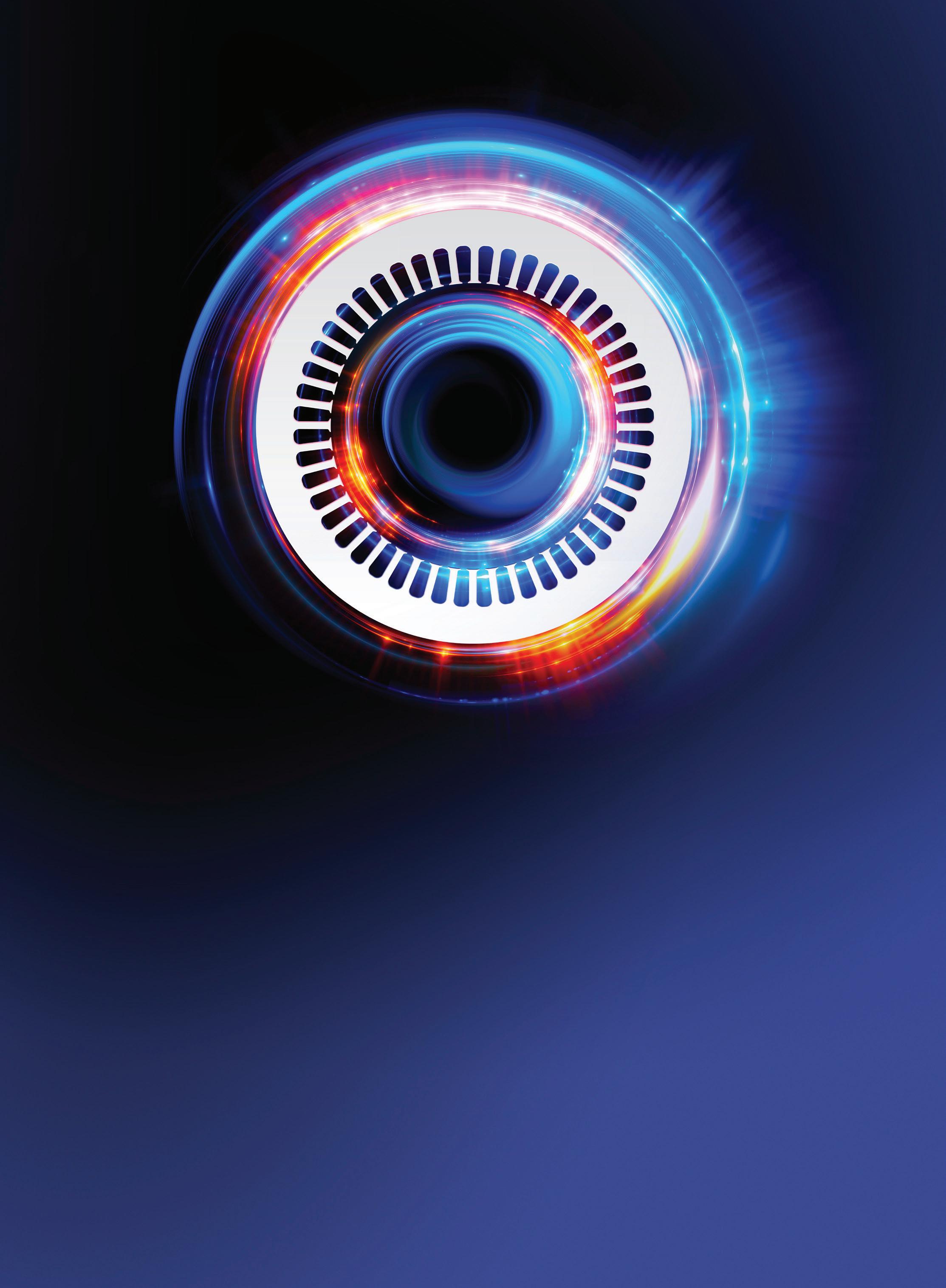




















































































































































































































































































































































































































































































































































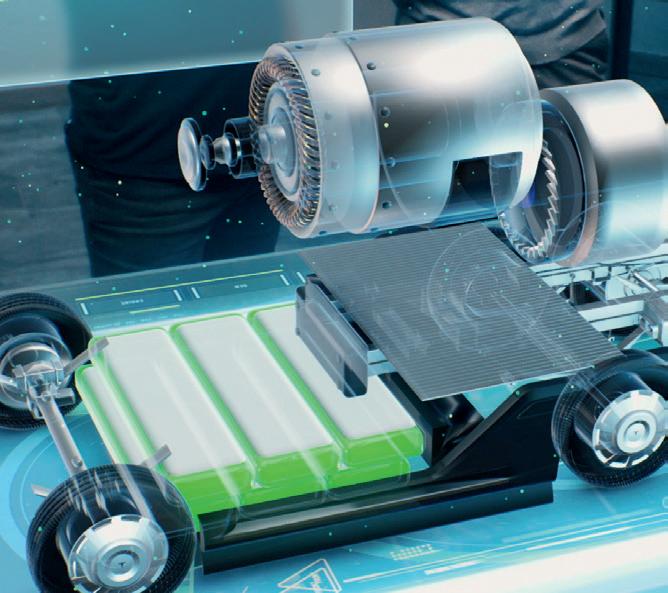

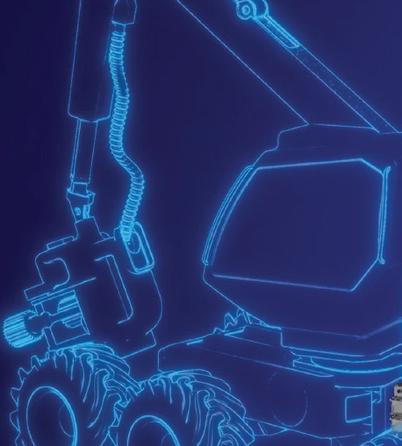



Avery Dennison introduces new EV battery venting materials portfolio
SK On and Nissan announce North American EV battery production
Proventia debuts LFP-based battery packs for heavy machinery
Lithium Americas receives $250-million investment for US lithium project
LG Chem to produce precursor-free battery cathode materials
Flint Engineering launches new heat pipe technology
Renesas introduces low-power Bluetooth SoC for auto applications
dSPACE launches simulation software for power electronics
Electrovaya receives $51-million loan for US battery manufacturing
QinetiQ validates 80% manganese-rich LMFP cathode for Integrals Power
Scania introduces new e-machine, battery and charging options for buses
Ricardo develops electric propulsion motor with no rare earths or copper
Henkel launches silicone-free gel for ADAS thermal degradation protection

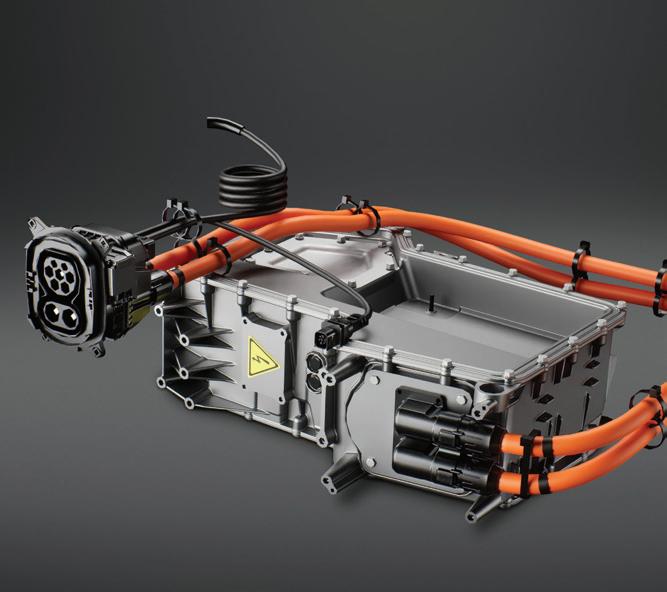
Danfoss introduces electric filter for high-power grid-connected machinery
LION Smart and hofer to bring novel immersion-cooled batteries to market
Rivian opens sales of its commercial van to all US fleets
Virgin Atlantic and Joby plan to launch UK air taxi service
Trova CEO talks about company’s first-ever electric terminal truck


Tradelink Transport buys 14 Volvo VNR Electric semis for drayage operations
Siemens receives first order for Vectron locomotives with battery module
Tadano debuts 100-ton rough-terrain electric crane
Orange EV introduces 7.5-year warranty for its electric terminal trucks
Arriva Shipping expands its fleet with hybrid dry cargo vessel
Nsight Fleet platform enables fleets to electrify refrigerated trailers
Daimler Truck’s RIZON brand begins Canadian deliveries of electric trucks
Mallaghan CT6000E electric catering truck debuts at Boston Logan Airport
Volvo CE reveals A30 Electric articulated hauler
Elgo-Plus introduces new compact electric mini-digger
JFK Airport to deploy a fleet of all-electric ground service equipment
Kia EV9 now available with Wallbox Quasar 2 bidirectional charger
Lucid Motors buys Nikola’s Arizona factory at bankruptcy auction
Electra announces $9 billion in preorders for new hybrid electric aircraft
Swiss transport and waste disposal company buys a FUSO electric truck


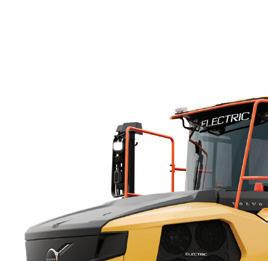





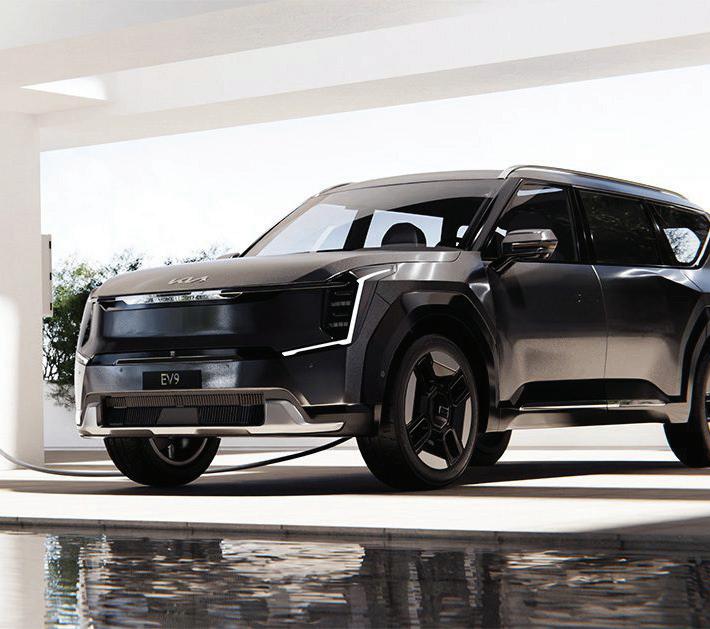

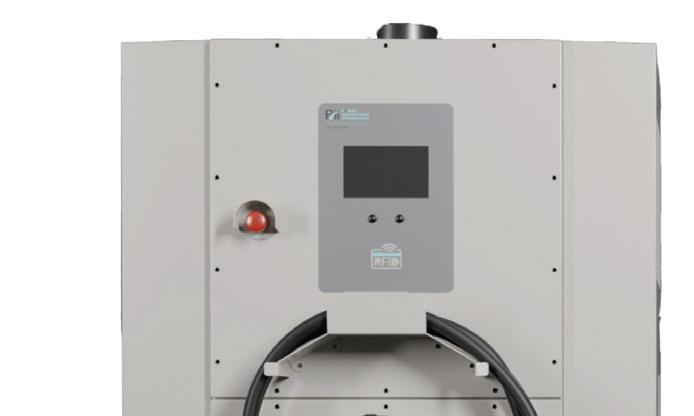






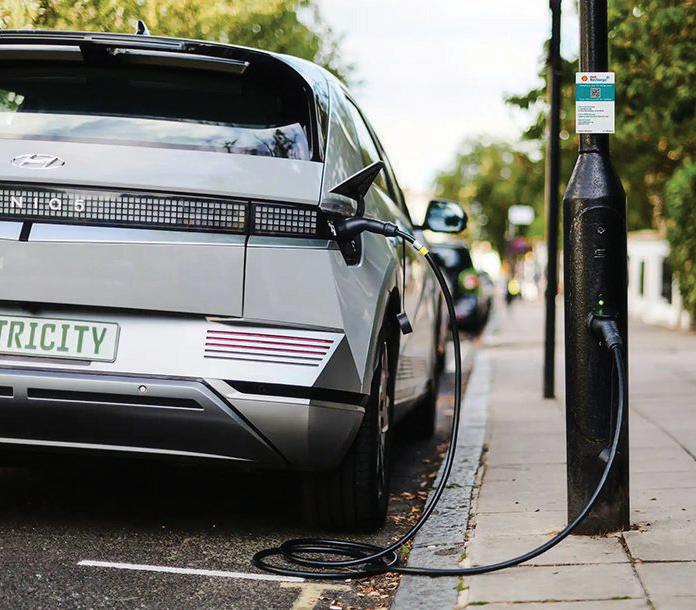

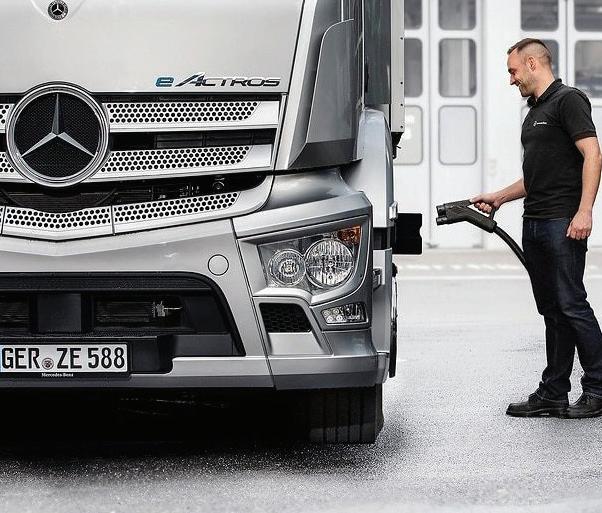




Pii’s new line of DC fast chargers can accept a wide range of input voltages
Rideshare/EV charging provider Revel expands to the West Coast
First Student to use Ampcontrol’s charging platform for its school buses
Kempower’s new EV charging station features CCS and NACS connectors
DG Matrix to commercialize its multi-port solid-state transformer solutions
KD Group acquires EV charging and energy management firm Etrel
FTI’s new above-ground cable routing product streamlines charger installation
Canada Infrastructure Bank and Jolt to install 1,500 curbside charging stations
ElectricFish’s microgrid charging solution installs quickly, cuts grid costs
California Energy Commission to launch $55-million charging station funding
ENAPI raises 7.5 million euros for its EV charging connectivity platform
Felten introduces Charge Qube mobile EV charging solution for remote sites
XCharge partners with Orlando Utilities Commission for EV charging research
Birmingham UK partners with ubitricity for on-street charging point network
RMI report finds rideshare drivers prefer to charge their EVs at home
Greenlane and Volvo partner to offer charging for heavy-duty electric trucks
Daimler Truck to launch semi-public European charging network
Delta unveils DC Wallbox EV charger for public charging
NovaCHARGE’s new mobile fast charger is designed for demanding conditions
Publisher Senior Editor
Technology Editor
Segment Leaders
Christian Ruoff
Charles Morris
Jeffrey Jenkins
Joel Franke
Mark Rogers
Greg Schulz
Graphic Designers
Tomislav Vrdoljak
Contributing Writers
Jeffrey Jenkins
Charles Morris
Christian Ruoff
Jonathan Spira
John Voelcker
Cover Image Courtesy of
Hyundai Motor America
For Letters to the Editor, Article Submissions, & Advertising Inquiries Contact: Info@ChargedEVs.com
Special Thanks to
Kelly Ruoff
Sebastien Bourgeois
ETHICS STATEMENT AND COVERAGE POLICY
AS THE LEADING EV INDUSTRY PUBLICATION, CHARGED ELECTRIC VEHICLES MAGAZINE OFTEN COVERS, AND ACCEPTS CONTRIBUTIONS FROM, COMPANIES THAT ADVERTISE IN OUR MEDIA PORTFOLIO. HOWEVER, THE CONTENT WE CHOOSE TO PUBLISH PASSES ONLY TWO TESTS: (1) TO THE BEST OF OUR KNOWLEDGE THE INFORMATION IS ACCURATE, AND (2) IT MEETS THE INTERESTS OF OUR READERSHIP. WE DO NOT ACCEPT PAYMENT FOR EDITORIAL CONTENT, AND THE OPINIONS EXPRESSED BY OUR EDITORS AND WRITERS ARE IN NO WAY AFFECTED BY A COMPANY’S PAST, CURRENT, OR POTENTIAL ADVERTISEMENTS. FURTHERMORE, WE OFTEN ACCEPT ARTICLES AUTHORED BY “INDUSTRY INSIDERS,” IN WHICH CASE THE AUTHOR’S CURRENT EMPLOYMENT, OR RELATIONSHIP TO THE EV INDUSTRY, IS CLEARLY CITED. IF YOU DISAGREE WITH ANY OPINION EXPRESSED IN THE CHARGED MEDIA PORTFOLIO AND/OR WISH TO WRITE ABOUT YOUR PARTICULAR VIEW OF THE INDUSTRY, PLEASE CONTACT US AT CONTENT@CHARGEDEVS.COM. REPRINTING IN WHOLE OR PART IS FORBIDDEN EXPECT BY PERMISSION OF CHARGED ELECTRIC VEHICLES MAGAZINE.
• Developed for Sintering of Power Modules to Cooler
• Precise Pressure Control
• Accurate Temperature Regulation
• Perfect Atmosphere Control
• Fully Automated Production
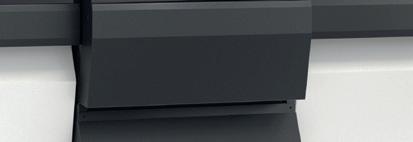
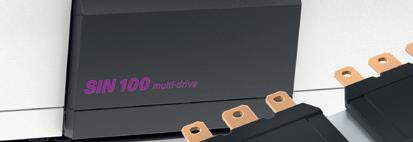






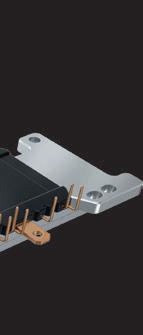


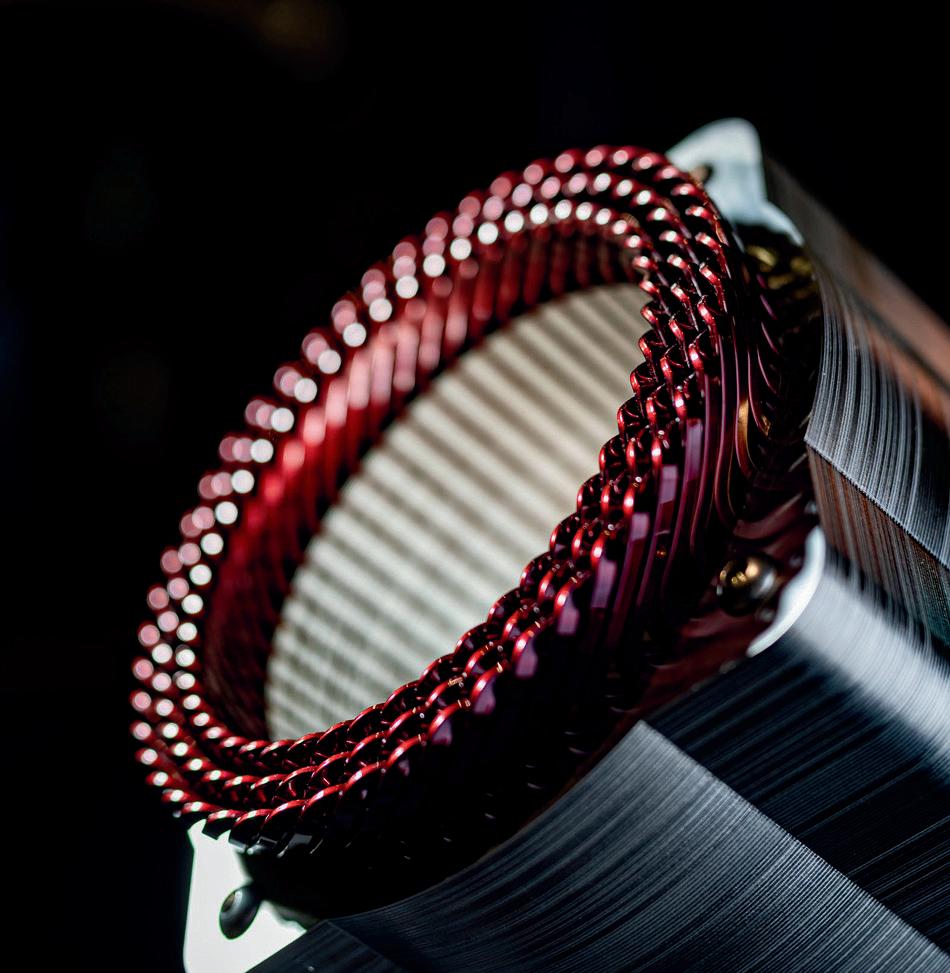







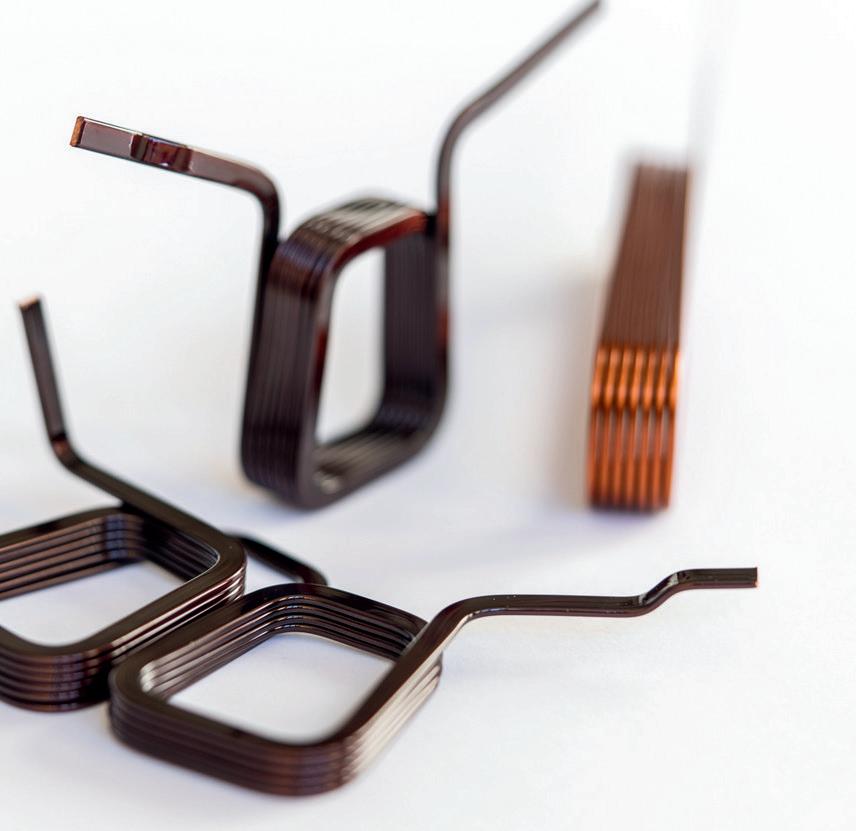








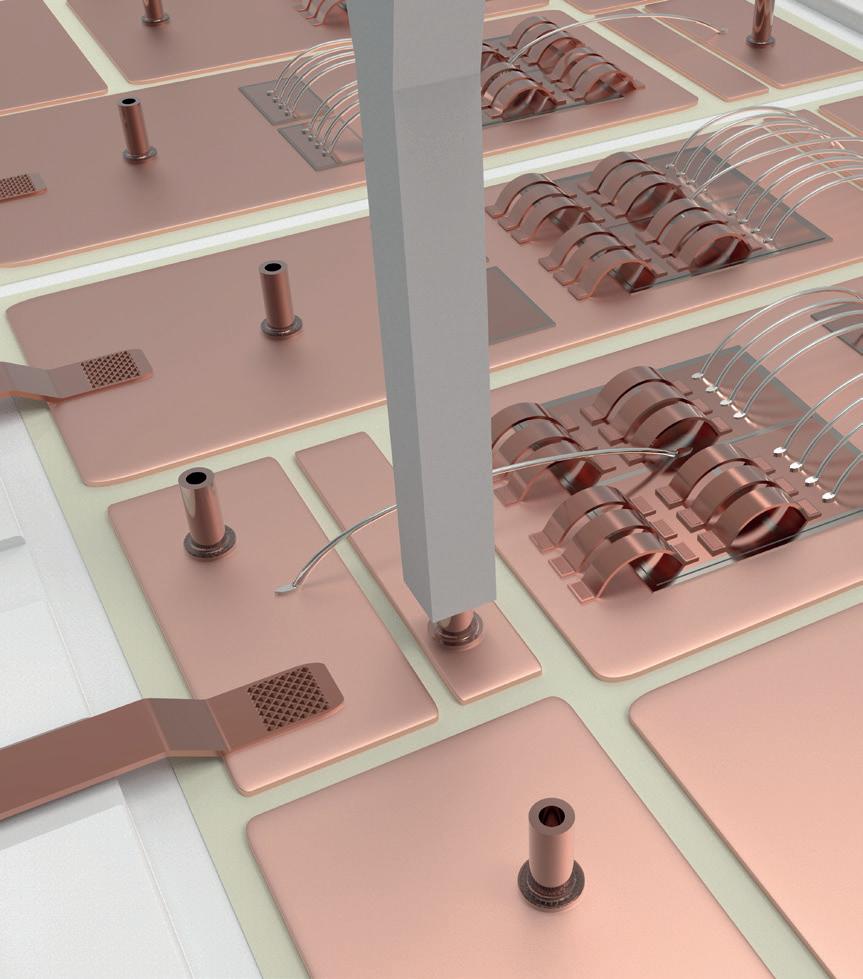
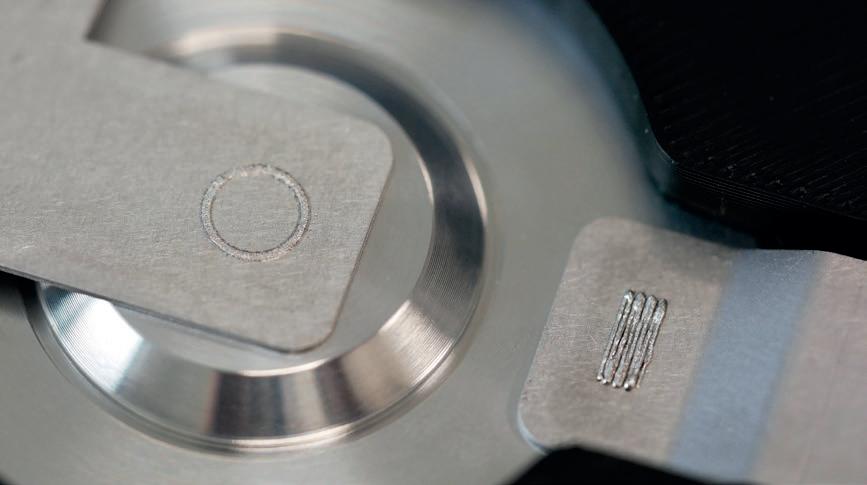




Many fear (and some hope) that the new world order will cripple or kill the EV industry, but we just don’t see it happening. If you could see our inboxes here at Charged, you’d be impressed with the ongoing explosion of innovation and entrepreneurship, which has so far shown no sign of slowing down.
We’ve been asking every EV industry exec we talk to about the new political climate, and while some are adapting their strategies (for example, electric truck maker Harbinger now guarantees its customers that, if tax credits for EVs are eliminated, the company will cover the price di erence), but none are planning to shut their shops and go home.
On the contrary, we’re seeing steady progress in all the areas of the EV industry that we cover, and some truly amazing developments coming in the near future.
e Tech: If even half of the developing technologies the engineers have been telling us about make it to commercialization, we’re going to be driving some spectacular vehicles in a few years. Sulfur-based batteries (Zeta Energy) could deliver huge reductions in price and environmental impact, and graphite made from forestry by-products (CarbonScape) could make supply chain woes a thing of the past. e shi from 12-volt to 48-volt electrical systems promises to reduce vehicle weight and cost, and enable exciting new features (see our feature article on TE Connectivity on page 32).
e Infrastructure: CPOs are tackling the reliability issues headon (ChargerHelp, FLO), while EVSE manufacturers build evermore-powerful hardware with new features designed to alleviate utility and supply chain bottlenecks (see our feature article on Power Innovations International on page 74).
e Vehicles are selling in record numbers and pushing into new markets. While OEMs continue to incrementally improve performance, the focus seems to have shi ed from increasing range (250 miles seems to be considered quite adequate) to expanding lineups to include more vehicle classes (more SUVs and pickups are in the pipeline), and more variants (read John Voelcker’s review of new “o -road” models from Hyundai and Ford, on page 48).
Meanwhile, as was obvious to anyone who attended the recent bauma show in Munich, o -road vehicles are electrifying at an impressive pace. Charged correspondent Greg Schulz was on-site in Germany to chronicle the rapid growth of electri ed technology in construction, mining and other heavy-duty machinery. Check out his coverage of o -highway EVs on our site: www.ChargedEVs.com.
Christian Ruoff | Publisher EVs are here. Try to keep up.










Avery Dennison Performance Tapes has introduced a new EV Battery Venting Materials Portfolio to help counter the risk of thermal runaway and increase safety in EV batteries. ese venting solutions include singleand double-coated anisotropic lmic tapes with proprietary re-barrier coatings and pressure-sensitive adhesives (PSA) for bonding.
EV battery manufacturers implement venting strategies at the cell, module and pack levels. e Avery Dennison battery venting tape solutions, when applied to module- or pack-level venting holes, provide quick burnthrough to facilitate venting via a channel. e opposite side provides extended ame resistance to prevent the migration of ames and hot gases into adjacent cells. e outer side of the lm will last less than 4 seconds under ame. e adhesive side will last longer than 15 seconds.
e combined ame retardancy is designed to counter the risk of thermal runaway.
“Our new venting solutions are engineered to provide di erential performance to ame exposure, which can lead to very elegant emergency venting strategies,” said Max Van Raaphorst, Business Development Manager, eMobility, Automotive & Energy Storage, Avery Dennison Performance Tapes North America. “ ese unique tapes can be combined with a wide range of other thermal runaway mitigation materials to lead to ecient, space saving designs. As always, our goal is to help make EV battery packs more safe, e cient and easier to assemble.”
Global battery manufacturer SK On and Nissan have announced a new battery supply agreement that will support Nissan’s EV production in North America.
Under the agreement, SK On will supply nearly 100 GWh of high-nickel batteries to Nissan from 2028 to 2033. ese US-manufactured batteries will power Nissan’s next-generation EVs to be produced at its Canton, Mississippi assembly plant.
is production is expected to support 1,700 US jobs at SK On, and will involve a total investment of $661 million, including equipment purchases, in addition to Nissan’s $500 million in investments for EV production at the Canton Assembly Plant.
e partnership marks SK On’s rst supply agreement with a Japanese automaker. SK On, a subsidiary of South Korea’s SK Group, currently operates two battery plants in the US, and is building four additional plants with partners. Once fully operational, SK On’s annual US production capacity is expected to exceed 180 GWh.
“ is agreement underscores the strength of our battery technology and our growing presence in the North American market,” said Seok-hee Lee, SK On President and CEO. “Leveraging our production footprint and expertise, we are committed to supporting Nissan’s electri cation strategy.”
Nissan has announced plans to launch 16 new electried vehicle models over the next three years, including all-new EVs from its Canton assembly plant starting in 2028.
“ is agreement with SK On is a signi cant milestone for Nissan’s electri cation journey and supports further investment in US manufacturing,” said Christian Meunier, Chairman, Nissan Americas. “ rough this smart partnership with SK On, we can leverage their growing US production capacity to deliver innovative, high-quality electric vehicles.”
After acquiring the Italian Sovema Group, ANDRITZ Schuler is gradually establishing itself as a system supplier in the field of battery production. The first successful large-scale projects show that the strategy is working.
ANDRITZ Schuler reached an important milestone in its role as a supplier for gigafactories with the construction of a formation line for a prominent German battery cell manufacturer. Scheduled to begin production in May 2025, this line will produce around 80 cylindrical lithium-ion cells per minute. Beyond planning, manufacturing, and assembly, ANDRITZ Schuler oversees intralogistics, steel construction, and digital solutions, including track-and-trace functionality.
This recent expansion into battery cell assembly and formation aligns with a strategic initiative by ANDRITZ Schuler’s parent company, the ANDRITZ Group. With seven targeted growth projects, the aim is to support battery manufacturers in producing competitive batteries in Europe and America. The first major step in this strategy was the acquisition of Italy’s Sovema Group in August 2022.
Sovema has a decade-long reputation in lithium-ion battery systems for pilot and laboratory settings, in addition to its global leadership in turnkey systems for mass-producing lead-acid batteries. Its U.S. subsidiary, Bitrode, further complements this expertise with equipment and specialized knowledge in battery testing of cells, modules, and packs.
Integrating Sovema’s capabilities, ANDRITZ Schuler now covers the complete production process for battery cells, including notching, stacking, housing component manufacturing, electrolyte filling, formation, aging, and sealing. ANDRITZ Schuler’s existing technological strength in battery cell housing production, initiated in 2015, further enhances its capabilities. Recently, ANDRITZ Schuler delivered four fully automated production lines for cylindrical cell housings to renowned automotive companies in Germany and the USA. Another production line for prismatic housings was delivered to Hungary, operating at 100 housings per minute.
Additional expertise from within the ANDRITZ Group significantly boosts ANDRITZ Schuler’s competitive position. ANDRITZ

has been manufacturing centrifuges for lithium mining since the 1960s and provides essential filter and drying systems for cathode material powder processing. The group also has substantial knowledge in calendering processes and battery recycling, specifically in dismantling, deep discharge, and recycling, critical as electric vehicle waste increases.
In November 2022, ANDRITZ Schuler secured an order from the Fraunhofer Research Institution for Battery Cell Manufacturing FFB in Münster, Germany, to design a cell assembly line for large-format pouch cells. Another significant ongoing project involves constructing a pilot assembly line for advanced solid-state battery cells for a major German automotive manufacturer. Solid-state batteries offer substantial benefits, including enhanced safety, higher energy density, extended vehicle range, and shorter charging times. The turnkey facility for this project is also due for completion in May 2025.
Ray Xin Wang, Head of ANDRITZ Schuler’s Battery Giga Projects unit, addressed the current market slowdown, noting a period of disillusionment in battery market expectations based on present electric car sales figures. However, he predicts renewed demand growth and emphasized that ANDRITZ Schuler is leveraging this period to refine products tailored specifically for gigafactory demands.
Regarding competition from the Far East, ANDRITZ Schuler emphasizes innovation, quality, and efficiency. According to Wang, Schuler’s competitive edge includes advanced plant technology tailored for high-volume production. He highlights quality reflected in lower rejection rates, significant energy efficiency of nearly 90% through advanced formation electronics, and optimized plant footprints reducing operational costs.
Finally, Wang stresses the strategic advantage of ANDRITZ Schuler’s local European service model, offering assembly, onsite setup, and reliable after-sales support, ensuring continued productivity and availability for European battery manufacturers.



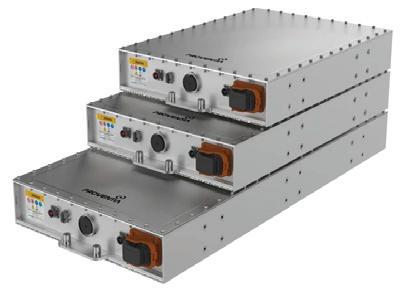


Proventia, a supplier of emission control systems, thermal insulation components and batteries, has introduced its new Proventia Energy LFP-based battery pack.
Lithium iron phosphate (LFP) technology is a good option for heavy machinery due to its cost e ciency and long lifespan, the company said. e high-energy, high-voltage battery systems are suitable for continuous operation over extended periods.
“ e bene ts of this new product are remarkable, from exceptional engineering to high-quality European origins,” the company said, referring to its use of cells from Morrow Batteries, a Norwegian cell producer.
Proventia explained that the LFP chemistry inside the battery pack “delivers consistent energy,” making it well-suited to applications such as heavy work machines, wheel loaders and tractors, among others. It can be incorporated within either an electric installation or a hybrid installation.
In addition, the Proventia Energy battery pack supports more cycles, over 6,500 charges, and operates throughout a wider temperature range, -20° C to +55° C, than the company’s lithium titanate oxide (LTO) batteries. e LFP battery packs can utilize the full capacity of the battery, Proventia said.
e LFP technology in Proventia Energy battery packs is also more environmentally friendly than LTO technology, the Finnish company said, because it does not contain nickel, cobalt or manganese.

Lithium Americas has received a strategic investment of $250 million from funds managed by Orion Resource Partners, a global investment rm focused on metal and materials projects, for the development and construction of Phase 1 of the acker Pass lithium project in Humboldt County, Nevada. e target for completion of acker Pass Phase 1 is late 2027.
Orion has entered a production payment agreement in which it will pay Lithium Americas $25 million in exchange for payments corresponding to the minerals processed and gross revenue generated by acker Pass.
In addition, Orion has signed a non-binding agreement to evaluate the potential to support up to $500 million of nancing for the construction and development of Phase 2 of the project.
Lithium Americas expects that the investment will satisfy all remaining equity capital fundraising requirements under a previously-announced $2.26-billion DOE loan. e investment positions the company to be fully funded for the duration of construction. It expects to start drawing on the DOE loan during the third quarter of 2025.
“Orion is excited to make this strategic investment in Lithium Americas to support the development of a domestic lithium supply chain to meet the rising demand across industries,” said Oskar Lewnowski, Orion’s founder and Group CEO.




Battery manufacturer LG Chem plans to start mass production of precursor-free battery cathode materials in South Korea in the rst half of this year.
LG Chem produces its LG Precursor Free (LPF) materials by directly calcinating custom-designed metals without precursors, improving power performance at low temperatures and shortening development time.
e company plans to expand LPF technology applications across new products, providing customers with di erentiated, customized options.
LG Chem is also introducing next-generation materials, including safety solutions like Nexul (aerogel thermal barrier), ame barrier foams and ame barrier sheets, which prevent or delay res and limit thermal propagation in batteries. It also produces cables and housings for EV chargers and cathode materials for dry electrode and solid-state batteries.
“We will actively target the future market with next-generation innovative materials for batteries, such as LPF cathode materials and safety solutions,” said Shin Hak-Cheol, CEO of LG Chem.
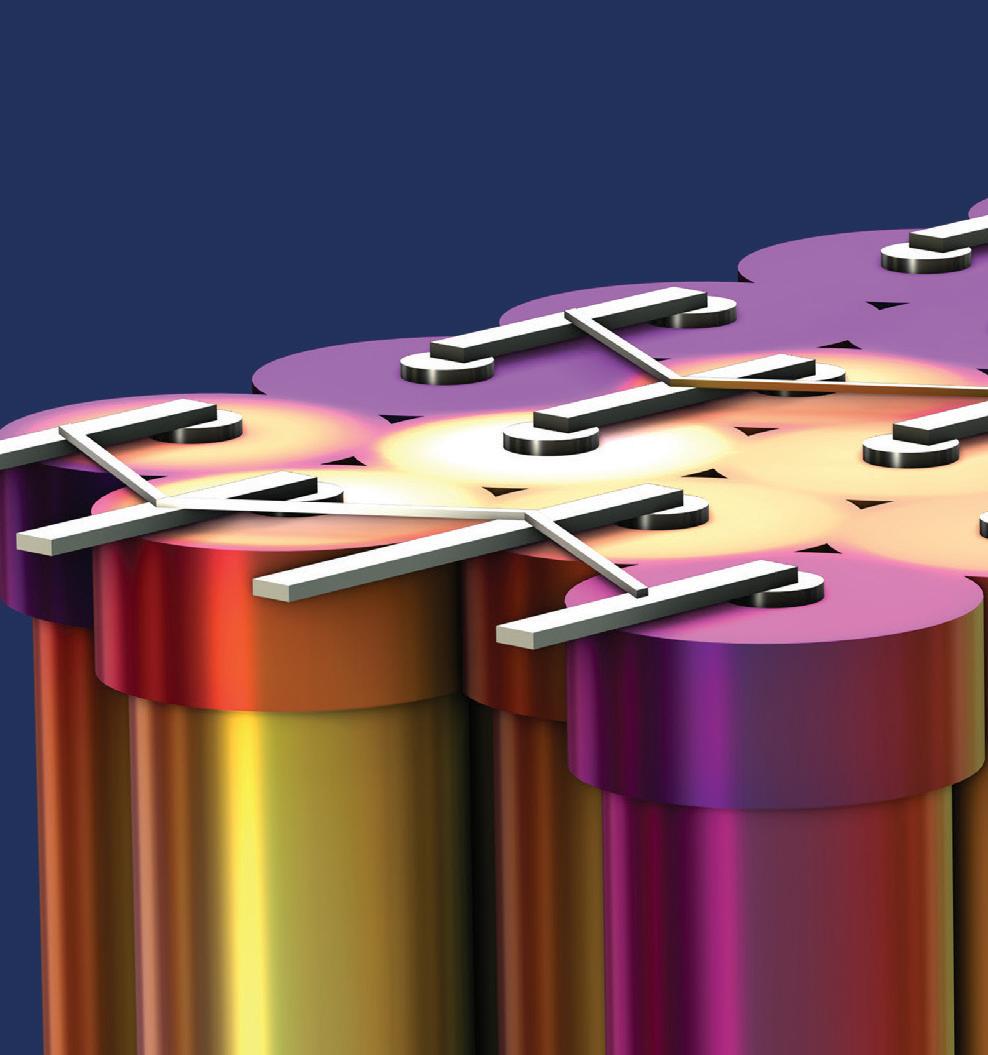


Multiphysics simulation helps in the development of innovative battery technology by providing insight into mechanisms that impact battery operation, safety, and durability. The ability to run virtual experiments based on multiphysics models, from the detailed cell structure to battery pack scale, helps you make accurate predictions of real-world battery performance.
» comsol.com/feature/battery-design-innovation

UK-based technology startup Flint Engineering has unveiled IsoMat, which aims to reinvent traditional heat pipe technology through a at aluminum sheet design, featuring an internal network of sealed channels.
When exposed to temperature di erentials, the liquid within the channels undergoes a rapid cycle of evaporation and condensation, resulting in near-instantaneous heat transfer across the entire surface. is enables thermal energy transfer approximately 5,000 times more e ciently than copper or aluminum alone, according to the company.
When incorporated into battery pack casings, IsoMat distributes thermal energy evenly, maintaining batteries at an optimal 25° C (±1° C).
“We’re seeing unprecedented interest across the construction, electri cation and refrigeration sectors—yet these industries represent just a snapshot of the potential for this game-changing innovation. Commercial deployment is scheduled for this year, and we’re preparing to engage with venture capital communities. We’re actively seeking partnerships and welcome ideas from companies across all sectors,” said Mark Robinson, CEO of Flint Engineering.
Renesas has introduced a new automotive-quali ed Bluetooth chip that combines a radio transceiver, an Arm M0+ microcontroller, memory, peripherals and security features in a compact system-on-chip (SoC) design.
e DA14533, the rst device in the company’s Bluetooth Low Energy SoC range quali ed for automotive applications, includes advanced power management features to simplify system integration and reduce power consumption.
e SoC can operate in an extended temperature range from -40° C to 105° C, allowing developers to incorporate it into applications from tire pressure monitoring and keyless entry to wireless sensors and battery management systems. Quali ed against Bluetooth Core 5.3 speci cations, the device also contains security features to safeguard connected devices from various threats.
e DA14533 includes an integrated DC-DC buck converter, which accurately adjusts the output voltage according to system requirements. According to the company, active system power consumption is lower than that of comparable devices in the market, requiring only 3.1 mA during transmission and 2.5 mA during reception. In hibernation mode, the current drops to 500 nA. is helps extend the operational life of small-capacity battery-powered systems and meets the stringent power requirements of tire pressure monitoring systems. A single external crystal oscillator (XTAL) is used for active and sleep modes, eliminating the need for a separate oscillator for sleep mode. e SoC is available in a compact WFFCQFN 22-pin 3.5 x 3.5 mm package and o ers a low engineering bill of materials, integrating into space-constrained systems, reducing overall system costs and accelerating time to market.
e DA14533 is now available along with a Bluetooth Low Energy SoC Development Kit Pro. e kit includes a motherboard, a daughterboard and cables to facilitate application so ware development. e daughterboard is also available by itself to simplify development.




Germany-based dSPACE, a provider of automotive simulation and validation solutions, has released its XSG Power Electronics Systems so ware to support the simulation of highly dynamic switching frequencies of up to 500 kHz.
e so ware for hardware-in-the-loop tests contains a library with ready-to-use models of power electronics circuitry so that users can create their simulations quickly and easily.
XSG PES supports highly dynamic circuitry simulation based on wide-bandgap semiconductors such as silicon carbide (SiC) and gallium nitride (GaN), enables fault simulation in semiconductors and circuitry, making it possible to generate easily reproducible results and to test thermal overload or arcing without risk.

“With XSG Power Electronics Systems, we support the development of the most advanced power converters, which are becoming ever smaller, faster and more powerful,” said Julian Saele, Product Manager E-Mobility at dSPACE.




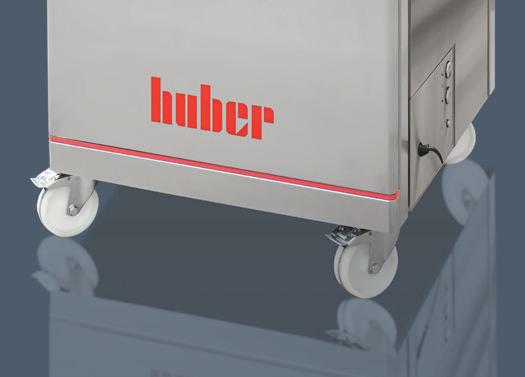


Lithium-ion battery systems manufacturer Electrovaya has closed a loan of $50.8 million with the Export-Import Bank of the United States to expand its battery-manufacturing capabilities.
e company plans to expand its facility in Jamestown, New York, using the funds. Jamestown’s history as a thriving industrial area in the 20th century is well known, as is its connection to the legendary comedienne Lucille Ball, who was born there in 1911.
Electrovaya plans to manufacture its In nity lithium-ion ceramic cells, which it says o er “industry-leading longevity and safety,” in Jamestown. e battery facility will add approximately 250 jobs to the area, and the company will export its products to Canada, Japan and Australia.
e loan calls for using $46.4 million for lithium-ion cell, module and battery pack manufacturing and $5.3 million for construction and engineering, the company said.
e In nity line of cells, according to Electrovaya, is made using unique ceramic composite cell separator materials that provide the safest cathode combination of nickel-manganese-cobalt. e company promises “extraordinary safety characteristics achieved through a thermally stable full ceramic separator.”
e combination of the EXIM funding with the company’s $20-million BMO credit facility and $12 million in equity capital from December 2024 gives Electrovaya over $80 million at its disposal to fuel its expansion in New York.
Testing by UK defense technology company QinetiQ indicates that lithium manganese iron phosphate (LMFP) cathode active material developed by UK battery materials producer Integrals Power could increase EV range by extending the useable capacity of the battery under high discharge conditions.
Conventional lithium iron phosphate (LFP) chemistries experience a reduction in useable capacity when the battery is operated at in high-discharge conditions, such as prolonged periods of highway driving or in high-power applications such as electric mining vehicles. QinetiQ’s testing demonstrated that the LMFP cells retain a higher percentage of their nominal capacity than LFP under these conditions.
QinetiQ manufactured and tested prototype LMFP pouch cells using the new material and standard commercial-grade graphite anodes and liquid electrolyte that retained 99% of their original capacity at 2 C (30 minutes discharge time), and 95% at 5 C (12 minutes discharge time). Even at 10 C capacity retention was 60%. Each cell was tested at an electrode loading of 2 mAh/cm2
QinetiQ’s assessments follow other third-party testing last year that showed Integrals Power had achieved the breakthrough of incorporating a manganese content of 80% and delivering nearly 150 mAh/g speci c capacity, while overcoming the reduction in energy density that typically occurs at such high levels.
e LMFP used in the tests is one of 25 cathode active materials that Integrals Power is developing at its UK facility, which includes a pilot plant capable of producing 20 tonnes a year from high-purity raw materials rather than bulk precursors.
“Together with the proven energy density improvements of up to 20% compared to LFP unlocked by our 80% manganese content and higher voltage pro le of 4.1 V, we are able to demonstrate to our customers around the world that we can enable signi cant cost and weight reductions, and more compact, more sustainable and longer-lasting battery pack designs,” said Integrals Power founder and CEO Behnam Hormozi.




Electric bus OEM Scania has introduced several innovations to its battery-electric bus platform.
e company’s new e-machine now o ers four power options, as well as an integrated two- or fourspeed gearbox. An additional battery option has been added, and a new charging interface at the rear of the bus is designed to deliver faster charging.
Scania’s e-machine is an integrated compact drive device, consisting of electric motor, inverter, gearbox and oil system. e oil system includes two oil pumps, which cool the e-machine and lubricate the gearbox.


e new e-machine has several power options to choose from, in order to suit various operating conditions, giving it more exibility than the previous single power option. e customer can now choose among four di erent power options: 240 kW, 270 kW, 300 kW and 330 kW. e twoor four-speed gearbox improves the energy e ciency of the bus as well as its startability and acceleration, allowing it to move o smoothly and e ciently even under challenging conditions such as hills or heavy-duty operations.
Scania is also introducing a three-battery-pack option with 312 kWh of installed energy, as well as a second charging interface at the rear of its buses. e rear interface delivers charging power of up to 325 kW at up to 500 A, signi cantly higher than the current front charging position’s 130 kW and 200 A.
“We know that bus operators face the push-pull e ect of responding to emission regulations while striving to meet the speci c demands of electric operations. Power needs, exibility, charging time, energy e ciency and operational range are some of the key factors,” says Anna Ställberg, Head of Urban Solutions for People Transport Solutions at Scania Group. “ e new e-machine, battery and charging options are being introduced with our customers’ challenges in mind.”
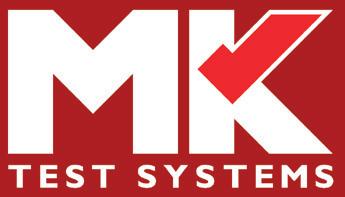
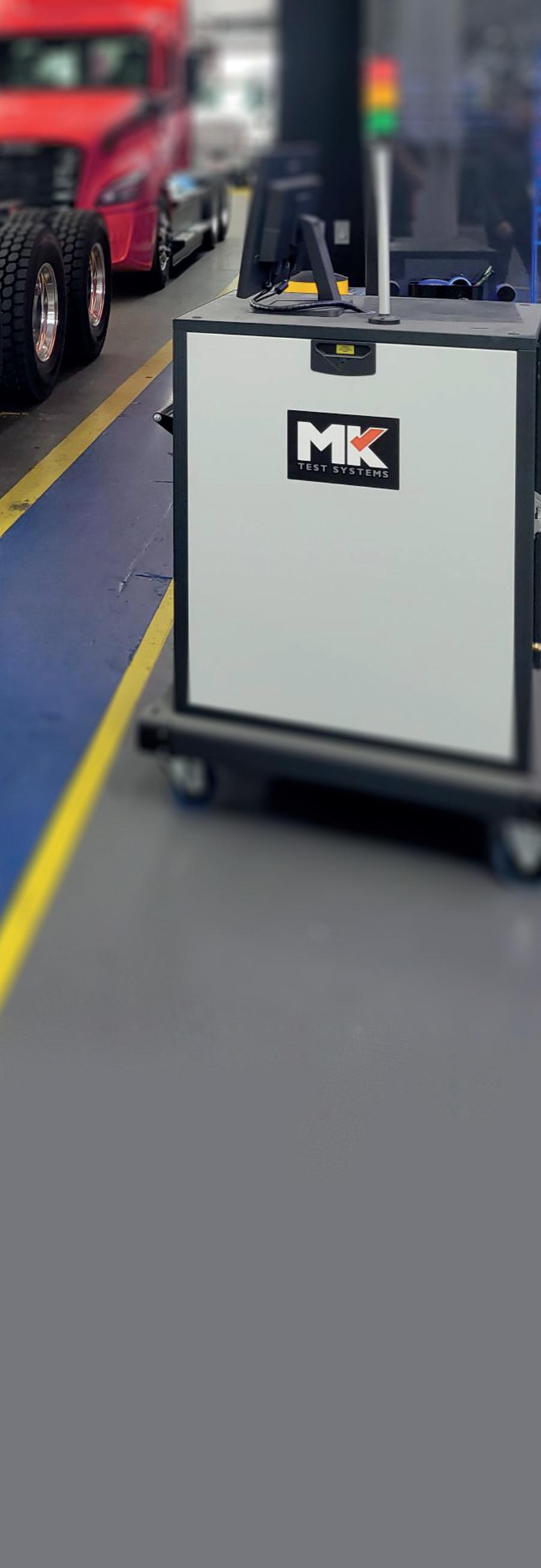

Engineering consulting company Ricardo has designed, developed and tested a prototype electric propulsion module, Alumotor, a synchronous reluctance motor that does not contain critical raw materials such as rare earths or cobalt.
Alumotor was delivered within Innovate UK’s funded consortium, led by Ricardo, which aims to address issues related to the environmental impact of materials for electric motors.
e motor uses aluminum hairpin windings, and the machine is oil-cooled to generate a power output of 214 kW and maximum e ciency greater than 92%, making it suitable for light commercial vehicles and o -highway applications. Full scalability also makes it suitable for other applications.
Dr Dragica Kostic-Perovic, Ricardo Chief Engineer responsible for the Alumotor project, said: “We are excited to be at the forefront of testing aluminum hairpin windings, and are achieving strong performance data that will support future go-to-market activities.”

Henkel has launched its Bergquist Liqui Form TLF 6500 CGel-SF, which provides heat dissipation for autonomous driving systems. By delivering a higher level of conductivity, the thermal curable gel is designed to prevent performance degradation and protect the sensitive ADAS domain controllers that enable real-time vehicle decision-making from heat degradation and damage. As ADAS systems process higher volumes of sensor and vehicle data at higher speeds, e ective heat management will become critical to ensure the performance, reliability and longevity of these components, the company said.
e silicone-free thermal management material has a conductivity of 6.5 W/(m·K) and is designed to provide reliability and easier handling. As a cured elastomer, it o ers ultra-low compression stress to protect fragile assemblies and sensitive electronic components. It lls air voids and irregular gaps to ensure even heat transfer across the surface and can be dispensed at high speed to match with just-in-time manufacture processing.
e gel avoids cracking or thermal failure during thermal cycling, extending component lifespan. It protects operators at the production line and avoids fogging issues for components with lenses such as cameras.




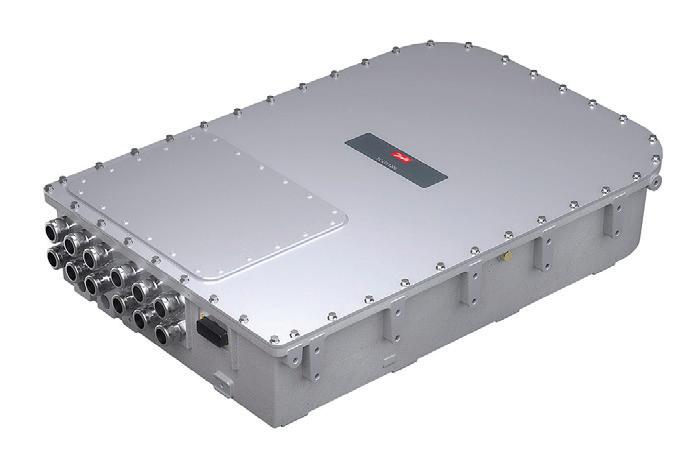
Danfoss Power Solutions has launched a new heavy-duty LCL electric lter speci cally designed for o -highway applications. e Editron EC-LCL1200B electric lter is a compact yet robust mobile-grade solution for fully electric, high-power machinery that pulls power from the AC grid rather than batteries. Applications include drilling equipment, material handling equipment, grid-connected excavators and other tethered electric machinery. e LCL1200B lter is designed to be used with the EC-C1200-450-L electric converter. Together the two components create a grid connection. e EC-C1200 converts AC power from the grid to provide DC power for the machine, while the LCL1200B lter reduces electromagnetic interference, improving power quality and maintaining system reliability. e combination of components is bidirectional, so it can both take power from the grid and feed power back to the grid.
e LCL1200B electric lter is designed for machinery operating in demanding o -highway environments. Its robust design withstands high levels of mechanical vibration and shock, and its ingress protection ratings of IP6K9K and IP67 provide protection from moisture and dust. Danfoss points out that electric lters designed for stationary applications require additional measures to provide the same level of protection in harsh conditions.
Rated for up to 560 volts AC and 50/60 Hz, the LCL1200B lter is compatible with European and US three-phase power supplies. All components are rated for 300 ARMS and 250 kVA. e lter is designed for operating altitudes of up to 4,000 meters.

LION Smart and hofer partner to bring novel immersioncooled batteries to market
LION Smart, a subsidiary of battery pack manufacturer LION E-Mobility, has entered into a strategic partnership with hofer powertrain. e two companies intend to develop and commercialize immersion-cooled battery systems with high market potential.
e two companies mean to combine their strengths to bring new battery systems to market maturity. hofer powertrain contributes expertise in the development, validation and rapid implementation of battery systems tailored to speci c customer requirements. LION Smart complements this with its immersion-cooled battery technology, which boasts high thermal stability, improved safety and increased power density compared to current battery designs.
LION E-Mobility has a current annual production capacity of 2 GWh, and operates highly automated module assembly lines at its own production facility in Germany.
“With hofer powertrain, we have a strong partner by our side that perfectly complements our innovative strength. Together, we are accelerating the market entry of our highly innovative high-performance batteries and delivering pioneering solutions for sustainable mobility,” says Joachim Damasky, CEO of LION E-Mobility.
“hofer powertrain stands for innovation, speed, and precision in the development and industrialization of sophisticated drivetrain systems,” adds Johann Paul Hofer, CEO of hofer powertrain. “ e partnership with LION Smart builds precisely on this and opens up new possibilities to transfer cutting-edge battery solutions into industrial applications.”

By Je rey Jenkins
raction motors and transformers are the magnetic components that seem to get all the attention, but the humble inductor/choke is just as critical a component in modern power converters, and it has surprisingly profound e ects on performance, reliability and cost. Another temptation for the bewildered design engineer (or one that is just short on time—but isn’t that all of us?) is that there are numerous inductors/chokes available COTS (Commercially O e Shelf), which is generally not the case for transformers, and choosing a COTS part isn’t necessarily a bad option—specialist suppliers o er very high-quality magnetic components, and possibly for much less than a bespoke component, even in production quantities. However, that doesn’t absolve the design engineer from verifying the suitability of a COTS component in a given application, as the last thing you want is for a component you barely vetted to become an occult source of ine ciency, unreliability, or


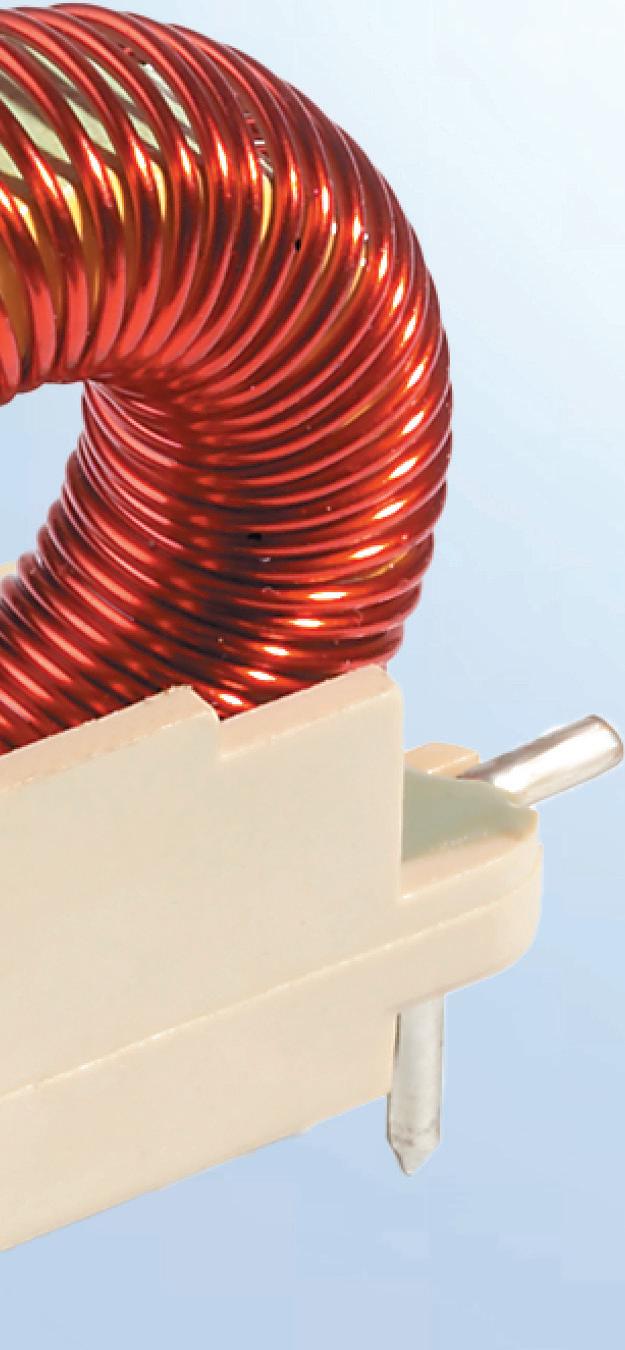



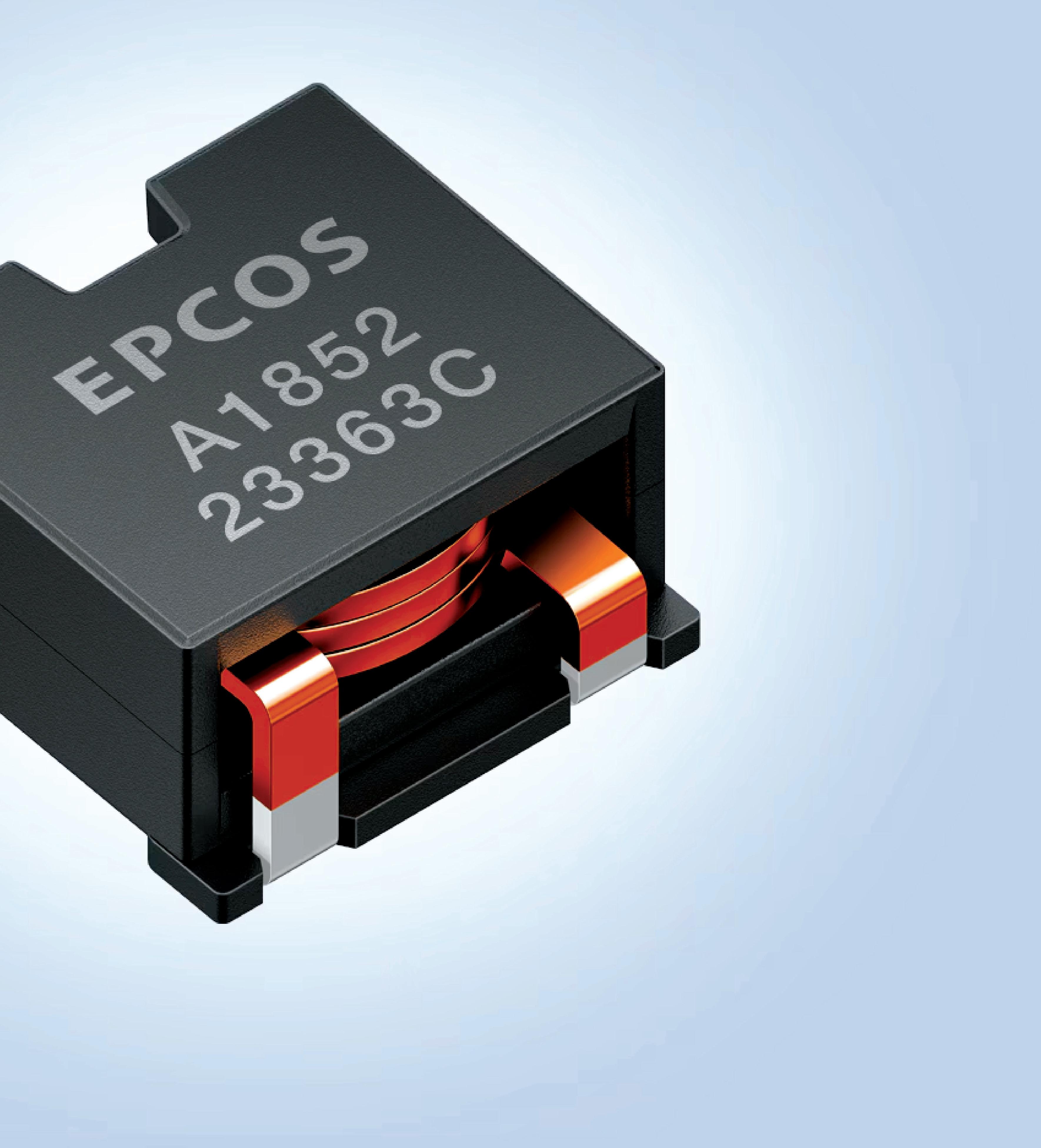
TDK’s SMD high current fl at wire indu ors
The humble inductor/choke is a critical component in modern power converters, and it has surprisingly profound effects on performance, reliability and cost.
that most dreaded of outcomes: to cause the device to fail Electromagnetic Compatibility Compliance (EMC) testing.
While a choke is technically a speci c type of inductor (one that can handle signi cant DC bias before fully saturating), the term is frequently abused (e.g. the “common mode choke” found in pretty much all AC mains lters never sees DC, so it is not a choke). erefore, it’s probably best to treat the terms inductor and choke as interchangeable. at said, inductors are broadly used for three major functions in EVs: in conventional low-pass LC lter networks for producing (reasonably) clean DC outputs in switchmode power converters; in tuned (aka resonant) LC networks, either in explicitly-resonant converter topologies, or just to reduce losses during the switching transitions in PWM topologies (aka quasi-resonant or so -switching); and in EMI lters for blocking the emission (or reception) of radio-frequency noise. ese applications place very di erent demands on inductors, hence the earlier admonition that just because you can get one COTS doesn’t necessarily mean it will work all that well in the speci c part of the circuit you’ve dropped it into. e vast majority of inductors used in power converters, regardless of topology, will have a ferromagnetic core—that is, not be a simple coil of wire— and most of the time that core will be in a shape such that the magnetic ux from the windings can follow a completely closed loop (a toroid is the classic example here). e latter feature might not be necessary for the functioning of the circuit, but it is key if you want to pass EMC compliance testing, because any ux lines that don’t escape the core are bound to cause noise issues elsewhere. For example, the now-ubiquitous drum-core SMT inductors that might look ideal for use in low-power auxiliary converters don’t have a closed magnetic loop—the ux lines must pass through air to complete their circuit—which can turn these little devils into miniature “EMI cannons” (an actual sobriquet I’ve heard used to describe them). Choosing a core
Sumida’s magnetically shielded, fl at wire 300-volt SMD power indu ors
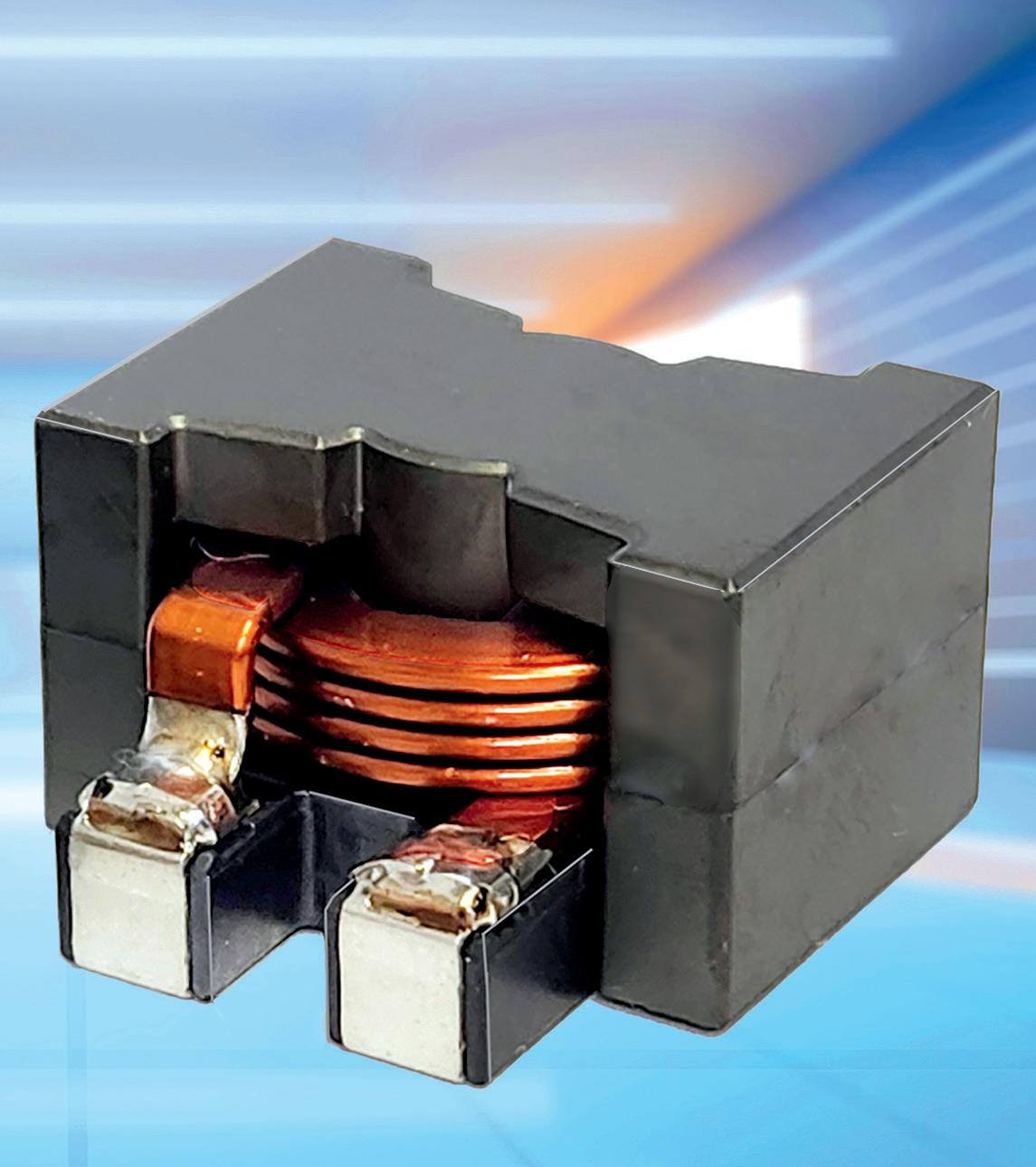
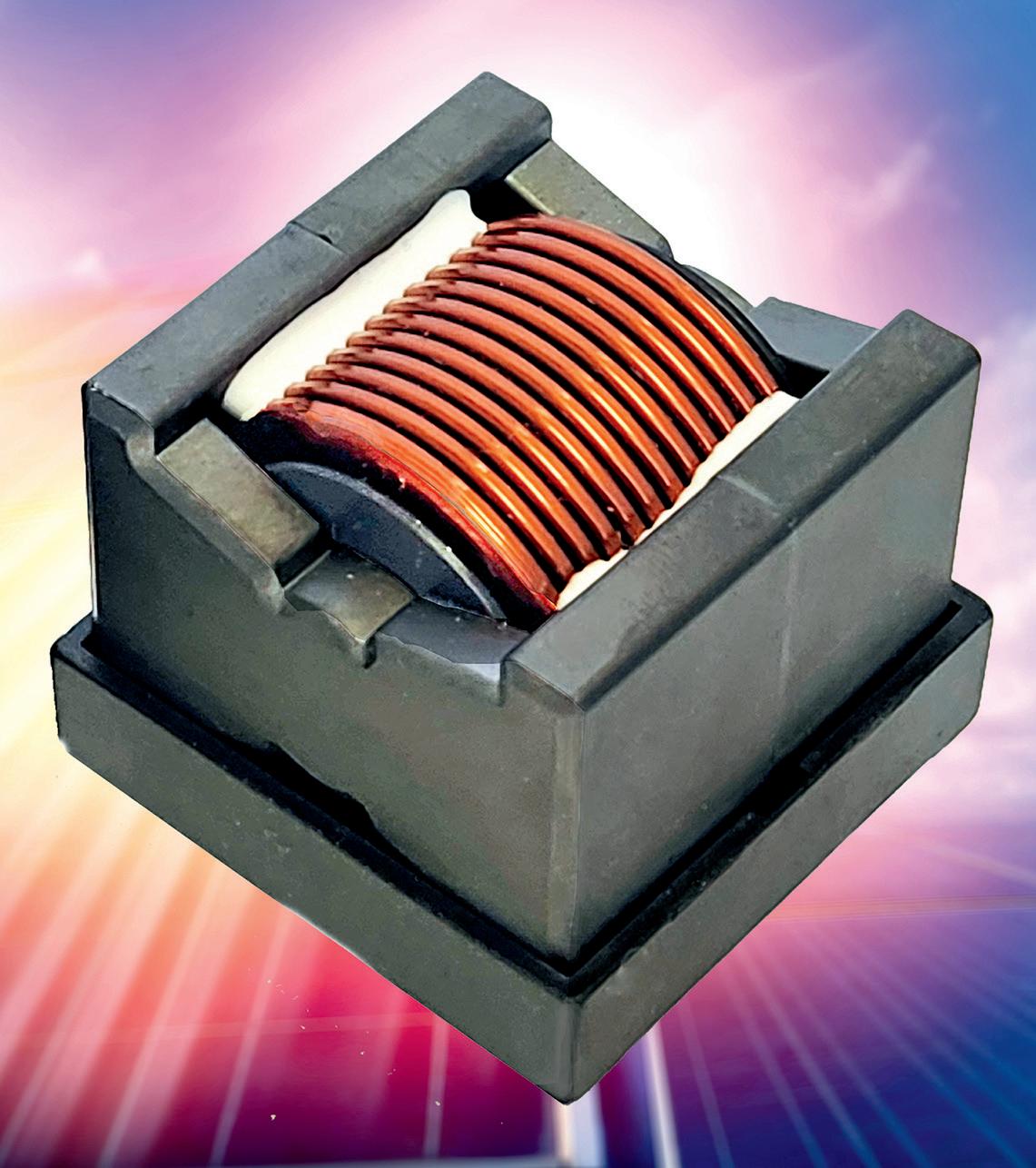
Sumida’s magnetically shielded 500-volt power indu ors
The edgewound flat wire construction is preferred at higher current ratings, especially at moderate switching frequencies under 150 kHz.
shape that closes the ux loop is only part of the battle, though, as other parameters and design goals are o en mutually exclusive, so compromise is inevitable. For example, core materials that are optimized for low AC losses (hysteresis and eddy) tend to have a lower saturation ux density, so will require more core area for a given inductance and power handling ability, which in turn increases the amount of stray capacitance, and so on. e main function of the series inductor in an LC output lter is to reduce the amount of AC ripple seen by the shunt capacitor that follows it without also being overwhelmed by the DC owing through it. is increases the importance of minimizing the DC losses of the windings over the AC losses of the same, and of the core. A single layer of conventional magnet wire (using

TDK’s automotive power-over-coax indu or
multiple strands in parallel if necessary to achieve the target current rating) will typically work well. Also possible (at the expense of higher stray capacitance) is the edgewound at wire construction—this type is preferred at higher current ratings, especially at moderate switching frequencies (under 150 kHz), though it tends to have a higher stray capacitance. As for the core itself, almost any “power material” will work here (as opposed to materials optimized for RF/tuned circuits or, worse,




EMI lters), as long as there is either an explicit or distributed air gap to prevent saturation from the DC bias. e gap is explicit (i.e. a literal gap) in ferrite cores, and cores with standard gap lengths are available COTS from most manufacturers, though there is little penalty in specifying a custom gap as long as you buy enough of them, and can wait to have them machined, as it takes diamond tooling to cut ferrite. Note, however, that a discrete gap will be a potent emitter of EMI, so it will almost certainly need to be shielded by the windings (at the cost of increased AC losses in them), hence the gap is almost always cut into the center leg of (for example) pot- or E-shaped cores; shimming the core halves might be ne for prototyping, but not for production. Cores using a mix of powdered metal and a binder typically have a distributed gap which can be adjusted by the manufacturer by varying the ratio of the two. As with ferrites, there are several standard gaps available (speci ed indirectly via the permeability), though here there is a much higher cost penalty for custom values, so one is strongly advised to stick with the standard o erings.
Inductors used in tuned (resonant) LC networks aren’t subjected to any DC bias, but are typically operated at much higher frequencies, that being one of the main goals of resonant (or quasi-resonant) operation, a er all. Consequently, rather more emphasis is placed on minimizing the AC losses in



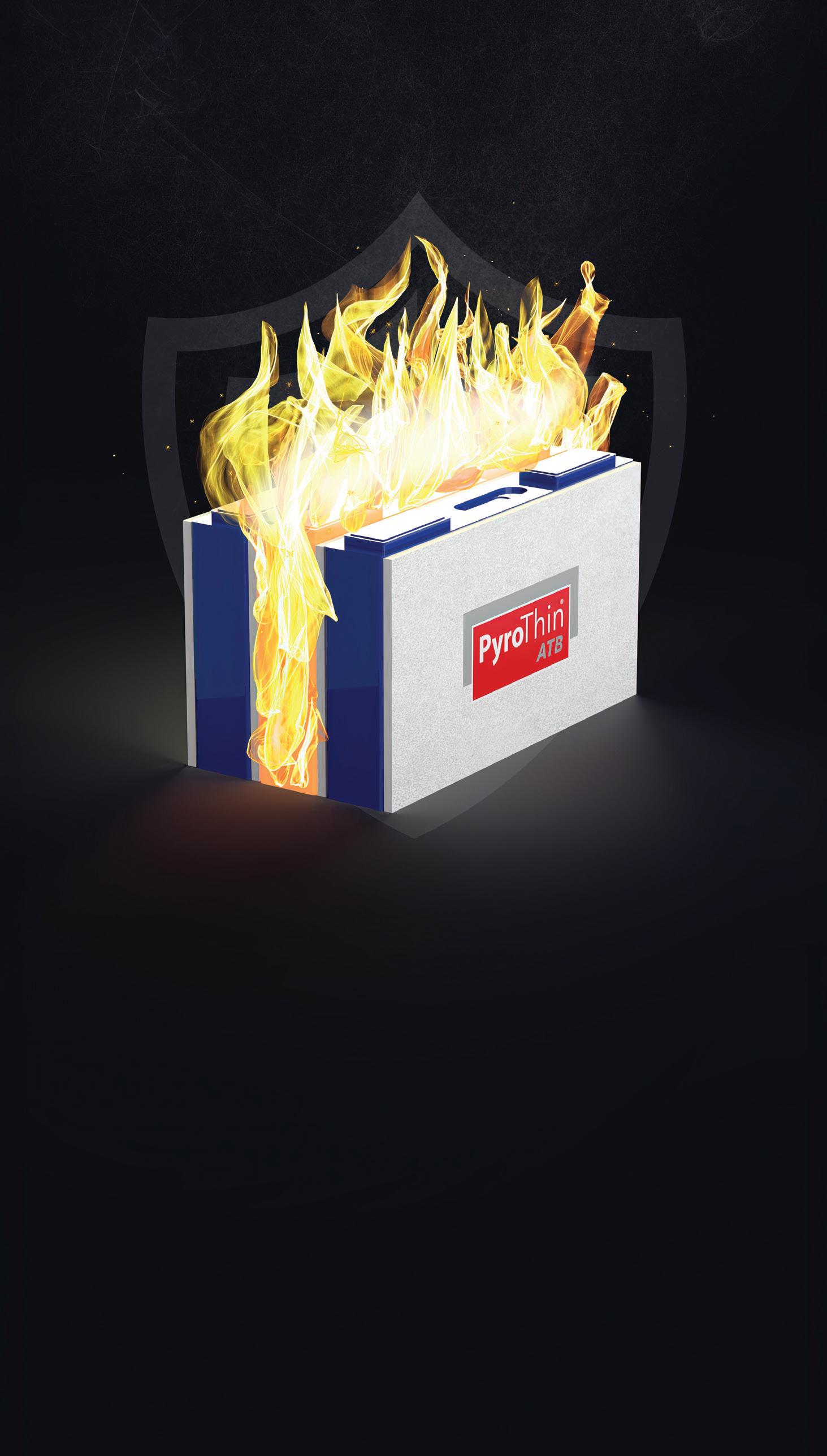
Eddy current losses are a function of both core material and its construction—a higher bulk resistivity and a minimally thick dimension help the most.
both the core and the windings over simply minimizing the winding resistance, but with one major caveat: the circulating current in a fully-resonant converter operating near resonance will be considerably higher than the actual load current (several times higher, perhaps), so winding resistance shouldn’t be completely ignored. e core losses are the result of hysteresis, or the e ort expended in ipping the magnetic domains back and forth, and eddy currents, which arise from currents being induced into the core normal to the magnetic ux path. Hysteresis losses are entirely a function of the core material. Ferrite and low-mix powdered iron perform the best, as molypermalloy powder (MPP) and other powdered metal mixes trade higher losses for a higher permeability value and saturation ux density. Eddy current losses are a function of both core material and its construction—a higher bulk resistivity and a minimally thick dimension help the most. Of course, the lowest core losses result from having no core at all, and this might very well be an option at frequencies above 500 kHz or so, though if you don’t want this inductor to be an EMI cannon then it would still be best to make it toroidal in shape.
e winding construction for resonant inductors is rather more di cult to optimize from a losses-vs-costs perspective, because the common and low-cost technique of twisting together several smaller magnet wires to get the necessary current rating might not perform nearly so well in a resonant application due to skin and proximity e ects. Skin e ect is a phenomenon in which eddy currents induced into a wire by the very high-frequency current it is carrying force said current into a ring, with no current owing in the center, and this e ect scales with the square root of frequency and the square of the diameter. For example, the maximum frequency a #18 AWG wire (~1 mm diameter) can car-
ry before skin depth starts to a ect it is ~17 kHz, and this drops to a mere ~4.2 kHz for #12 AWG (~2 mm diameter). A huge number of strands will be needed to minimize skin e ect losses above 200 kHz or so, but unless each strand spends the same amount of time (so to speak) facing the core and the wiring surface, proximity e ect starts to dominate the losses (this is basically skin e ect arising from the magnetic elds from adjacent winding layers). Both skin and proximity e ects can be alleviated with Litz wire, which consists of many (up to hundreds!) of individually insulated strands that are woven in such a way that each of them continually changes its position between the center and the perimeter of the wire. ere are practical limits to how far this concept can be taken, however, as the cost of Litz goes up with strand/bundle count, while the individual strands will become too small to withstand the weaving and bundling process at some point (the usual cuto is around #44 AWG). ere are also more subtle reasons to keep the strand count down, such as an increasing ratio of insulation to copper, and the fact that proximity e ect happens between each strand and each bundle of strands (albeit not to the same degree as between actual winding layers). e upshot of all this is that it will o en be more economical overall to go up a step or two in core size just to reduce the number of turns required to achieve the target inductance, and especially to keep all the turns in one layer (which also dramatically reduces the stray capacitance of the winding). Even so, operation at >200 kHz or so will almost certainly require Litz, so budget for that cost increase accordingly.
e nal application for inductors is EMI/noise ltering, and here high AC losses in both the winding and core are more of a feature than a bug, and going with a COTS component might be the best choice. If you are rolling your own—or just to better select a COTS component—then minimizing the stray capacitance of the winding is a relatively higher priority than anything else, as this capacitance is a prime vector for high-frequency noise to bypass the inductor, defeating its very purpose. A single layer winding with a single magnet wire of appropriate gauge for the current is the preferred construction here. If the EMI lter inductor will have to carry considerable DC or low-frequency (i.e. mains) AC current for its size—and this could be on the




It will often be more economical overall to go up a step or two in core size just to reduce the number of turns required to achieve the target inductance, and especially to keep all the turns in one layer—which also dramatically reduces the stray capacitance of the winding.

Coilcra ’s SPT surface-mount toroidal power indu ors
order of a few mA for a signal-level inductor—then the same design guidelines as explained above for DC-biased chokes will apply, though with much more emphasis on employing a closed-form core shape so that these lter chokes doesn’t become impromptu EMI cannons. RF noise typically manifests on all wires passing through an enclosure, so common-mode ltering will be more e ective than individual lters for each power and signal line (i.e. in normal or di erential mode). is is most easily achieved by putting all of the windings for a related group of wires—including their ground return—on a single core (e.g. the AC mains power inlet, signal lines to the motor encoder, throttle pot, etc). e windings will appear in series for common-mode current, but almost disappear for normal-mode current. e latter could be a minor issue in that some inductance may still be desired for di erential-mode ltering, in which case purposefully constructing the windings to have high leakage inductance (e.g. by physically separating them) will prove benecial. e ubiquitous toroidal common-mode choke found in practically every AC mains lter embodies all
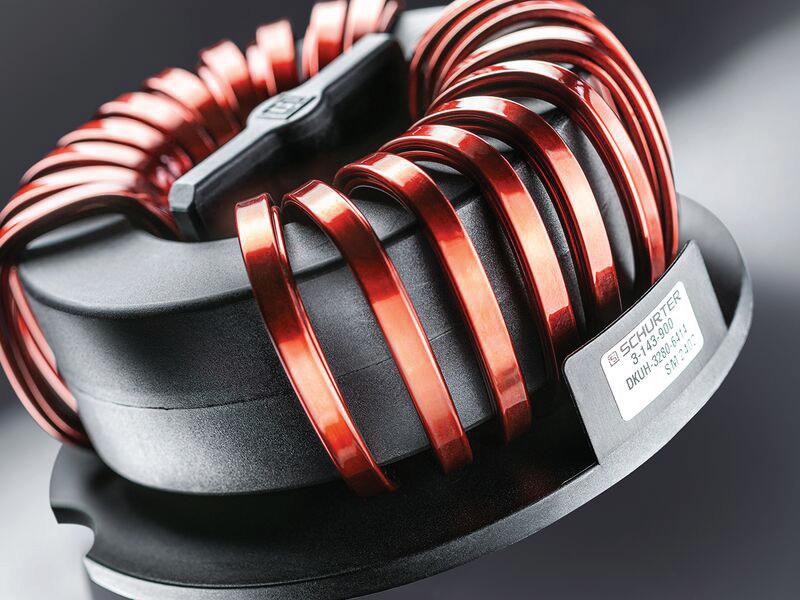
SCHURTER’s 800 VDC current-compensated oke
of these principles—the toroidal core is a closed form, so it emits almost zero EMI, and the windings consist of a single layer of a single magnet wire wound on opposite sides of the core, resulting in high AC losses, the minimum possible distributed capacitance, and relatively high leakage inductance, with some di erential-mode ltering thrown in for free. Most COTS common-mode chokes will already be listed/approved with the relevant safety agencies as well, making them an even more compelling choice over bespoke components.



Q&A with measurement engineering experts Coty Harrison and Cristian Loris of Yokogawa Test&Measurement


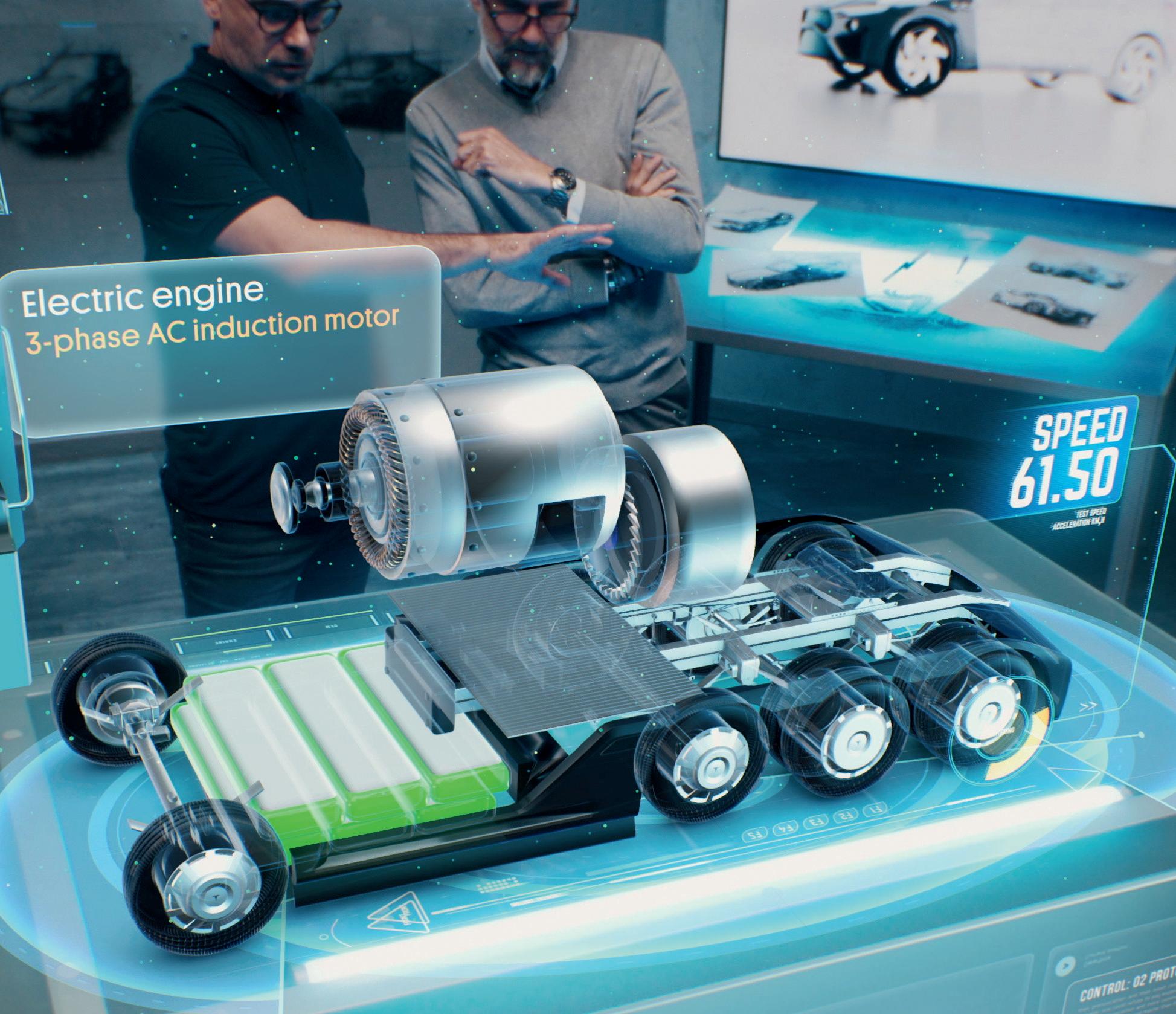
By Chri ian Ruo
The right tool to measure power in complex EV systems is a purpose-built power analyzer that captures three core parameters—voltage, current and power.
When tasked with measuring the electrical power of complex systems such as EVs, an inexperienced engineer may rst reach for general instrumentation like oscilloscopes, data acquisition (DAQ) systems and digital multimeters (DMMs). While these instruments serve useful roles in electrical testing—oscilloscopes analyze time-dependent signals, DAQs handle large-scale data, and DMMs focus on fundamental electrical measurements—they are not suited for making traceable and accurate electrical power measurements.
All three general tools su er the same shortfalls—they are not designed to measure power accurately, but rather to accurately measure DC or, in some cases, clean AC RMS. Using oscilloscopes, DAQs and DMMs to measure power could compromise product design by creating signi cant (o en invisible) measurement errors.
e right tool to measure power in complex EV systems is a purpose-built power analyzer that captures three core parameters—voltage, current and power—as well as a few very important additional parameters (depending on what system you are testing) that contribute to understanding the e ciency and overall system performance.
To learn more about purpose-built power analyzers, Charged recently chatted with measurement engineering experts Coty Harrison and Cristian Loris of Yokogawa Test&Measurement. Founded in 1911, Yokogawa is a global company that provides a range of products that measure electrical and optical signals and other critical engineering parameters. The company’s systems are used across industries including energy, manufacturing, and increasingly EVs and renewable energy.
For EV applications, it’s no longer a want but a need for a power analyzer to support sampling rates up to 10 megasamples per second (MSps) per channel.
Q Charged: Can you give us a high-level explanation of why purpose-built power analyzers are critical in EV system development?
A Coty Harrison: In EV applications, measurement accuracy must be reliably maintained across a range of frequencies and conditions, so it’s critical that you have a system that captures many di erent elements and channels.
For example, in developing and testing a new EV traction motor design, you need a system that enables engineers to comprehensively measure electrical parameters as well as mechanical parameters like speed and torque.




For EV power measurements, signal conditioning is crucial to reduce noise and maintain signal integrity, especially in high-power systems.
Accuracy becomes especially important during validation, as manufacturers must ensure their products meet stringent e ciency and performance benchmarks before production or delivery to customers. As EVs gained traction and competition increased in the market, engineers began developing more innovative and complex designs, which meant more complicated measurements. For example, we designed our newest power analyzers to provide precision with an error margin as low as 0.03%. is means manufacturers can con dently verify e ciency gains in the 1-2% range, which is critical for competitive advancements. New materials like silicon carbide (SiC) and gallium nitride (GaN) allow higher switching rates, so instruments also evolved to meet increasingly demanding switching requirements. For EV applications, it’s no longer a want but a need for a power analyzer to support sampling rates up to 10 megasamples per second (MSps) per channel. And when you combine that with 18-bit analog-to-digital (A/D) conversion, you ensure accurate data even under high-frequency conditions. is allows EV motor and inverter validation with e ciency measurements that di erentiate between real gains and measurement inaccuracies—vital for performance tuning in automotive.
Q Charged: Can you expand on the example of EV traction motor design? How exactly is a purpose-built power analyzer used to improve the end product?
A Cristian Loris: E ciency directly impacts the range of EVs, which is a key factor for consumers. Small improvements in motor e ciency can signi cantly extend vehicle range and reduce energy consumption. Accurate measurements will optimize performance under various loads, and precision is especially critical when addressing complex drive cycle scenarios. It comes down to two key challenges. First is measur-
ing power to a known, traceable and guaranteed power spec, which isn’t possible if you are using instruments focused on DC specs or AC RMS. AC power—especially noisy switched power—requires integration at a high sample rate, consideration of line lters and zero crossings, etc.
e second challenge is that motors are an inductive load, which will always have some power factor that will further degrade measurement accuracy if you use general tools like oscilloscopes, DAQs and DMMs—as much as 30% or more.
Unlike general-purpose equipment, power analyzers will have dedicated algorithms optimized for traction motor applications, including power calculation over varying load conditions. For EV power measurements, signal conditioning is crucial to reduce noise and maintain signal integrity, especially in high-power systems. Also, purpose-built analyzers are designed to log data consistently over extended periods and o er traceable data records for certi cation purposes, which is important for EV powertrain testing that o en involves long-duration measurements.
A Coty Harrison: To elaborate on this example, a few key parameters need to be measured in traction motor development. e rst is powertrain e ciency, and those measurements require accurate voltage and current readings from the power supplied to the traction motor, both from the battery and the inverter.
e challenge here lies in measuring high-frequency switching waveforms accurately, as traction motors typically operate in dynamic conditions.
en there is the power factor, which impacts the energy transfer from the battery to the motor. Ensuring a higher power factor (as close as possible to the ideal unitary value) improves energy e ciency and reduces losses, and is therefore crucial to measure and control.
Also, harmonics and distortions in current and voltage waveforms lead to energy loss and may impact the performance of the EV motor. Power analyzers that can accurately measure harmonic content help engineers mitigate these losses.
Finally, torque and speed measurements are essential to assess motor output accurately.
Combining the accurate measurement of these parameters will provide engineers with a complete picture of a motor’s e ciency.

Tools that lack AC signal testing will struggle with measurements in dynamic EV conditions.
Q Charged: You mentioned the validation stage of the development process. Is that when power analyzers are mainly used?
A Cristian Loris: Yes, power analyzers are primarily used during the validation stage of EV systems to benchmark e ciency and ensure products meet performance expectations before moving into mass production.
A Coty Harrison: e validation phase includes the component level (i.e. chip makers), the initial system integration level (i.e. Tier 1 suppliers), and the production level (i.e. vehicle OEMs)—to make sure the full production process is working correctly. Generally, component manufacturers can use devices with lower accuracy (around 1%) while designing parts. And then before nalizing designs and shipping parts to customers, they will use power analyzers to benchmark the parts with extremely high accuracy. is is when they create a spec sheet for a part. Ballpark values are insu cient for this step. ey need to have exact power measurements.
Q Charged: What Yokogawa products do EV engineers typically use for power analyzing?
A Coty Harrison: Our Yokogawa WT series power analyzers are designed for this purpose. Unlike general measurement tools, our power analyzers provide both isolated voltage inputs and accurate current measurement capabilities, which are essential for accurately capturing cycle-by-cycle power metrics. Tools that lack AC signal testing will struggle with measurements in the dynamic conditions seen in EVs or other systems with shi ing power factors.
A Cristian Loris: As the automotive industry has embraced electri cation, we’ve added features like
support for multi-motor systems and faster sampling rates to handle higher switching frequencies.
Our WT5000 supports up to seven elements that provide accurate current and voltage measurements. Current sensing is performed using a shunt resistor with temperature and frequency compensation. For the evaluation of motor speed, torque and mechanical power, up to eight input channels (via two modules) are available, enabling the evaluation of four motor systems simultaneously.
Q Charged: Where are power analyzers used outside the EV Industry?
A Cristian Loris: While automotive applications are driving a lot of innovation in the space, our power analyzers are also widely used in industrial motor development, which consumes roughly 60% of global electricity. Enhancing e ciency in these systems has a massive impact on reducing energy usage and costs.
Q Charged: Can you tell us more about your roles at Yokogawa and how you help EV systems engineers?
A Coty Harrison: I’ve been with Yokogawa for eight years. I started as an application engineer, which is where most of our technical sta begin. Given the complexity of our test equipment, it’s important to gain hands-on experience. From there, I transitioned into technical sales and eventually became the North American Sales Manager for our test and measurement team.
A Cristian Loris: I also started with the application engineering team about two and a half years ago. ere, I helped integrate our products into customers’ testing setups, allowing me to see rsthand the industry’s challenges. Since then, I have transitioned into the role of Product Manager for our decarbonization and electri cation product portfolio, including our power analyzers for the EV market.
We work closely with EV systems engineers when they need help figuring out what testing products will work best for their specific applications, and then we help them customize and implement them into their processes.






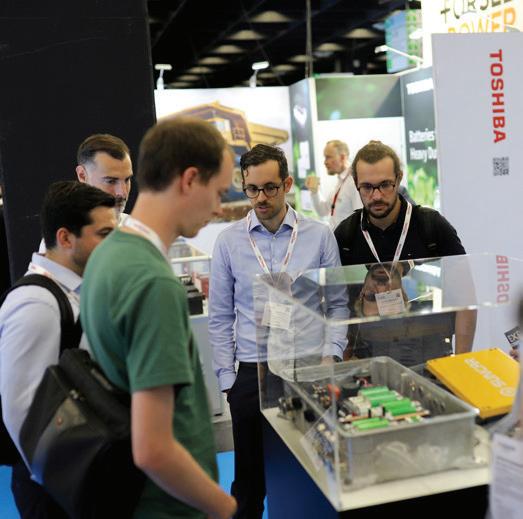



By Charles Morris
Q&A with TE Connectivity’s Helio Wu and Pradeep Moorthy
Avehicle has always been more than an engine and a set of wheels. Lights, windshield wipers, heaters—these have been essential equipment since the days of hood ornaments, and over the years more and more accessories have come to be seen as indispensable. Power windows, power locks, cruise control, heated/cooled seats, and now infotainment systems and Advanced Driver Assistance Systems—the list grows longer every year. And of course, accessories include not only gadgets for the driver’s comfort, but also systems essential to the operation of the vehicle (e.g. in the old days, alternators and water pumps, nowadays battery management systems).
For decades, electrically-operated accessories have been powered by a 12-volt electrical system, and components, connectors and wiring have all been designed to operate on 12 volts. In recent years, as power demands have increased, automakers have been moving towards 48-volt systems. is is a trend that applies to all types of vehicles, but as TE Connectivity’s Product Manager Helio Wu and Senior Manager of Product Management Pradeep Moorthy explained to Charged, there are several reasons why the transition to EVs is accelerating the transition to 48 volts.
Q Charged: Why are automotive manufacturers shi ing to 48-volt architectures? What are the advantages?
A Helio Wu: e major driver is that power requirements keep increasing, and because of the higher power requirement, the current level keeps increasing as well. e higher current level requires wires with larger diameters, and that is creating a substantial challenge in wiring harness routing. Increasing voltage to 48 volts can reduce the electrical current by three quarters, assuming the same power requirement, and thus we can save a lot in both the wiring harness weight and cost.
Q Charged: If the power remains the same, then the wires can be smaller and lighter. But at the same time, we’re asking for more power. So, is there generally a net reduction in the size and weight of the wiring harness?
A Helio Wu: Yes. e power requirement is increasing, but it doesn’t increase by four times, so overall, we still can expect a lot of weight reduction and cost savings from this transition. Meanwhile, this transition will take place along with a transition to a zonal architecture. e zonal architecture itself can optimize the overall electric architecture in the vehicle and shorten the wiring

harness length, because previously automakers used a centralized star topology. Now it’s decentralized, and the power equipment is managed within the zones, so the total length is going to be reduced.
Q Charged: In a recent video from Rivian, their engineers explained that they were able to reduce the number of controllers and the vehicle weight signicantly, mainly because of the move to a zonal architecture.
A Pradeep Moorthy: I remember watching some videos recently about the things that Rivian’s doing in that space. What we are doing there is consolidating multiple controllers into one in each of the di erent zones of the vehicle, and we are packaging a lot more of the computing capabilities that were in multiple controllers into one—this drives up the power requirements for those controllers, which justi es the switch to 48-volt, so they de nitely are correlated. So, the shi to 48-volt enables the shi to the zonal architecture.
Q Charged: e transition to 48-volt is taking place across all types of vehicles, but tell us about how the rise of electric vehicles is speci cally driving the move.
A Pradeep Moorthy: e switch to 48-volt is not just for electric vehicles. e bene ts are shared regardless of what the propulsion mechanism is. On the EV side, though, there are a couple of speci c things. First, every kilogram you can shave o the weight of the vehicle is more valuable in an EV from a range standpoint, so EVs have more to gain from switching to 48-volt. Second,
Increasing voltage to 48 volts can reduce the electrical current by three quarters, assuming the same power requirement, and thus we can save a lot in both the wiring harness weight and cost.
younger OEMs that focus on EVs are more open to step changes in their architectures. With the switch to 48-volt, you do need to make a signi cant change because most devices throughout the vehicle need to be updated to work on 48 V rather than on 12 V. From an implementation standpoint, the way OEMs are structured today, the EV-speci c teams are better positioned to make that jump.
Helio Wu: ere’s also another reason why we see EVs leading this transition. An internal combustion engine not only drives the vehicle, but also provides power to many auxiliary applications. If we talk about EVs, all those applications traditionally driven by belts now become electric-driven, and they are power-hungry devices. And the more power-hungry it is, the more bene t we can expect if that application can be converted to 48-volt.
Q Charged: Obviously, OEMs that are more innovative, more forward-looking, are moving faster with
electri cation. Are those also the ones that are more interested in 48-volt?
A Pradeep Moorthy: Apart from an innovative mindset, organizational will to implement disruptive changes is necessary. A few OEMs leading the way on electri cation are better structured in that regard. But that’s not to say that the other OEMs are not interested—they are looking at ways to switch to 48-volt as well. e steps taken to switch and the timing will likely be di erent, though.
Q Charged: What are some speci c components we nd in EVs that are driving the move to 48-volt systems?
A Helio Wu: I can give you an example. Earlier this year I had a conversation with a customer engineer and he told me that for him, the biggest advantage from 48-volt is thermal management. In his next-generation vehicle, we have so many electronic components running at high power that if we do not increase the voltage level, the heat generation and the temperature would rise to a level that is unmanageable. Switching to 48-volt reduces the energy dissipation and the heat dissipation, so it can help reduce the temperature of those modules within the system. And it helps a lot in guaranteeing the longevity of those devices, making sure they can work properly through the vehicle life. We talk a lot about the wiring harness weight and cost savings, but reduced heat generation is another major bene t that the OEMs can get from this transition.
Q Charged: Tell us more about how a 48-volt system can improve energy e ciency, something very important for EVs.
A Helio Wu: It’s simple physics. When we talk about the energy loss dissipation in the wires, it’s W = I2 * R, right? Suppose we use the same wire, same wiring resistance. If we reduce the current level to 1/4 of the previous value, that means the energy dissipation can be reduced to 1/16. at’s a lot of reduction, and therefore we improve the energy e ciency and the power delivery e ciency in the vehicle system. is is a direct bene t.
In an EV all those applications traditionally driven by belts now become electric-driven, and they are power-hungry devices.
Indirect bene ts include weight reduction, so we can have a longer range.
Q Charged: Both 12 V and 48 V systems can coexist within the same vehicle, but will 12 V eventually be phased out?
A Helio Wu: I believe that 12-volt and 48-volt will coexist for a period, maybe three years, maybe ve years. Not everybody will be ready for 48-volt. at’s just a reality. Going forward, gradually suppliers’ readiness will be improved, and then eventually, I believe 12 V will be eliminated from the current low-voltage system, and 48 V will be the norm.
Q Charged: at sounds like a pretty quick transition. Within ve years, you say, everything’s going to be 48-volt?
A Helio Wu: at’s my hope, because we believe it will not only bene t the OEMs, but also provide more advanced functions to the end consumer so we can have more exciting vehicles.
Q Charged: Tell us about the role that connectors play in enabling the 48-volt architecture.
A Pradeep Moorthy: From a connectivity standpoint, it’s primarily about safety, when you go from 12 V up to 48 V. With the higher voltage, we want to make sure that there is su cient insulation between circuits and there are safety mechanisms in the vehicle architecture to ensure that people working on their vehicles are protected as well. What we are doing today is looking at our existing portfolio to see which products are already safe to be used in 48-volt applications. We are also building a whole new portfolio of connectors that are designed speci cally for use in 48-volt applications.




We believe that 12-volt and 48volt will coexist for a period, maybe fi ve years. Gradually suppliers’ readiness will be improved, and then 48 V will be the norm.
information from multiple sensors—it’s simple signals, but they also need to be able to communicate with other controllers and devices like cameras, so there’s highspeed data connections in there as well. We are working on a portfolio of what we call mixed and hybrid connections, which have signal, power, and high-speed data connections, all in a single connector.
Q Charged: What about wireless data? I’ve heard about wireless battery management systems. Is that a trend?
Q Charged: Will this eventually mean redesigning your product lineup?
A Pradeep Moorthy: Not necessarily all of it. I think it will be more of an evolution. e key things here are what we call creepage and clearance, which refers to the distance between adjacent circuits to provide su cient insulation and preventing any kind of arcing or current creepage. Because of how they were designed, higher-power connectors for 12 V happen to be safe for 48 V already, so there is a signi cant part of our portfolio that can be used in 48-volt applications without any changes. In the smaller end of our portfolio, where we have very low-power and signal applications today, those connectors tend to be optimized for 12 V applications, so they’re not ready to be used in 48 V applications. In those spaces we are developing new products to ll out the portfolio.
Q Charged: Some of these connectors are just powering devices, some of them are sending data, and some are doing both, right?
A Pradeep Moorthy: Yes, that’s right. Helio and I are both part of the Signal and Power Connectivity Group within TE’s automotive business, and that covers all our products up to 48 volts as an upper limit. e products within this portfolio historically were tailored speci cally for low-voltage power and signal connections, and then we have a whole other group of products that are speci cally designed for high-speed data. More recently, the lines between these di erent categories have started blurring. We have controllers now that are power-hungry, so they need high-power connections. ey bring in
A Pradeep Moorthy: We have seen them in speci c instances, but they’re not broadly adopted yet. Even in the battery example, the wireless connections are inside the battery pack, but there are still wired connections from the pack to the rest of the vehicle. If there are routing challenges, packaging space-related concerns, then it might make sense, and we’ll probably start seeing more wireless connections. But purely from a cost standpoint and from a security standpoint, implementing those will be hindered for some time to come.
Helio Wu: I also think the functional safety is another point to consider. Because the battery is such a critical module, we need some kind of redundancy. I think for wireless communication, maybe we need two connections—one wireless and the other using actual wire as a backup.
Q Charged: As auto manufacturers and suppliers move towards 48-volt architectures, what are the biggest challenges they are going to face?
A Pradeep Moorthy: As I said, an overall switch to 48-volt is still a monumental exercise to take on. ere are so many things, not just the connectors, but the devices within the vehicle, that have to be modi ed to accept 48 volts. Simply from a resource standpoint, there needs to be signi cant investment in making that switch. And there’s the classic chicken-and-egg problem—the OEMs are not willing to switch unless the suppliers are ready to support that switch to 48-volt with their devices, but the suppliers may not be willing to make that investment until the OEMs are ready to bring 48-volt vehicles to market.

A good rst step to overcome this challenge is the coexistence of both 12 V and 48 V in the short term. is will enable OEMs to use 48-volt for speci c applications which are particularly power-hungry, where they can get a signi cant bene t from copper reduction, thermal management and the di erent advantages that we spoke about, without necessarily changing every single device within the vehicle.
Q Charged: What’s an important piece of advice you would give to an automaker to help them more easily transition to 48-volt?
A Pradeep Moorthy: I’d say the most important thing is to keep the system-level bene ts in mind, and to communicate that e ectively to all levels. e switch from 12 V to 48 V does mean redesigning and replacing familiar devices and components. is could lead to higher costs at a component level, but we cannot lose track of the big-picture net savings.
Q Charged: ere’s also talk of a transition in the overall vehicle architecture from 400 volts to 800 volts. Does that have any relation to the 12 V/48 V transition, or are these two separate areas?
A Pradeep Moorthy: ey’re de nitely separate areas. e 400 and 800 V architectures are for EV powertrains. Helio and I are in the Signal and Power Connectivity Group, working with low-voltage applications that are non-powertrain-related, but TE Connectivity does o er connectivity solutions for both 400 and 800 V applications.
Q Charged: Some people nd it hard to understand why an EV still has an ordinary lead-acid battery. I try to explain to them that all the accessories are designed to run on 12 volts. Does the shi to 48-volt bring us closer to the day when that lead-acid battery can go away?
A Helio Wu: Yes. If in the future 48-volt becomes the single power source in the low-voltage system, then that 12-volt battery will go away.
Pradeep Moorthy: Right. But it’s important to remember that you’ll still have a second battery for 48-volt.
You’re not going to drive all the devices on the vehicle from the main traction battery, because there are still going to be applications in the vehicle that need to be running when the vehicle is turned o , and you do not want to be drawing power from the main battery all the time.
Q Charged: What’s the state of industry standards when it comes to the 48-volt transition?
A Helio Wu: Because this is a new transition, standardization is important as it helps everybody to scale up faster. And the earlier we can scale up, reach the higher operational scale, the better we can realize those economy-of-scale gains for everybody. at’s why TE has developed a standard interface for a 48-volt connection system, and we are actively working with di erent OEMs as well as device makers, to try to help everybody to connect the dots. at’s what we do, connectivity.
From my perspective, I think the standards have been well established, looking back several years, roughly from 2016 or 2017. At that time, 48-volt was also a hot topic, but in a di erent context.
At that time, people were talking a lot about 48-volt in mild hybrid vehicles because that is a low-cost entry point for vehicle electri cation. Still today we can see a lot of 48-volt mild hybrid vehicles in the European market or in Asia. Now the interest in 48-volt is being driven by the low-voltage architecture for powering accessories. However, due to the activity several years ago, we already have a lot of established standards and technical requirements from organizations such as SAE, ISO, etc.
Q Charged: What are some exciting innovations coming up in the near future?
A Pradeep Moorthy: For TE as a company, harness connectors and terminals are our core business, but we also have several other solutions that enable the switch to 48-volt. We are working on data/signal hybrid connectors on both harness and device sides that will package better as our customers switch to zonal architectures. We also have heat-shrink tubing, relays, EMI ltering products, etc, and we are making sure to have all of them 48-volt-ready as well. When an OEM is ready to make that switch, TE can be a one-stop shop.







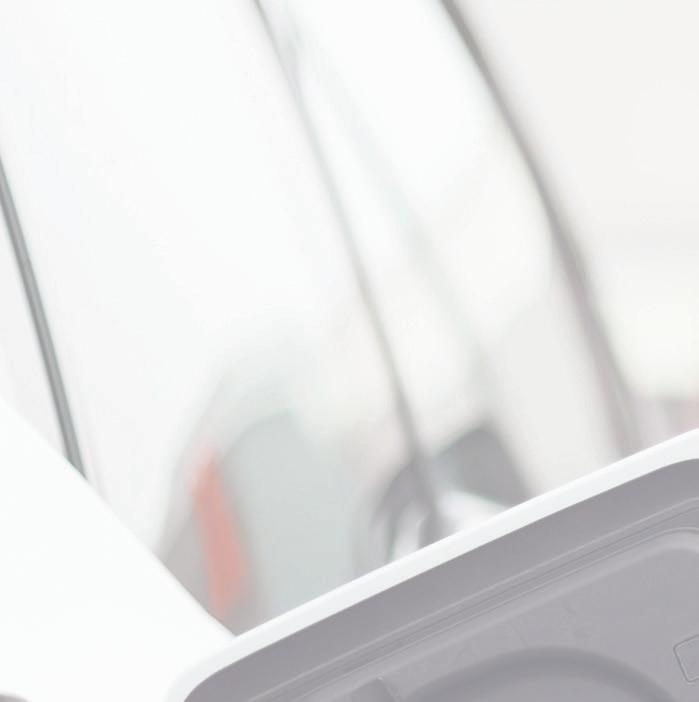










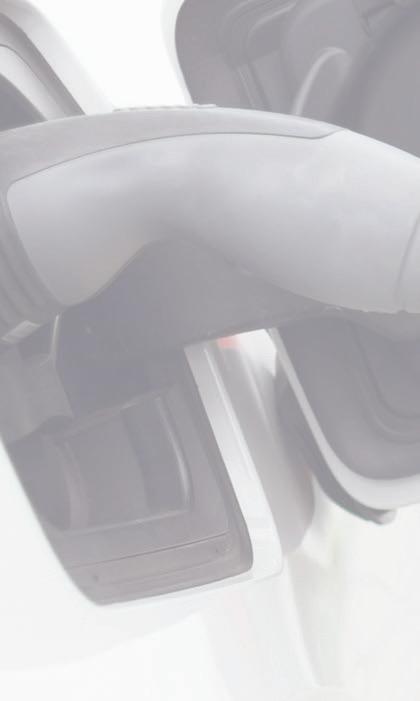





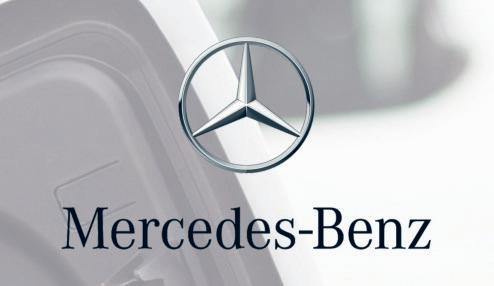



















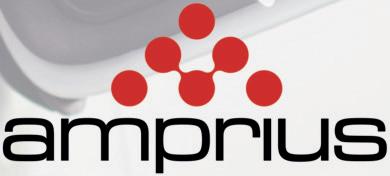













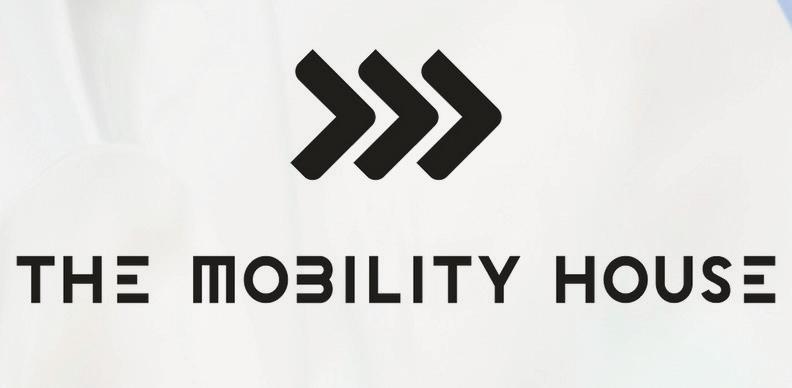










































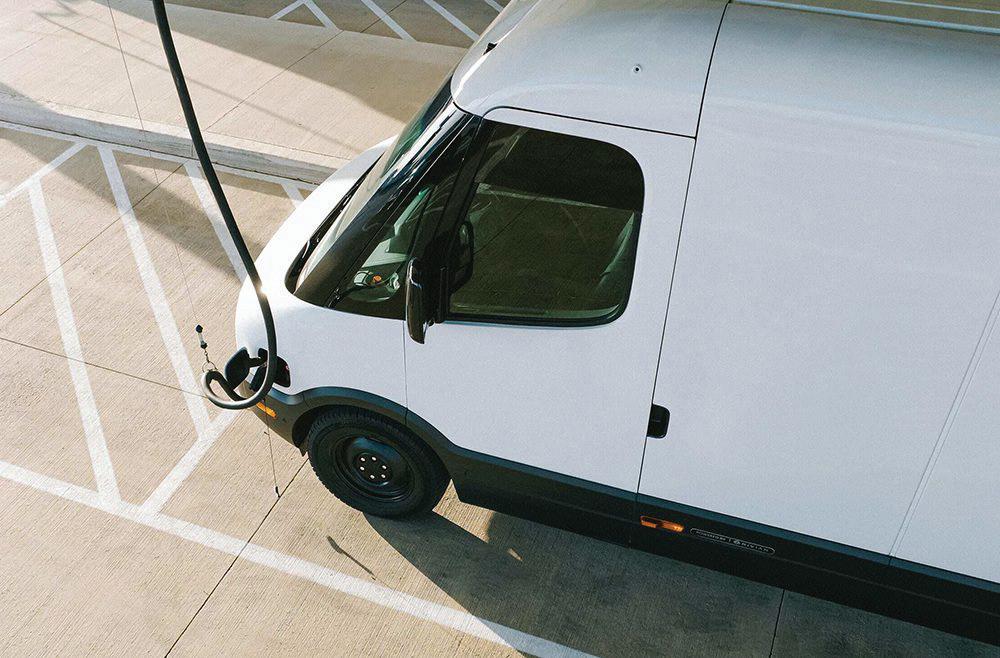
Rivian is opening up sales of the Rivian Commercial Vehicle, the platform on which Amazon based its custom electric delivery van (EDV).
Amazon’s exclusivity period ended in November 2023, and since then Rivian has been trialing its commercial van with several large eets in the US, and preparing its eet management process for the mass market. e van is now available to US eets of any size. Deliveries began in April.
Prices start at $79,900 for the RCV 500 version, which has a GVWR of 9,350 lbs and cargo volume of 487 cubic feet. e longer RCV 700 version o ers a GVWR of 9,500 lbs and cargo volume of 652 cubic feet, and goes for $83,900.
Rivian has also launched the new Rivian Up t Program for eet customers. Up tting is the process of customizing a chassis to create a specialized vehicle for a customer.
Rivian uses a direct-to-consumer model, but its Up t Program is designed to simplify the ordering process and deliver an experience akin to what eet managers would expect from a dealership. Rivian has launched the program in partnership with commercial vehicle providers Ranger Design, Sortimo, Bush Specialty Vehicles, Holman, Legend and EV Sportline.
Rivian’s R1T, R1S and delivery van are all available for up tting under the program.

Virgin Atlantic and Joby Aviation, a maker of electric vertical takeo and landing (eVTOL) aircra , have signed an agreement to create an eVTOL service that the two said will pave the way towards launching an air taxi service across the UK.
An air taxi is an o -highway transportation service that bypasses the tra c and delays of major airports.
e partnership builds on an existing agreement between Joby and Delta Air Lines, which owns a 49% stake in Virgin Atlantic, to launch services in the US and UK.
e two partners have not provided a start date.
e Joby Aviation S4 has room for one pilot and four passengers, along with ample space for luggage. e service will allow for short-range, fully electric o -highway journeys between cities and towns.
Joby’s CEO, JoeBen Bevirt, stated: “We are committed to delivering faster options for mobility across the country, including for Virgin Atlantic and Delta customers as they head to the airport or move between UK towns and cities.”
Once up and running, the air taxi service would connect passengers arriving at London Heathrow and Manchester airports with less in-demand destinations. Journeys in the UK would include a 15-minute ight from Manchester to Leeds, or an 8-minute journey from Heathrow Airport to Canary Wharf, a journey that, by automobile, takes 80 minutes on a good day.




Trova Commercial Vehicles has launched a battery-electric terminal truck, the company’s rst product to reach the market. Terminal trucks are tractors designed to move semi-trailers within a warehouse facility, cargo yard or intermodal facility.
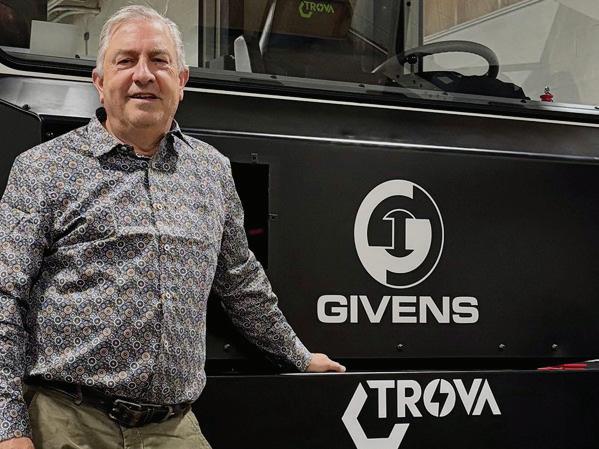
“One of the unique sides of Trova is its leadership team,” CEO Patrick Collignon told Charged, explaining that the team includes several former senior executives of Volvo, owner of Mack Trucks—among them the former President of Mack Trucks and an Executive Vice President of Volvo.
“We were accompanied on our journey by two strategic partner companies: Netgroup, an automotive engineering rm, and Chateau Energy Solutions, with whom we o er complete infrastructure solutions, including EV charging stations, to our customers,” Collignon told us.
“ e terminal tractor’s chassis has been designed from the ground up for our high-voltage driveline,” he added, noting that the battery packs were located inside the chassis rails. Trova believes this approach assists with overall safety and vehicle stability. e company does not use rail-mounted battery packs, to avoid exposure to side-impact accidents and reduce the amount of structural steel needed to mount the battery packs, which in turn reduces the overall weight of the vehicle.
Collignon also said that “the HV architecture consists of ve pre-assembled modules, which not only reduces assembly time but also improves accessibility for a ermarket maintenance and repair.”
e vehicle is equipped with a full-width cab with room for a second seat, an unusual feature for such trucks, but one Collignon said had been designed based on feedback from potential customers. Trova’s is the most spacious cab in the industry, Collignon said.
Trova worked with the Industrial Design department at Virginia Tech in designing the cab, which includes a space frame, a platform cab with structural integrity built into the space frame, and side impact bars that double as ergonomic arm rests. e interior height is above the industry norm, allowing a person who is 6 feet tall to stand up at the entrance, while the front windshield and side windows lean forward to o er improved lowspeed visibility in inclement weather, Collignon said.
Collignon told us the truck is the rst vehicle in its market segment to use axial ux motors. “ ese motors are very compact, with high performance and fewer magnets, which translates to less impact on the environment thanks to less reliance on rare earth metals.” e system‘s nominal voltage is 660 V.



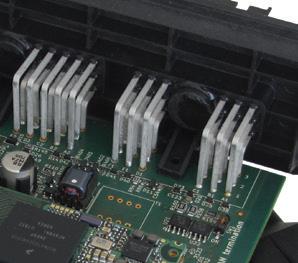
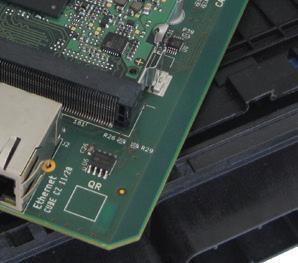







ADVANTICS, a frontrunner in charge controllers and power electronics, is first to ship Megawatt Charging Standard charge controllers for vehicles and charging stations with 10BASE-T1S communication. The MCS standard is critical to adoption for heavy-duty truck and bus, construction, marine, and aerospace applications. Allowing for up to 6MW, it overcomes the speed limits of CCS and NACS protocols.
Vehicle and Charge Station Manufacturers can order controllers now. Dual MCS + CCS/NACS versions will be coming later in 2025.
ADVANTICS is a long-time member of the CharIN interoperability testing community and will be hosting Testival Europe in France on June 3rd. Located just outside of Geneva, Switzerland. Come join us and try advanced features like MCS and V2G
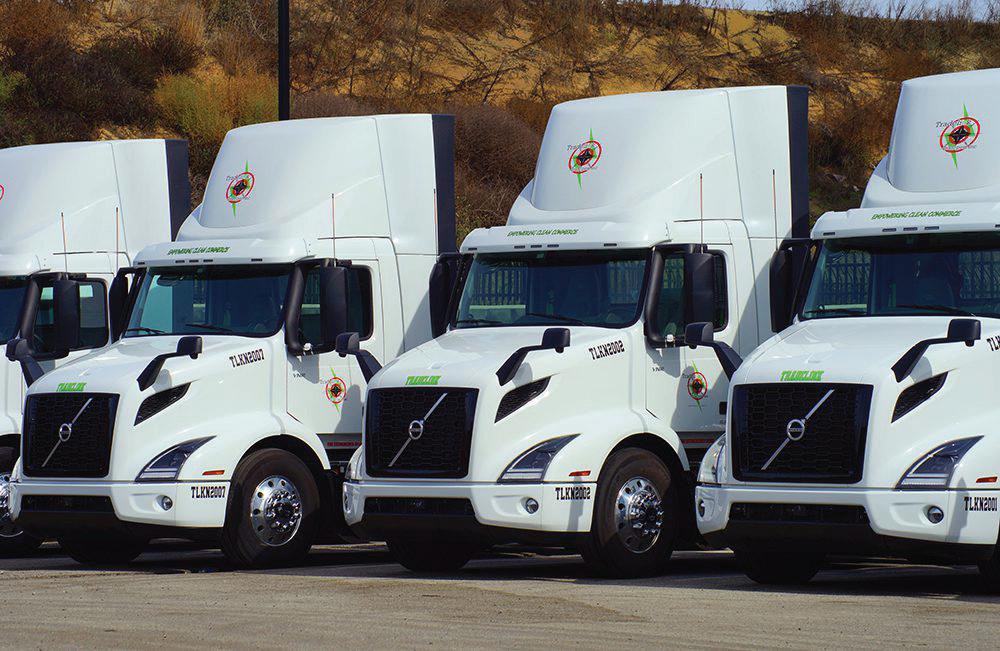
Drayage company Tradelink Transport has acquired 14 new Volvo VNR Electric Class 8 semis for its operations at the Ports of Los Angeles and Long Beach. e company currently operates a eet of 48 trucks, of which 21 run on compressed natural gas (CNG) and 12 on diesel. e company’s new battery-electric semis will operate within a 100-mile radius of their depots, moving goods to and from the San Bernardino and Riverside areas in the mornings and running shorter routes in the a ernoons, Clean Trucking’s Jay Traugott reports. Tradelink says the EVs will operate ve to six days a week, and will be charged overnight.
“Once drivers experience battery-electric trucks, they o en don’t want to switch back to conventional vehicles,” said Tradelink President Rigoberto Cea. “ e Volvo VNR Electric truck provides a smooth, quiet ride, and we’ve seen strong enthusiasm from our team as they adapt to this new technology.”
Tradelink bought its Volvo Trucks through dealer TEC Equipment, which provided assistance in route planning and helped make sure the hauler took full advantage of California’s Hybrid and Zero-Emission Truck and Bus Voucher Incentive Project (HVIP) and other state programs that o er rebates for charging infrastructure construction costs.

JeMyn, an a liate of Swiss rm Widmer Rail Services, has ordered two Vectron locomotives with battery power modules from Siemens Mobility—the rst order for this new version of the Vectron.
e battery module enables the Vectron to operate for short distances without an overhead power line, enabling the loco to cover the last mile of service and carry out shunting runs on non-electri ed sections of rail line. is eliminates the need for diesel-powered shunting locomotives.
e energy is supplied by a lithium-ion battery pack with an intelligent battery management system to control charging and discharging.
Delivery of the locomotives is planned for 2027.
“With the battery power module, our customers can now cover their entire operational routes electrically and with batteries. is development adds another innovative functional package to the successful Vectron family,” said Andre Rodenbeck, CEO of Rolling Stock at Siemens Mobility.
“With its new battery power module, the Vectron is the ideal locomotive for us,” said Pierre Widmer, CEO of Widmer Rail Services. “ anks to this functional package, we can now handle shunting operations even more e ciently without the assistance of additional shunting locomotives. is will enable us to further optimize our operating processes and save costs.”




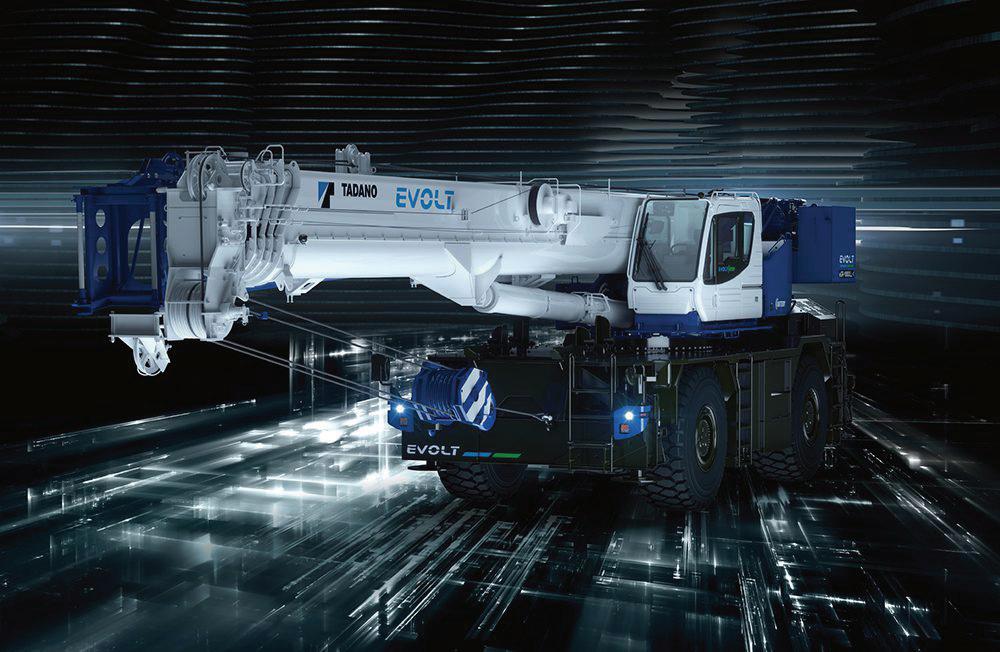
Japanese rm Tadano, considered one of the largest manufacturers of hydraulic cranes in the world, has released its new eGR-1000XLL-1 EVOLT, a 100-ton electric rough-terrain crane that o ers customers the same li ing capacity as its diesel fuel-powered counterpart.
e cumbersomely-named eGR-1000XLL-1 EVOLT 100-ton electric crane comes standard with six lithium-ion battery packs that supply up to 226 kWh of power. at is enough for up to seven hours of continuous operation in a single spot, or up to ve hours of continuous operation and ve and a half miles of propulsion.
e crane can be fully charged with a standard CCS/ J1772 DC fast charger at speeds of up to 150 kW in two hours, keeping downtime at a minimum.
e crane has the ability to operate 24/7 when using grid power as well, giving it added versatility and a greater ability to minimize downtime.
e eGR-1000XLL-1 EVOLT comes with a list of features about as long as its name, including ultra-quiet operation, which will facilitate night work in residential areas and provide greater safety for workers and crane operators; and a li visualizer that includes a suspended load-monitoring camera—particularly important when there are operator blind spots. In addition, the AML Control System delivers dependable crane control and monitoring solutions, and it incorporates all technological advances from other Tadano rough-terrain cranes.

Orange EV, a manufacturer of Class 8 electric terminal trucks, has introduced a new 7.5-year, 30,000-hour warranty.
e expanded warranty covers not only the truck’s battery, but also the powertrain, motors, controllers, wire harnesses, cables and key electric components.
“Delivering the highest-quality terminal trucks has always been our priority,” said Kurt Neutgens, President and CTO of the Kansas City, Kansas-based company.
“Our new warranty isn’t just an extension of coverage, it’s a testament to our track record.” e warranty also serves as a commitment to eet buyers “that uptime, cost savings and long-term performance are built into every truck.”
Terminal trucks—also referred to as terminal tractors, as well as by several more colorful names including yard trucks, yard dogs, yard mules and, in the United Kingdom, terminal lorries—are semi-tractor vehicles designed to move semi-trailers within a warehouse facility, cargo yard or intermodal facility.
Orange EV has the most deployed all-electric terminal trucks in the United States of any manufacturer, according to a February 2022 study by non-pro t consortium Calstart.

Chinese shipyard Jiangsu SOHO Marine Heavy Industry has agreed to construct a new dry cargo vessel for Norwegian short-sea shipping company Arriva Shipping.
e vessel, designated with building number SH008, is scheduled for delivery in the third quarter of 2026. It will have a 2 MW hybrid battery system and a cargo capacity of 8,000 deadweight tons (DWT).
e vessel will join the MV Nor Viking, which was delivered in 2022, and SH007, due in December 2025, as part of the company’s eet renewal and growth strategy.
e company owns and operates a eet of eight self-discharging dry cargo vessels, with capacities ranging from 2,000 to 8,000 DWT. It supplements its operations with 5-10 chartered vessels on time charter or on a commission basis.
“SH008 builds on the success of Nor Viking and its hybrid technology, further enhancing our e ciency and sustainability,” said Arriva’s CEO Sindre Matre.
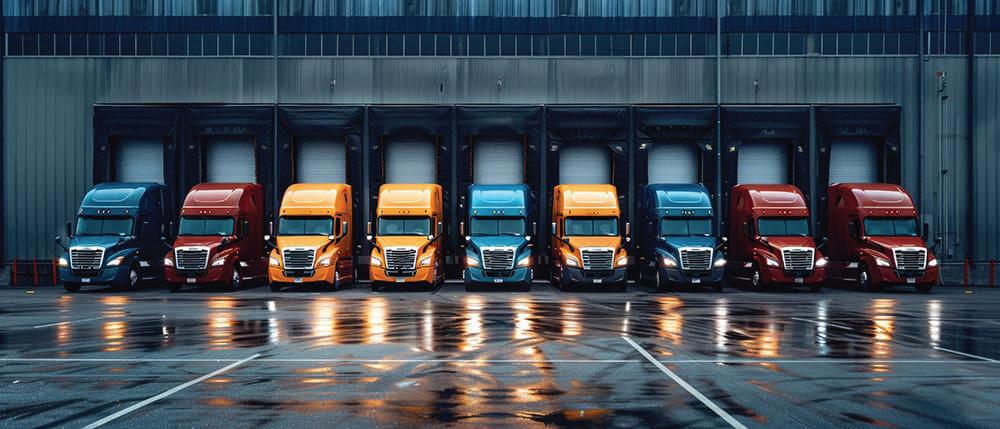
Energy e ciency specialist Ndustrial has launched Nsight Fleet, “a comprehensive platform for managing industrial-scale transport electri cation infrastructure.”
Nsight Fleet enables third-party logistics (3PL) sites to provide power for refrigerated trailers from multiple carriers and suppliers. By switching from diesel-powered Transport Refrigeration Units (TRUs) to eTRUs, refrigerated eets can reduce their on-site emissions and fuel costs by 30%, according to the company.
Nsight Fleet is built on the Nsight Energy Intensity Platform, an energy management system for industrial facilities.
e company says many eTRU shore power projects can be completed without exceeding existing utility service capacity. Ndustrial is already deploying eTRU infrastructure for a major client in the US.
“Refrigerated transport is an essential part of global supply chains, keeping everything from fresh produce to vital medical supplies safe and viable,” said Ndustrial VP of Supply Chain Electri cation Manuel Aguirre. “With Ndustrial’s eet electri cation solutions, companies across the cold supply chain can meaningfully cut costs and emissions without incurring any up-front cost.”
e so ware is designed to augment existing processes rather than replace them, delivering greater e ciency without a large solutions upgrade.
“We never want to make someone add another step,” said Ndustrial CEO Jason Massey. “So we started by understanding each existing process and built our solution to align to those.”
Ndustrial can also design, install and manage eet electri cation infrastructure. e company o ers an Energy-as-a-Service option.





RIZON, Daimler Truck’s North American electric truck brand, which launched in Canada in 2024, recently made its rst delivery in that country to Villamar Construction in Victoria, British Columbia.
e dump body truck is to be used in the company’s various building projects. RIZON will deliver 18 additional units in the near future to customers that include municipalities, rental providers and logistics companies in British Columbia and Quebec.
By partnering with Premier Truck Group of Mississauga to serve the Greater Toronto and Southern Ontario region, RIZON is expanding its current network of Canadian dealers. RIZON trucks qualify for Canadian government incentives of approximately C$75,000 per unit at the point of sale, and may qualify for additional provincial incentives.
“Commercial EVs are no longer a future concept,” said Andreas Deuschle, Global Head of RIZON Truck.
“ ey’re here, hitting the road and serving in communities across Canada.”

Mallaghan, a supplier of ground services equipment to the aviation industry, has introduced a fully electric refrigerated catering truck, the CT6000E, at Boston Logan International Airport.
e near-silent catering truck will be operated by DO & CO, the Austrian airline and train catering company. DO & CO has been the o cial caterer for Austrian Airlines since 2007 and for British Airways since 2018, as well as for the ÖBB, the Austrian Federal Railway, since 2012.
e CT6000E is the result of a collaboration between Mallaghan and International Motors, the successor to International Harvester and an independent subsidiary of Traton, the heavy-vehicle arm of Volkswagen.
“ is launch marks a milestone for both Mallaghan and the aviation industry as a whole in North America,” said Joe Gri th, Chief Commercial O cer at Mallaghan. “ e CT6000E not only reinforces our commitment to innovation and sustainability, but also supports our partners in their pursuit of greener, safer and more e cient operations.”
Mallaghan said that the truck features an advanced aircra -controlled approach system intended to help reduce damage to aircra , a 360° bird’s eye camera system with onboard hard drive, and onboard telemetry.

Volvo Construction Equipment has unveiled its new A30 Electric articulated hauler, which Volvo calls the world’s rst battery-electric articulated hauler of its size class.
e A30 Electric articulated hauler represents the rst in a key industrial segment for Volvo CE. It will be available to rent, alongside the larger A40 Electric, for select customers in select European markets in 2026. “Quarrying, mining and construction customers can now match high productivity with a more sustainable operation,” says Volvo.
Volvo CE is also introducing a number of new service solutions including a suite of digital tools; a new Load Ticket tool for streamlined invoicing; and two new services. Site Operations enables brand-agnostic eet monitoring, and Site Optimization is an advisory service designed to allow customers to improve operational e ciency.
“Our growing zero-emission lineup is a marker of our commitment to drive change,” said Melker Jernberg, President of Volvo CE. “Together with our pioneering service, solutions and updated portfolio of conventional machine variants, we show that we stand alongside our customers to support them across every stage of their journey.”
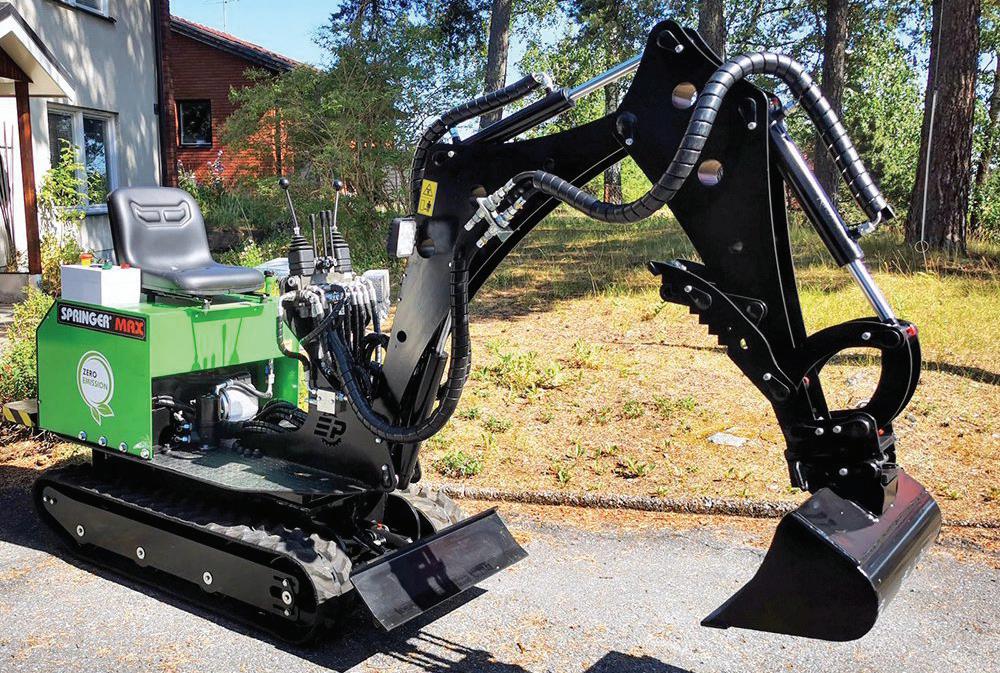
Elgo-Plus, a manufacturer of mini-excavators, has introduced the Springer Max-EB electric mini-digger.
e compact, battery-powered unit can work in conned spaces, is capable of fast recharging, and complies with the sort of carbon and noise emissions restrictions typically found in urban environments. A notable feature is its ability to rotate 360°.
e Springer Max-EB is 2.6 feet (80 cm) wide and features a 3 kW 48 V electric motor from Benevelli.
e Brześć Kujawski, Poland-headquartered company opted to go with Briggs & Stratton for the Springer Max-EB’s battery needs based on past experience with the company.
“ e Briggs & Stratton Vanguard lithium-ion Fi7.0 batteries answered every requirement and have delivered excellent results in terms of productivity and performance,” said Andrzej Zielinski, the company’s CEO.
e Springer Max-EB’s energy is supplied by two Vanguard 48 V 7.0 kWh xed battery packs that support a running time of ve hours. Charging takes four hours using a standard 230 V charger, but charging speed increases when using a 400 V charger, the company said.
Tomas Mika, Manager for Regional Sales in Central Europe at Briggs & Stratton, said that Elgo-Plus’s choice of his rm as its battery supplier was “ideal” because of the Max-EB’s “compact design, power density and lengthy continuous runtime.”
e new battery-powered digger is available now throughout Continental Europe. It comes with a Danfoss Turolla Shark 6 cc hydraulic pump, a Vanguard 1,050 W onboard charger, a charging cable, a ripping tool, three buckets and LED lights. It has an MSRP of €20,800.





What will be one of the world’s greenest airline terminals when it opens in 2026 is about to get a little greener. e New Terminal One at John F. Kennedy International Airport in New York has selected ground support equipment provider TCR to out t the new terminal with an all-electric ground service eet.
All ground service equipment at the terminal, including aircra towing vehicles, passenger boarding stairs, aircra refueling trucks, cargo handling equipment and baggage loaders, will be powered by electricity.
e shared GSE eet will support the Port Authority’s goal of achieving net zero greenhouse gas emissions from the region’s airports by 2050, a spokesman for the New Terminal One said.
John F. Kennedy International Airport is the busiest airport for international tra c in North America. e New Terminal One is being developed as part of an ongoing $19-billion redevelopment project that includes the 2.4-million square-foot (226,967-square-meter), 23-gate terminal. When the new terminal opens, it will be more than twice the size of the current Terminal 1, which opened in 1998.
e New Terminal One will occupy not only the current Terminal 1 site but also the sites of the former Terminals 2 and 3, anchoring the airport’s southern border.
Herbert Muschamp, the New York Times architecture critic, called Terminal 1 “spi y” when it opened and noted it o ered “style and comfort for jaded passengers.” In his review, he wondered out loud, “Why was Kennedy ever allowed to deteriorate to such a scandalously decrepit state?” He also gave it an A+ in way nding: “Clarity is the new terminal’s great virtue. You always know where you are and where you’re going.”
Meanwhile, the New Terminal One will—quite appropriately—have what its creators have said is the largest airport solar array at any US airport, one that will provide 50% of the terminal’s electric power.
“ is marks the rst time that any airport terminal in the world has procured a centralized all-electric GSE eet,” an airport spokesperson said. “ is shared model reduces environmental impact, improves costs and optimizes equipment usage, in contrast to the conventional model where ground handlers individually own or lease their own equipment.”
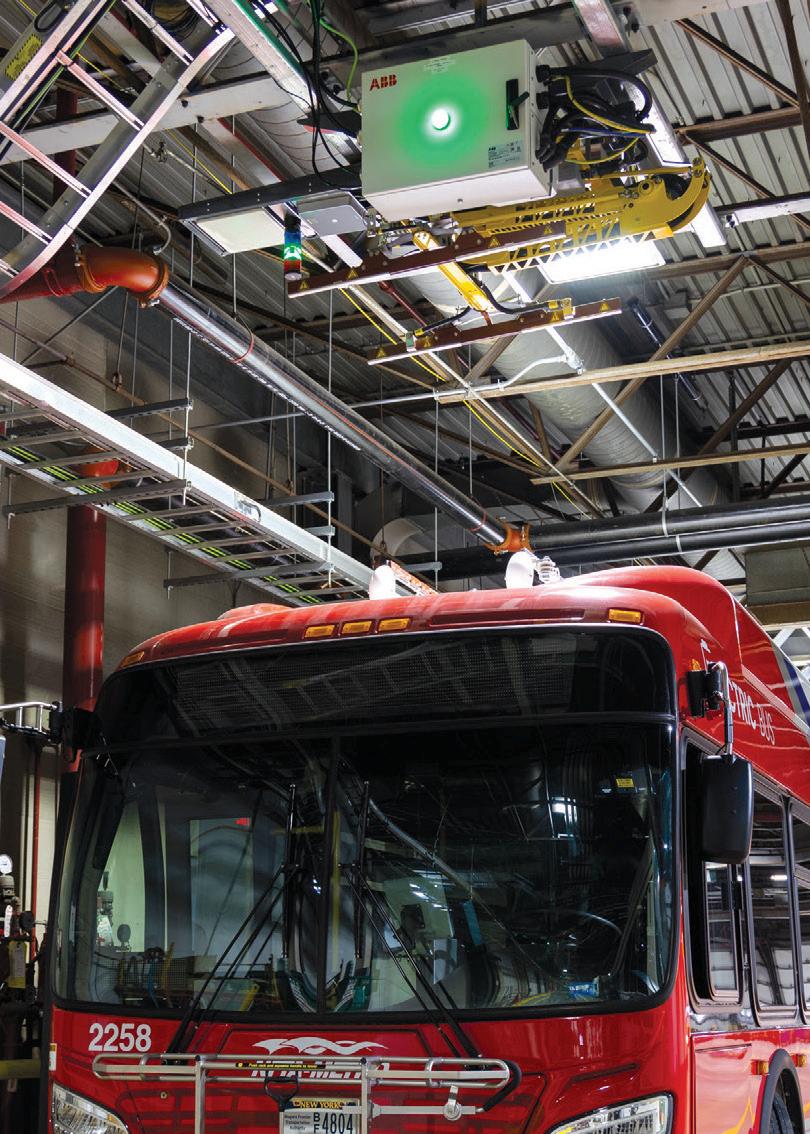

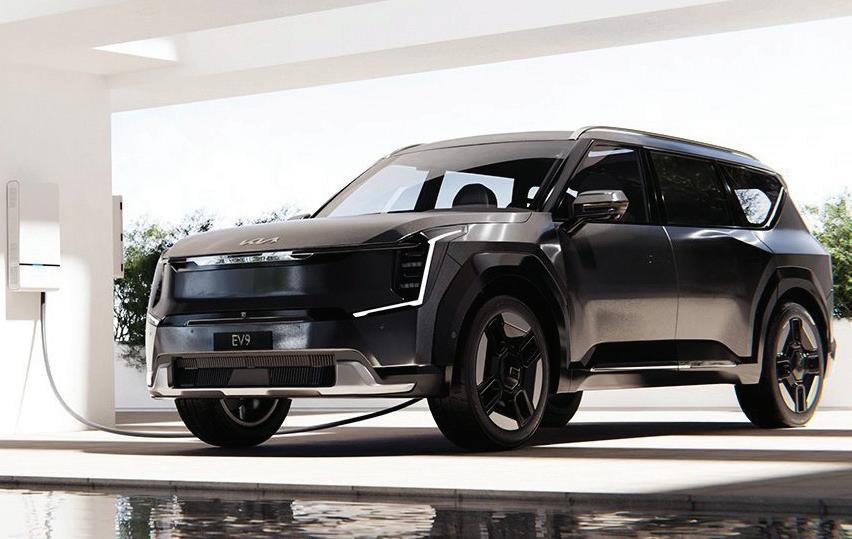
EV charging hardware manufacturer Wallbox has taken a step towards the day that EV drivers will be able to use the batteries in their vehicles to provide backup power for their homes and to save money on their electric bills. e company is now taking pre-orders for its new bidirectional DC charger, the Quasar 2, for eligible Kia EV9 owners and lessees.
e Quasar 2, along with the Wallbox Power Recovery Unit, enables the Kia EV9’s battery to provide backup power to a home.
If you are fortunate enough to live in a place where your local utility o ers time-of-use pricing, you can charge your EV when rates are low, and discharge energy to your home during peak hours. e Quasar 2 also enables an EV to be charged directly from a solar installation—this can save you money if your local utility’s net metering policy is disadvantageous.
e Quasar 2 is designed to work with the Kia EV9— and it will initially be sold in “limited quantities” in California, Texas, Florida, New York, Washington, New Jersey and Illinois.
e CCS1 connector supports both AC and DC charging. Maximum power transfer is 12.8 kW in both directions.
Quasar 2, including the Power Recovery Unit, will retail from $6,440, excluding taxes and installation fees. Installation must be done by Wallbox’s o cial installation provider, COIL, or “another certi ed third-party installation provider.”

EV pioneer Lucid Motors has bought an Arizona factory and other assets from bankrupt EV maker Nikola.
Lucid laid down some $30 million in cash and noncash considerations in exchange for the factory, Nikola’s lease on its Phoenix headquarters, and “certain machinery, equipment and inventory,” according to a court ling. Experts have estimated that Lucid would have spent several times that sum to build a new factory. e facilities Lucid bought are near its existing factory in Casa Grande, Arizona.
As part of the deal, Lucid will o er to hire around 300 former Nikola employees, the company told TechCrunch. Positions will be o ered to both salaried and hourly employees in manufacturing, engineering, so ware, assembly, vehicle testing and warehouse support.
“As we continue our production ramp of Lucid Gravity and prepare for our upcoming midsize platform vehicles, acquiring these assets is an opportunity to strategically expand our manufacturing, warehousing, testing, and development facilities while supporting our local Arizona community,” said Marc Winterho , Lucid’s interim CEO.
Nikola had a colorful history—it was an early proponent of hydrogen fuel cell vehicles before partially pivoting to BEVs. (Lucid chose not to acquire any of Nikola’s hydrogen-related assets.) Some of the company’s claims turned out to be a bit fanciful, and founder Trevor Milton was convicted of fraud in 2022. (He received an executive pardon in March.)




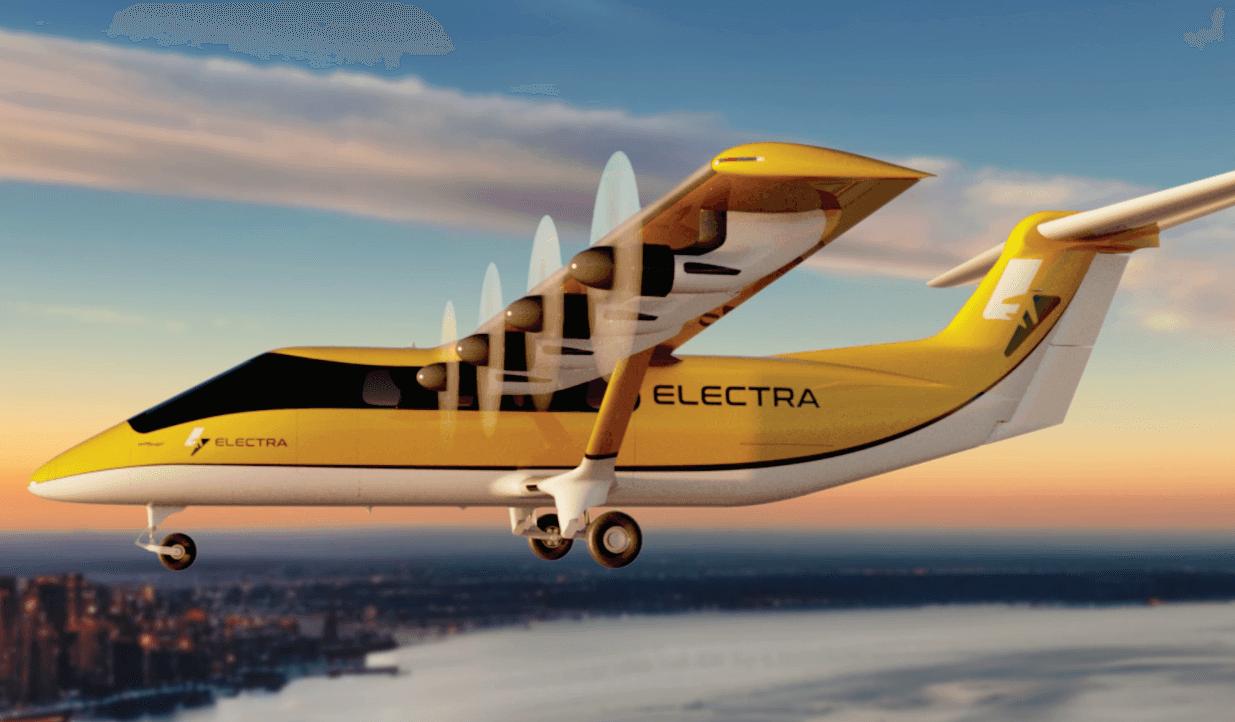
Electra Aero, a maker of hybrid electric short takeo and landing aircra , says it has received some 2,200 preorders, worth about $9 billion, for its new EL9 Ultra Short hybrid electric aircra .
e aircra manufacturer’s mission statement reads that the company was founded to “provide a ordable air travel without airports, emissions or noise.”
e Ultra Short integrates blown li and hybrid electric propulsion to take o and land in just 150 feet (46 m) of runway or the equivalent. It has eight electric props along the leading edge of the wings, as well as large aps hanging from the trailing edges. e combination allows the aircra to exploit the blown li aerodynamic e ect su ciently to enable a rotation speed of just 35 mph (56 km/h).
e aircra ’s ability to land on unpaved surfaces also makes it potentially useful for companies that have traditionally used o -highway vehicles that travel on land, such as construction and mining rms, enabling them to bring construction supplies to distant sites by air.
Once in service, the Ultra Short will be able to accommodate a pilot and nine passengers with luggage or 3,000 lbs (1,361 kg) of cargo. e company says it will have a cruising speed of 200 mph (322 km/h) and a range of 1,100 nautical miles (1,266 miles or 2,037 km). e company also claims that the aircra will be capable of in- ight battery recharging.

TIT Imhof, a transport, construction and disposal company based in Kreuzlingen, Switzerland, has added an electric FUSO eCanter 9C18e skip loader to its truck eet. e 8.55-tonne light-duty truck, which includes a type AK4V skip loader from Meier-Ratio, transports empty containers to customers and hauls the full containers to Imhof’s disposal center in Kreuzlingen.
Imhof’s eCanter has a range of up to 140 kilometers. e company charges it overnight at a DC charging unit in its yard. e skip loader body can li containers ranging from one to ten cubic meters in size and up to 4.5 metric tons in weight.
“ e eCanter perfectly meets our requirements and, above all, the payload of 3.3 tons is ideal for container transport,” says company owner Dominic Imhof.
“One of my favorite features is the electric power takeo (ePTO) in the eCanter,” says driver Jozef Peciar. “I press the button and the drive starts immediately. at’s not always the case with diesel-powered trucks. It o en takes a while for the pump to start up.”
Dominic Imhof notes yet another advantage of the EVs in his eet: “We didn’t even consider how quiet electric mobility would make our working environment. It’s another e ect that everyone now really appreciates.”
Electric trucks will be exempt from Switzerland’s Heavy Vehicle Charge (HVC) until 2030. is fee amounts to around one Swiss franc ($1.15) per kilometer for a 40-tonne truck. Also, as of this year, Switzerland has introduced CO2 taxation on vehicle imports. Exemption from these two expenses makes the total cost of ownership of the locally emission-free FUSO eCanter attractive despite higher purchase costs.





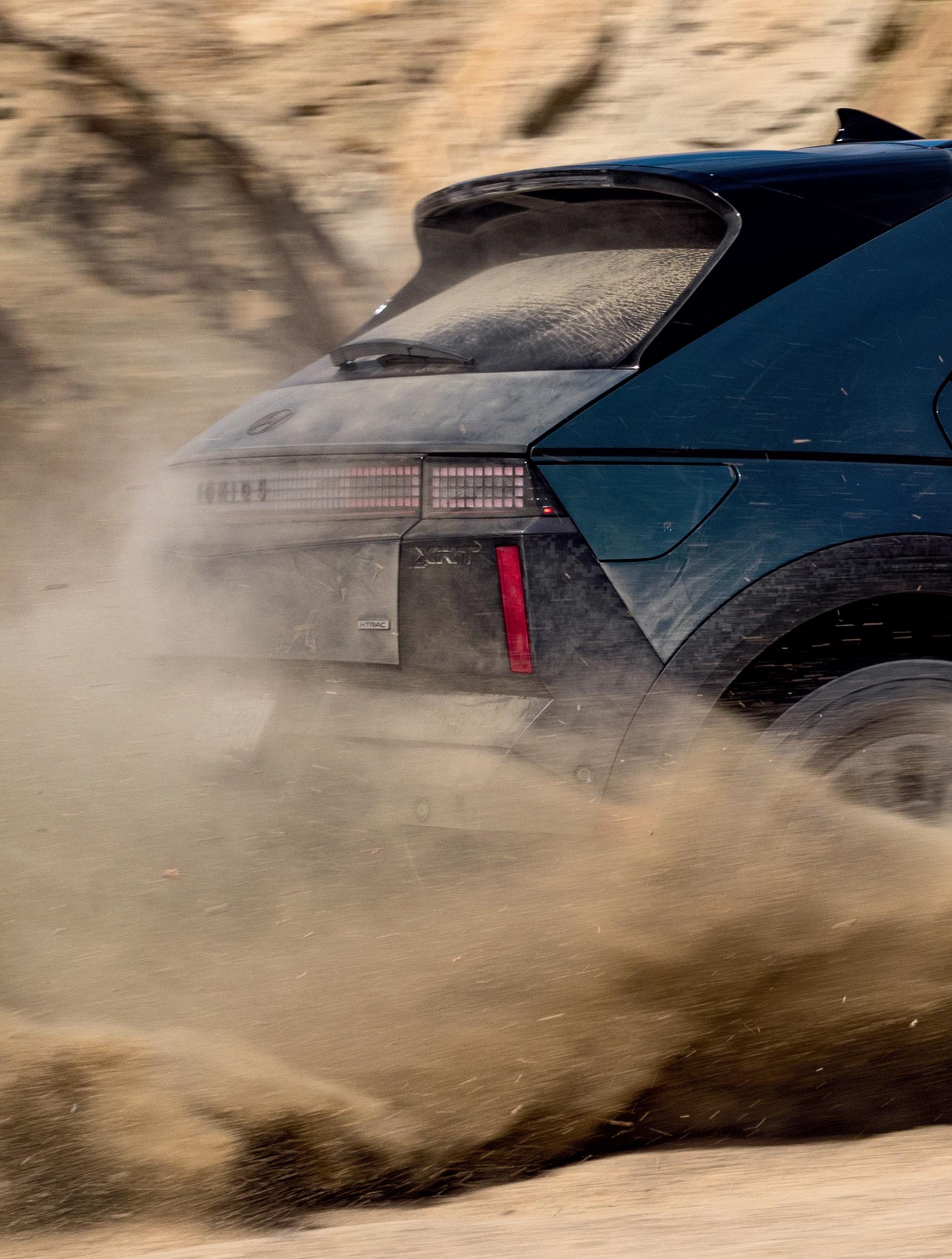





It’s still the Ioniq 5 you know and love, with some useful tweaks plus hot-rod and XRT versions.
By John Voelcker
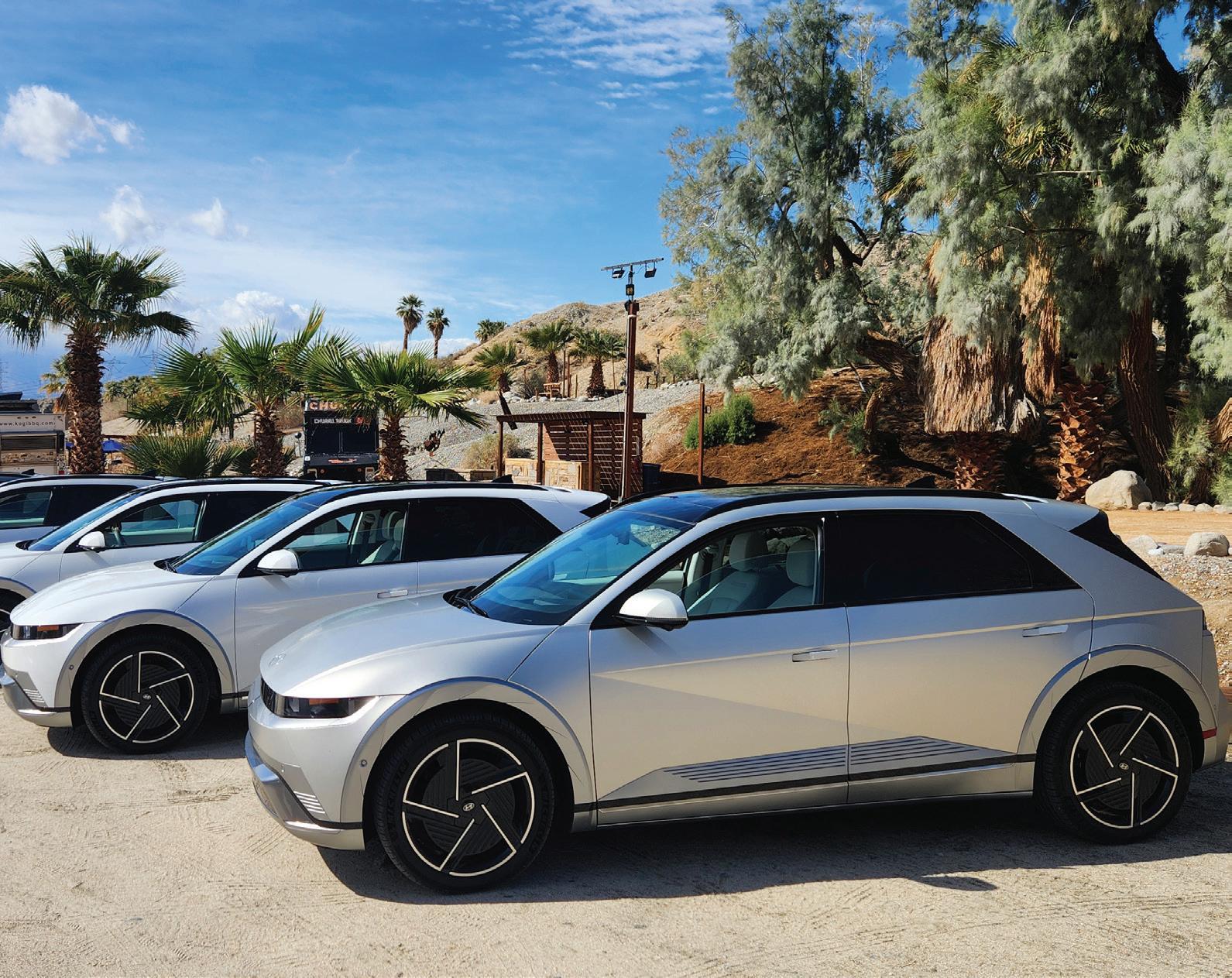


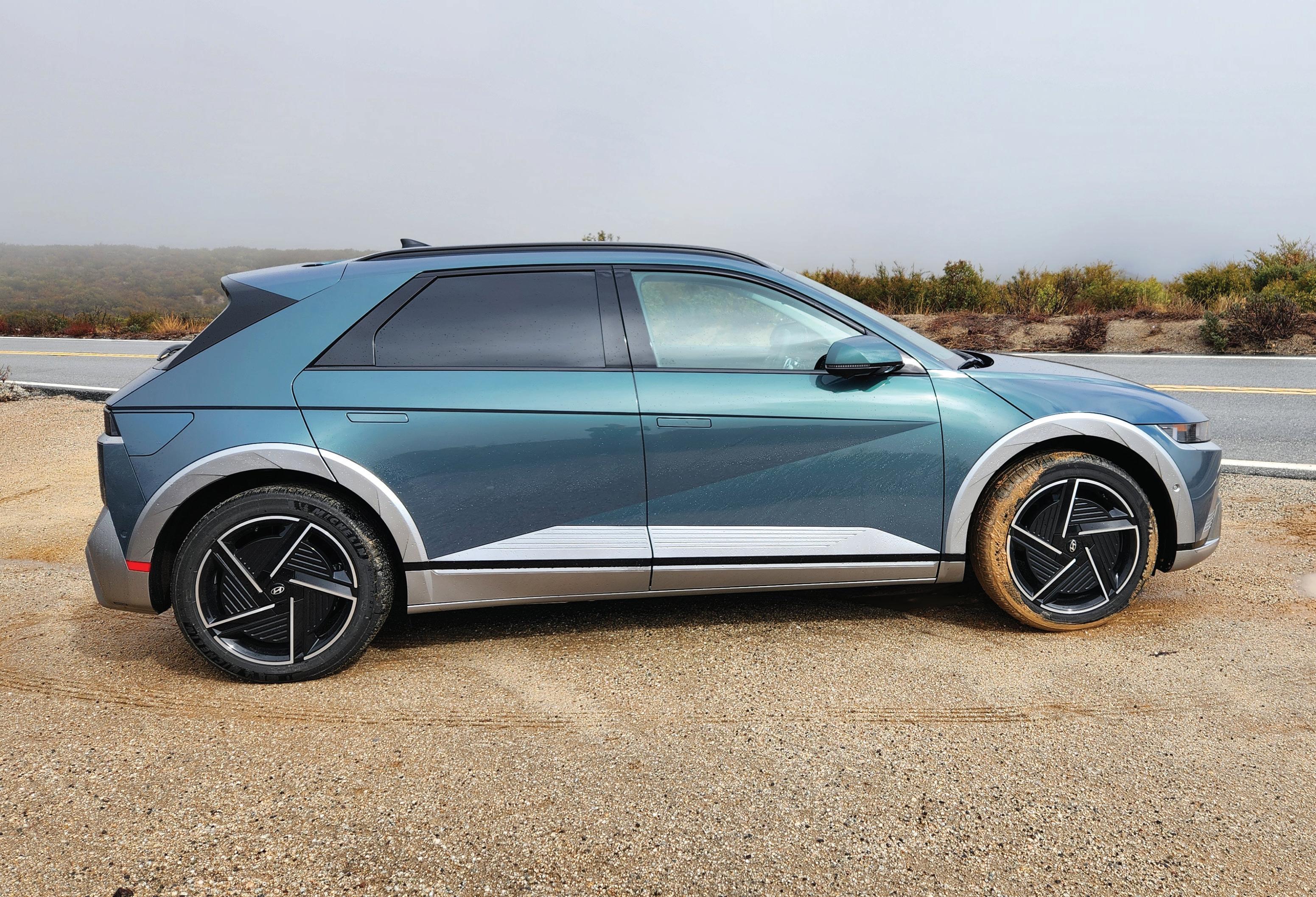
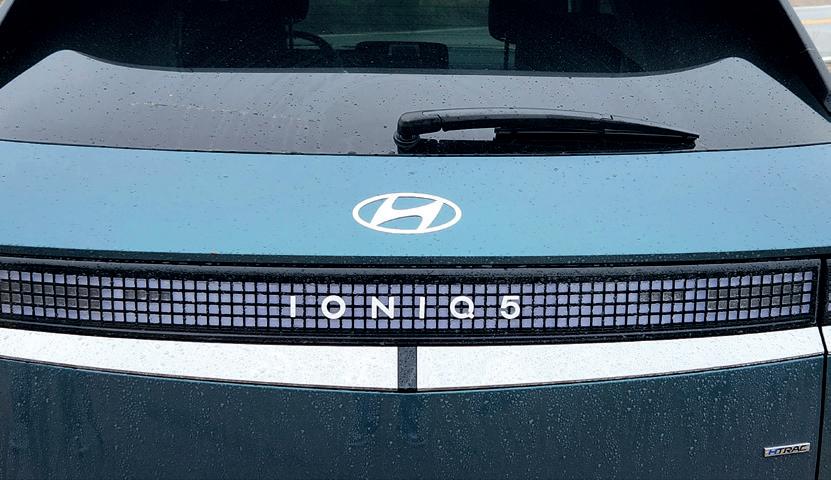

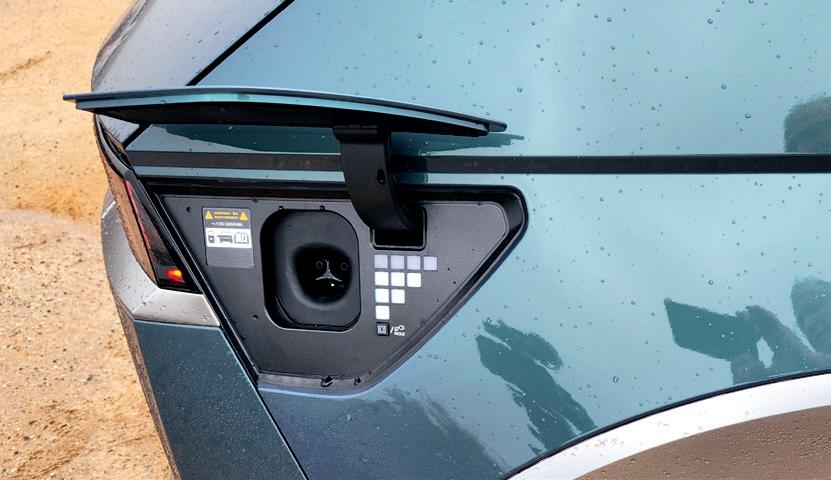


The Hyundai Ioniq 5 crossover utility vehicle is now a familiar site in regions where electric cars are popular. Entering its fourth model year in North America, the square-edged hatchback gets some minor updates to styling, inside and out, and to its mechanical specs and charge port.
It also adds two new versions that greatly expand the range. e Ioniq 5 N is the wild-child, high-performance hot rod version—one so well executed and such fun to drive that it’s won multiple awards in multiple countries. For a di erent audience, the Ioniq 5 XRT is an o -roadin ected model with more ground clearance, brawnier tires, and an added overlay of butch in its trim. So far it’s sold only in North America.
Rather to the industry’s surprise, Hyundai sold more EVs in the US in 2024 than any maker except Tesla—beating Ford, GM and BMW in volume. Its electric mainstay, the Ioniq 5, had its best year ever in 2024—sales were up 31 percent to 44,400 (note that the Tesla Model Y sold nine times that number). And the company, long one to watch in EVs, isn’t letting up at all on its battery-powered e orts. To that end, all 2025 Ioniq 5s sold in North America except the 5 N are now built at Hyundai’s new Metaplant in Ellabell, Georgia, about 25 miles outside Savannah.
We’ve only gotten an hour or so with the 5 N, but eagerly await the loan of one. Meanwhile, we spent Valentine’s Day driving both the updated 2025 Ioniq 5 and new Ioniq 5 XRT in and around Palm Springs, California.
You’ll be forgiven for not noticing the exterior changes in the 2025 Hyundai Ioniq 5. ere are new wheel designs, and the front fascia—the plastic shield below the sheet metal—is slightly taller and squarer, with a protruding lower edge that makes it “more robust, more crossover-like,” in the words of Head of Exterior Design Brad Arnold. e best way to tell a 2025 from its older brethren, in fact, may be the presence of a rear wiper—a much-requested item among owners. e interior got somewhat more substantial changes. e company responded to owner feedback by adding knobs and buttons for audio volume and HVAC (heating, ventilation, air conditioning) controls like heated seats and steering wheel. at puts Hyundai very much on trend: hard controls are coming back a er years of makers moving everything possible into the central touchscreen, o en distracting drivers at speed who must hunt through menus for a speci c function.
To the industry’s surprise, Hyundai sold more EVs in the US in 2024 than any maker except Tesla.


The 2025 Ioniq 5 range gets new and updated cells. Battery capacity and EPA-rated range improve across the board.
All 2025 Ioniq 5 versions now get dual 12.3-inch screens and USB-C ports—and Android Auto and Apple CarPlay remain standard, both wirelessly and via cable. ey also get Hyundai Pay, which the company suggests will soon be usable to pay for parking and/or charging. We’d probably prefer standard Plug and Charge, but we’ll hold o on that judgment until we try it.
A bit more battery, a bit more range
e 2025 Ioniq 5 lineup has new and updated battery cells. Battery capacity and EPA-rated range have been improved across the board. e Standard Range pack goes from 58 to 63 kilowatt-hours, while the Long Range pack grows from 77.4 to 84 kWh. Rated range for all-wheel-drive versions rises accordingly, from 260 to 290 miles (SE and SEL) or 269 miles (Limited). All three trims with rearwheel-drive go from 303 to 318 miles, while the Standard Range version with its smaller pack stretches from 220 to 245 miles. Finally, the new-for-2025 Ioniq 5 XRT with standard AWD is EPA-rated at 259 miles.
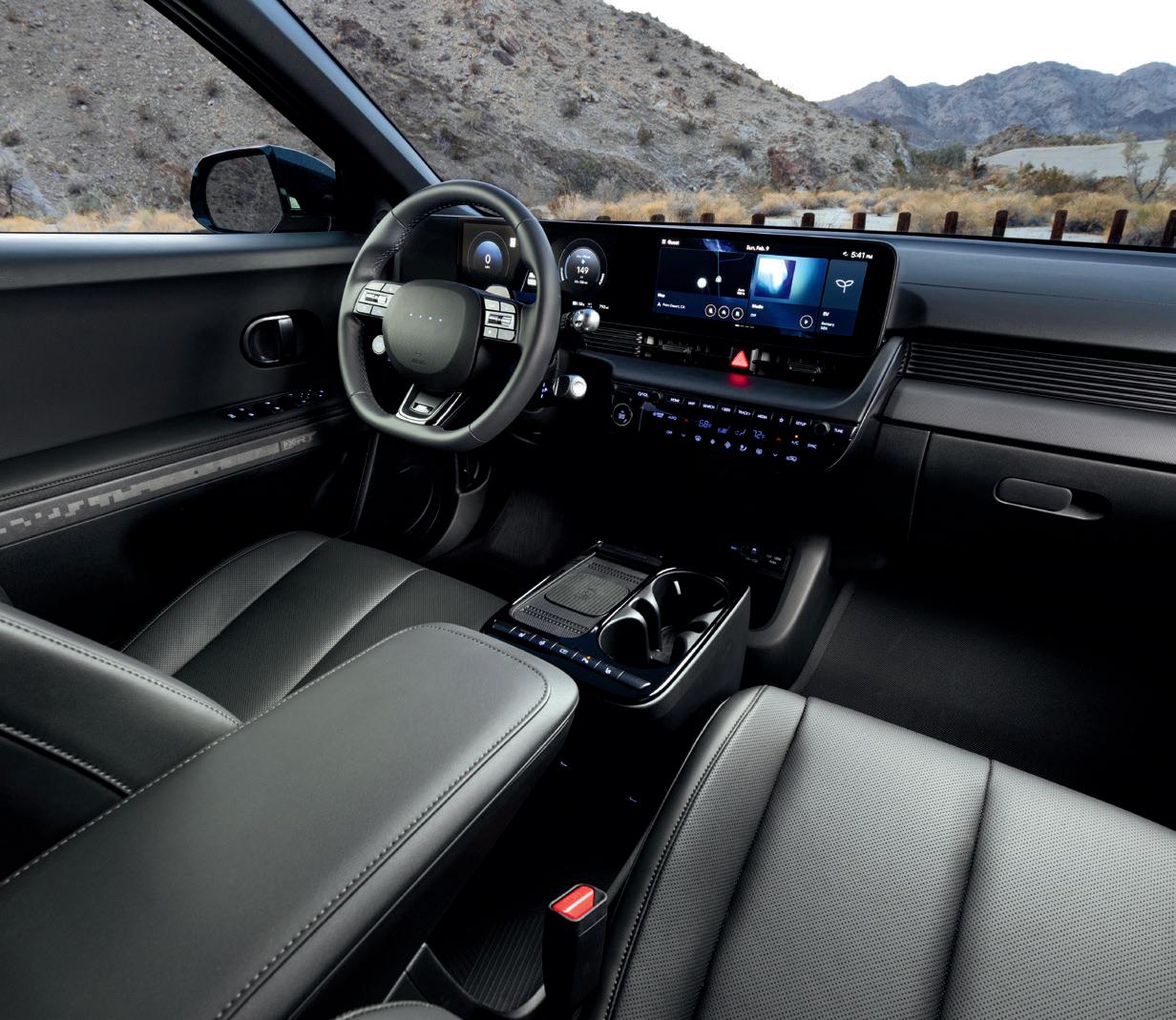
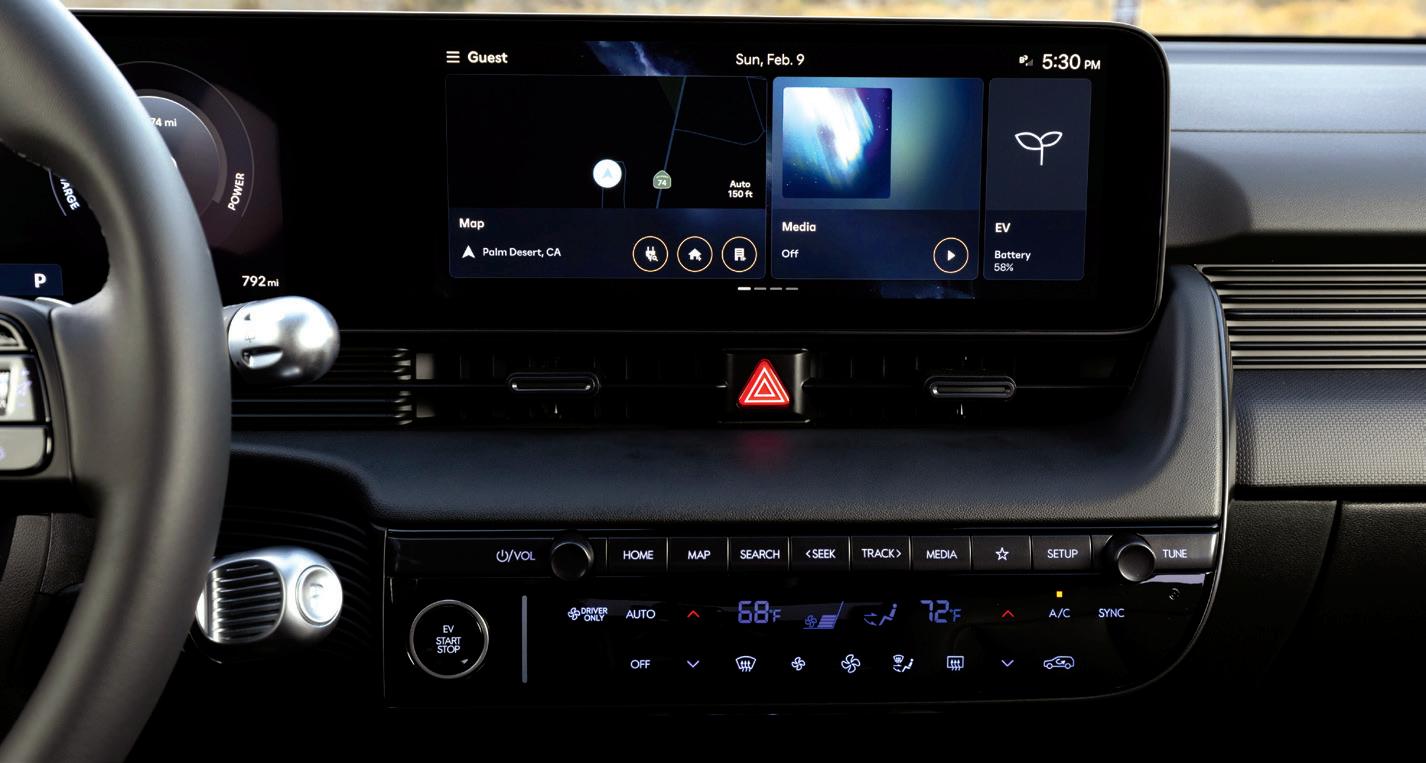
On the road, the latest Ioniq 5 feels...well, pretty much like the previous three years’ models. e ride is just this side of so , in contrast to Tesla’s more BMW-like suspension tuning. But the Ioniq 5 hung on perfectly well as we tossed it through twisty mountain roads—at least until we rose above the snow line around 6,000 feet.
Hyundai continues to o er three levels of regenerative braking, as well as its i-Pedal one-pedal drive mode. Annoyingly, while the regen level persists through power cycles, i-Pedal doesn’t. You have to remember to ask for it each time you start the car, an issue that GM, Ford and others conquered as much as a decade ago. Why? Hyundai execs couldn’t say.



All US-built Ioniq 5s—meaning the whole lineup except the hothatch 5 N version, built only in South Korea— come with NACS charging ports as standard.
In the o -road portion of our test day, the Ioniq 5 XRT (the name stands for Extreme Rugged Terrain) coped ne with rutted, ridged, bumpy trails in so sand, and an occasional rocky path as well. It’s hardly a rock-climbing monster like a Jeep Wrangler, however, and isn’t meant to be. Instead, it’s probably best suited to people like this reviewer. In snowy winter weather, my rocky, curving, uphill driveway in the Catskill Mountains is steep enough that it’s pretty much impossible for any front-wheel-drive vehicle to climb—and ground clearance gets a lot more important.
For more details on the Ioniq 5 XRT, see page 58 for a comparison of that model against the Ford Mach-E Rally, the equivalent trim for the electric Mustang SUV (which outsold the gasoline Mustang last year…but we digress).
A nal note on equipment: All US-built Ioniq 5s—meaning the whole lineup except the hothatch 5 N version, built only in South Korea— come with NACS charging ports as standard. Hyundai moves fast—those cars are the very rst ones o ered in the US with native NACS ports other than Teslas. Laudably, Hyundai includes a CCS-toNACS adapter with every new Georgia-built Ioniq 5—and it will soon announce a program to allow owners of its CCS-equipped EV models to get a free NACS-to-CCS adapter, letting them take advantage of the Supercharger network too.
Using the adapter provided with a 2025 Ioniq 5, a CCS charging cable capable of delivering 257 kW can charge any Ioniq 5 from 10 to 80 percent in just 20 minutes. Hyundai has also added the ability for drivers to precondition the battery if they’re headed for a charging station—even if they haven’t put it into the navigation as a destination, which triggers battery conditioning if needed.
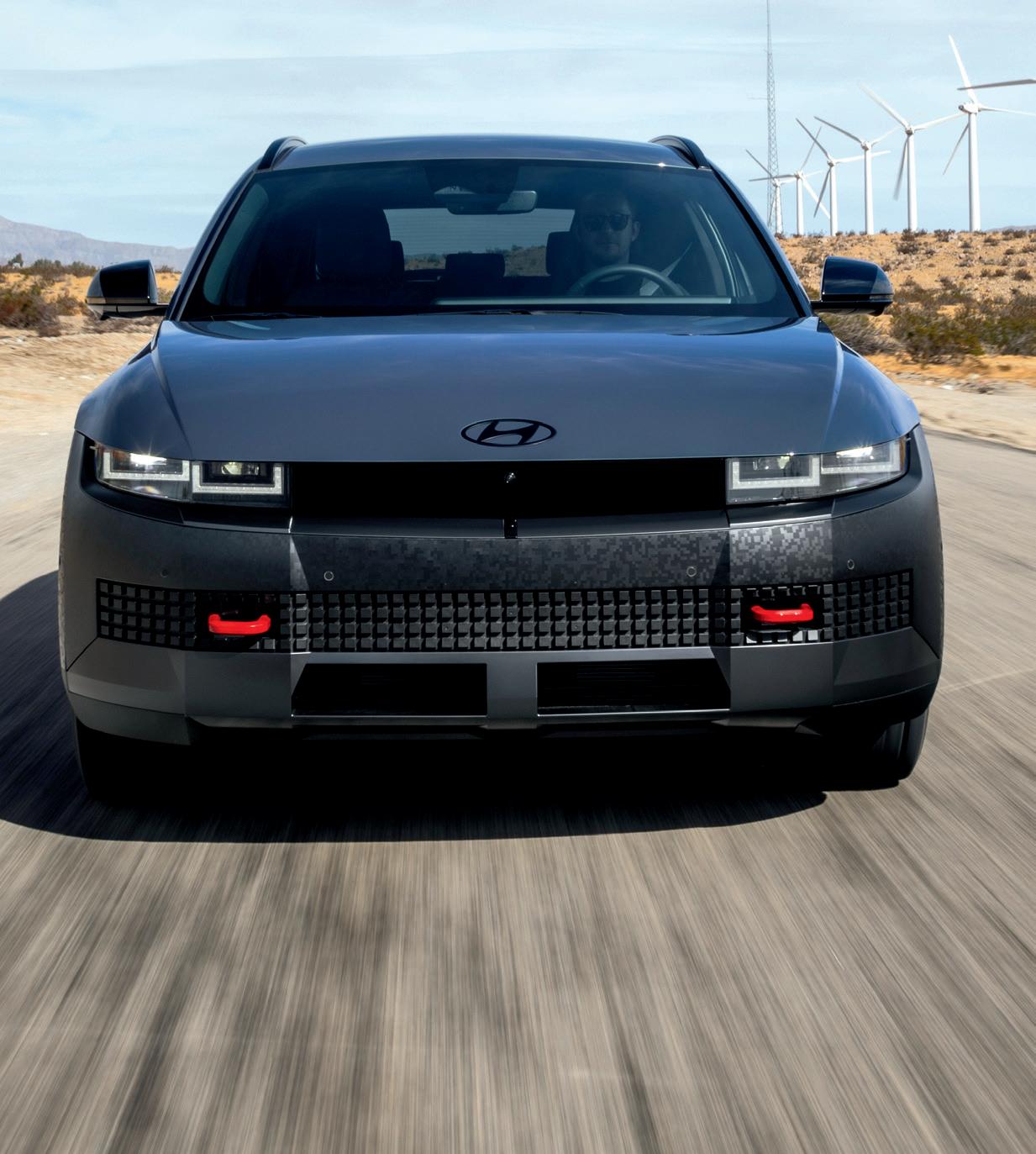

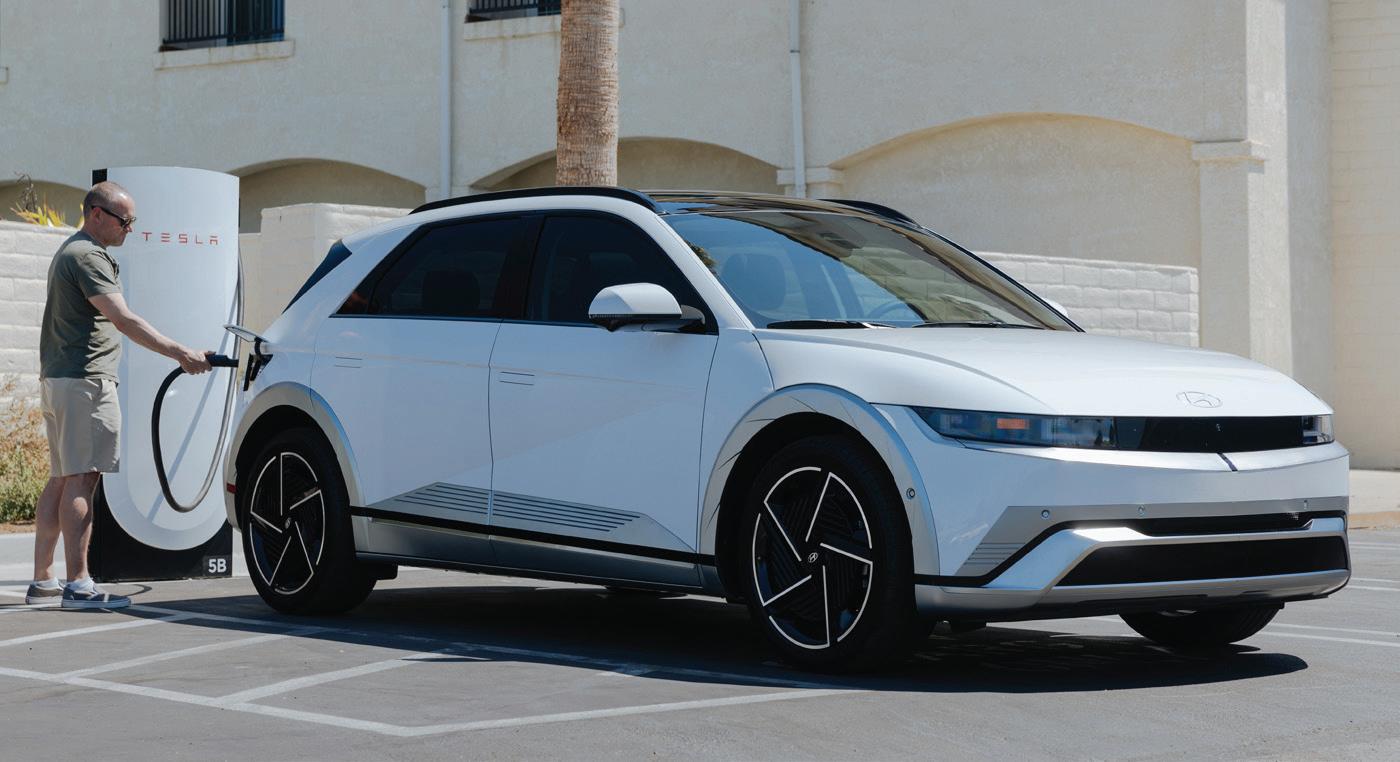
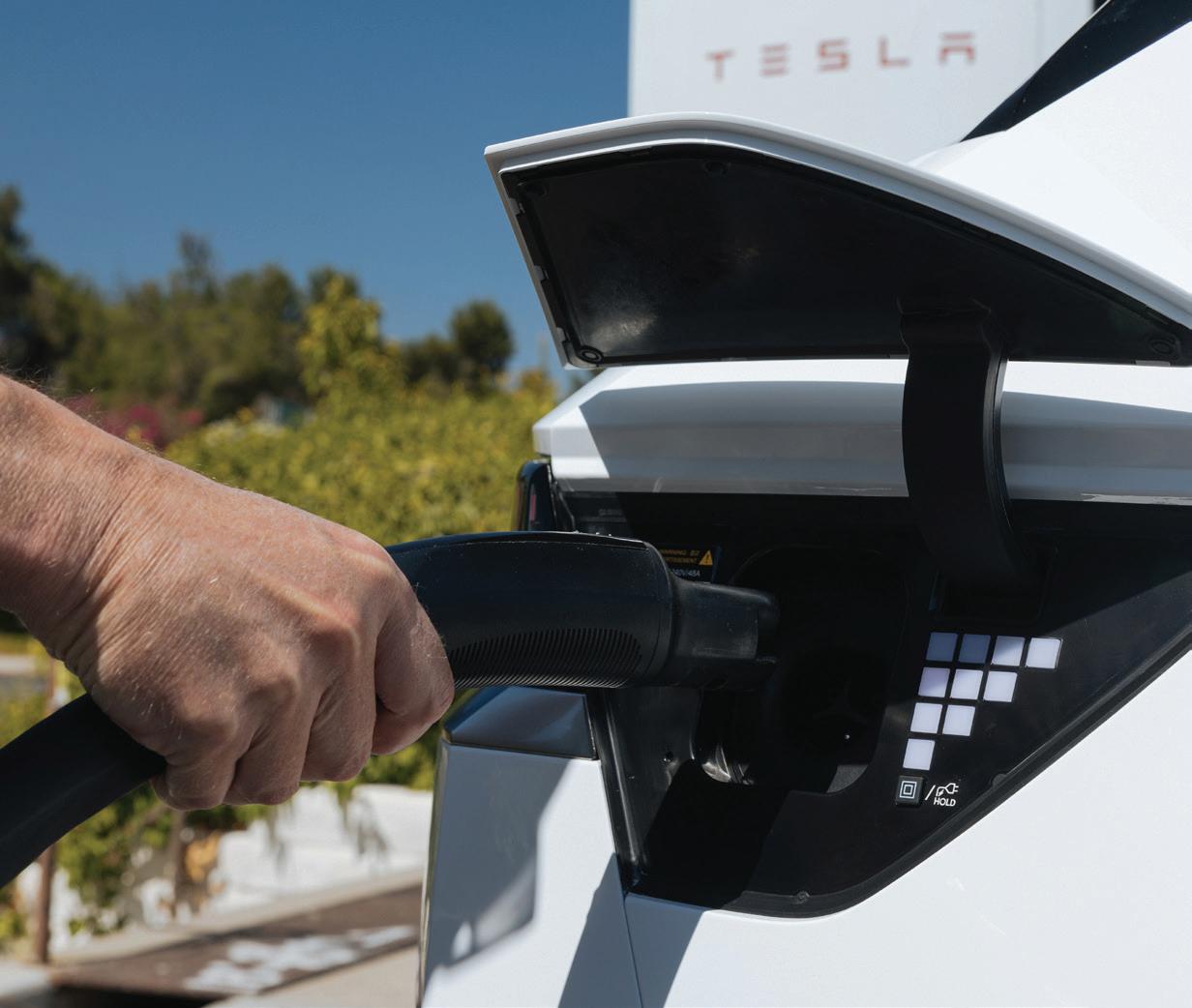






SCAN FOR YOUR FREE EXPO PASS










SHOWCASING THE LATEST ADVANCEMENTS IN INDUSTRIAL VEHICLE TECHNOLOGY
REVOLUTIONIZING THE OFF-HIGHWAY VEHICLE SECTOR



130+ EXHIBITORS













2000+ VISITORS 50+ SPEAKERS
2000+ VISITORS 50+ SPEAKERS
Discover cutting-edge innovations from leading suppliers, gain insights from an expert-led summit tackling the industry’s biggest challenges, and connect with engineers, OEMs, and key decision-makers!
Meet top suppliers showcasing groundbreaking innovations, hear industry experts tackle critical challenges at the Off-Highway Evolution Summit, and network with key decision-makers shaping the industry!


AUGUST 20 & 21, 2025
DONALD E. STEPHENS CONVENTION CENTER, CHICAGO, USA
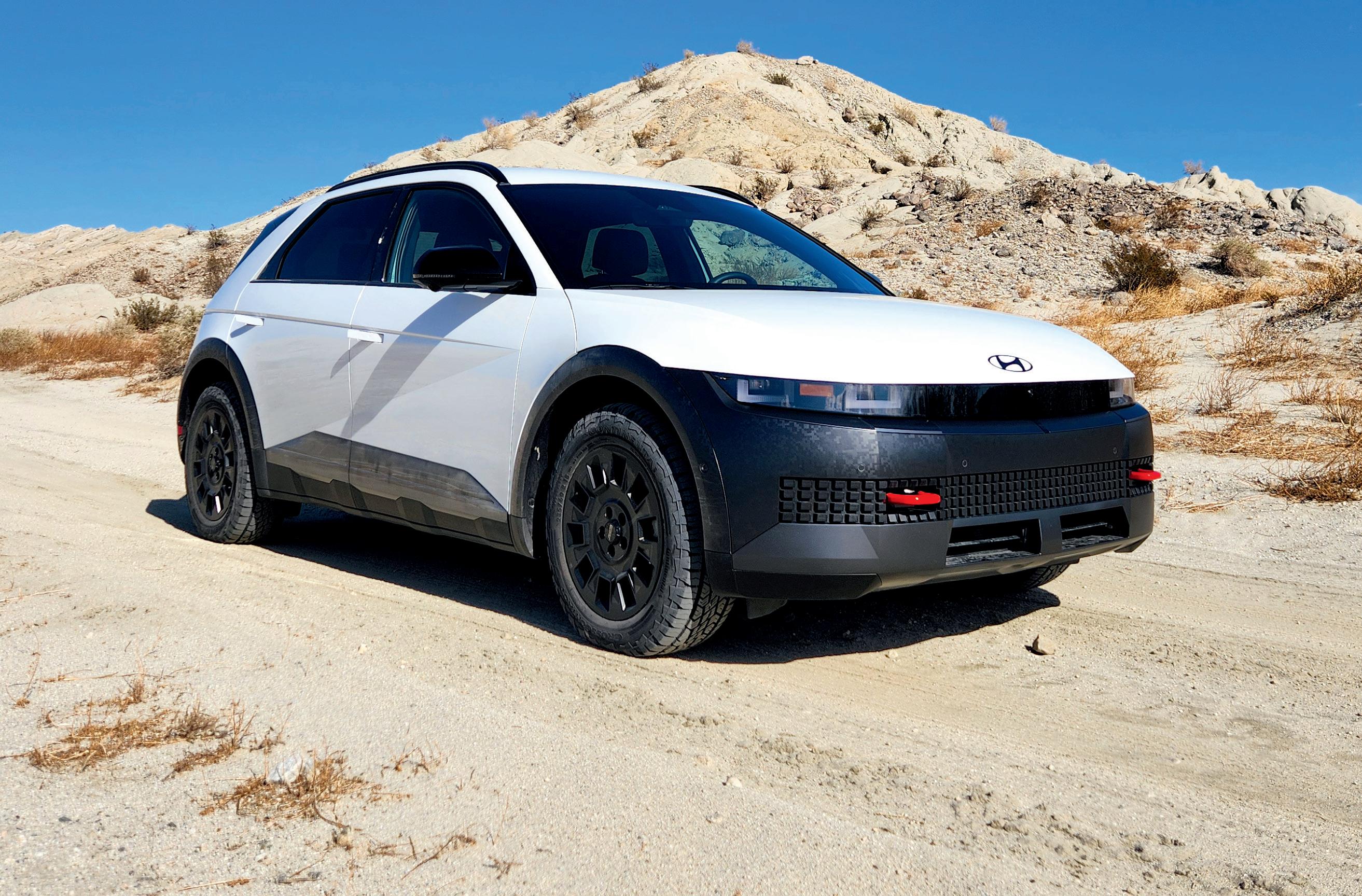
Ioniq 5s will still charge faster at CCS fast charging stations than at Tesla Superchargers, though, due to the E-GMP platform’s 800-volt battery architecture. Version 3 Tesla Superchargers charging an Ioniq 5 will peak at roughly 135 kW, meaning they will take 30 minutes from 10 to 80 percent for a Long Range Ioniq 5 or 24 minutes for a Standard Range model. (Upcoming Version 4 Superchargers switch from low-voltage, high-current power delivery to higher voltage with lower current, meaning they should charge just as fast as CCS.)
As for overnight charging, with an 11-kilowatt onboard charger, Hyundai quotes Level 2 charging times from 10 to 100 percent at 7 hours, 20 minutes for the Long Range pack and 5 hours, 40 minutes for the Standard pack. Hyundai believes the offer of free home charging sells more EVs. To that end, it includes a free ChargePoint Level 2 charging station with every Ioniq 5—or, for owners who can’t use it or already have one, a $400 credit to use at public charging stations. Hyundai does not, however, go as far as Ford—the Dearborn automaker throws in not just a free charging station but free “standard” installation as well—and it credited its Ford Power Promise program with its highest-ever quarterly sales of the Mach-E crossover in Q4 2024.
The 2025 Hyundai Ioniq 5 range starts with the SE Standard Range, with its lower-capacity battery and no allwheel-drive option, priced at $43,975. Rear-wheel-drive SE and SEL trims are $48,025 and $50,975 respectively; AWD
Hyundai includes a free ChargePoint Level 2 charging station with every Ioniq 5, or a $400 credit to use at public charging stations.
adds $3,500 to each. The top-of-the-line Limited model costs $53,675 (RWD) or $59,575 (AWD), and the new XRT model is $56,875 with AWD standard. At present, Hyundai isn’t offering a la carte options for the lineup. All prices quoted include the mandatory delivery fee of $1,475.
All 2025 Ioniq 5 SE, SEL, Limited and XRT versions are built in Georgia and come with a NACS port as standard. Hyundai expects to switch to battery packs with US-built cells for those models, perhaps as soon as March, which would qualify them for the full EV purchase incentive—if it remains in force. The 2025 Ioniq 5 N performance model is built only in South Korea, and it continues to come with a CCS port “for the moment,” though Hyundai execs hinted that it will be updated to align more closely with the USbuilt cars in future.
Hyundai provided airfare, lodging, and meals to enable Charged to bring you this first-person drive report.

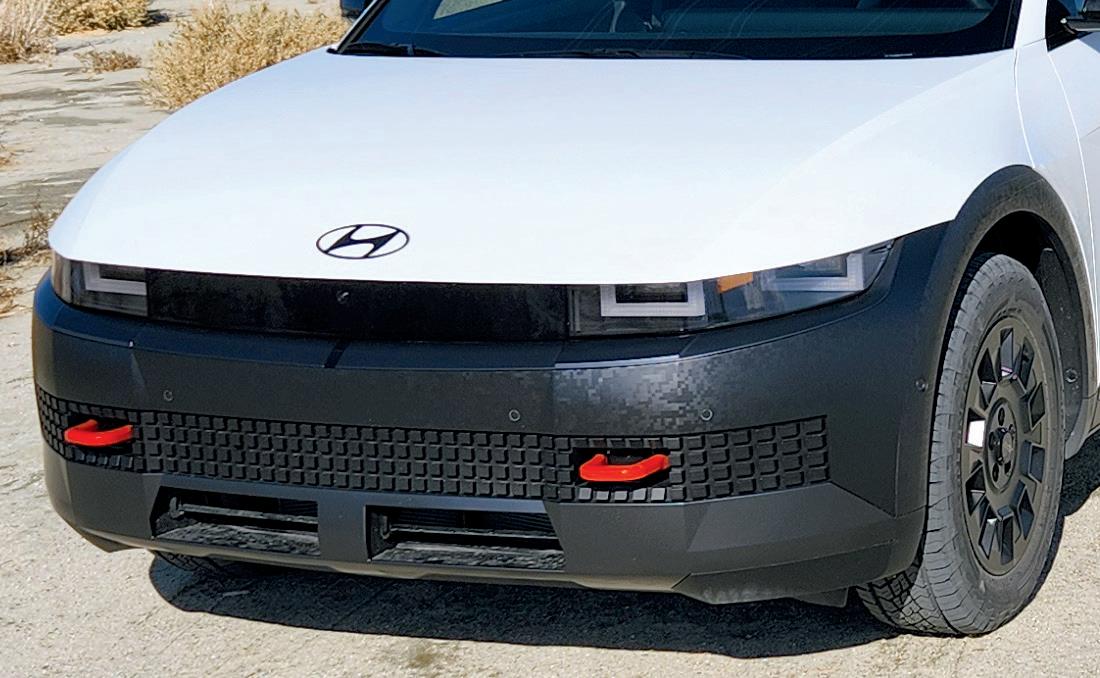
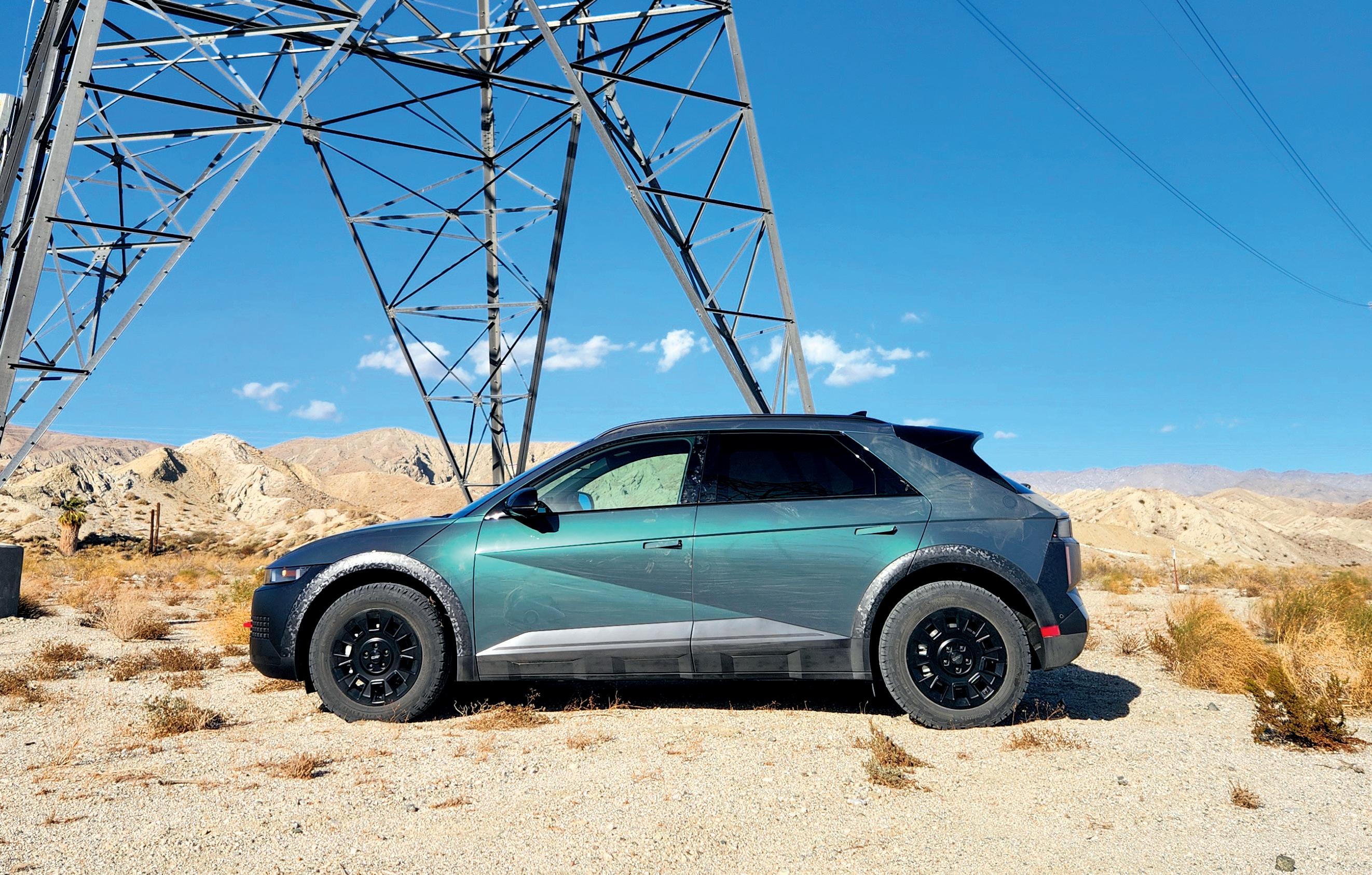







By John Voelcker

Unlike the mountain-goat Jeep Wrangler or Subaru Crosstrek, these tougherlooking EVs aren’t meant for true back-country off-roading—and they trade range for ground clearance.



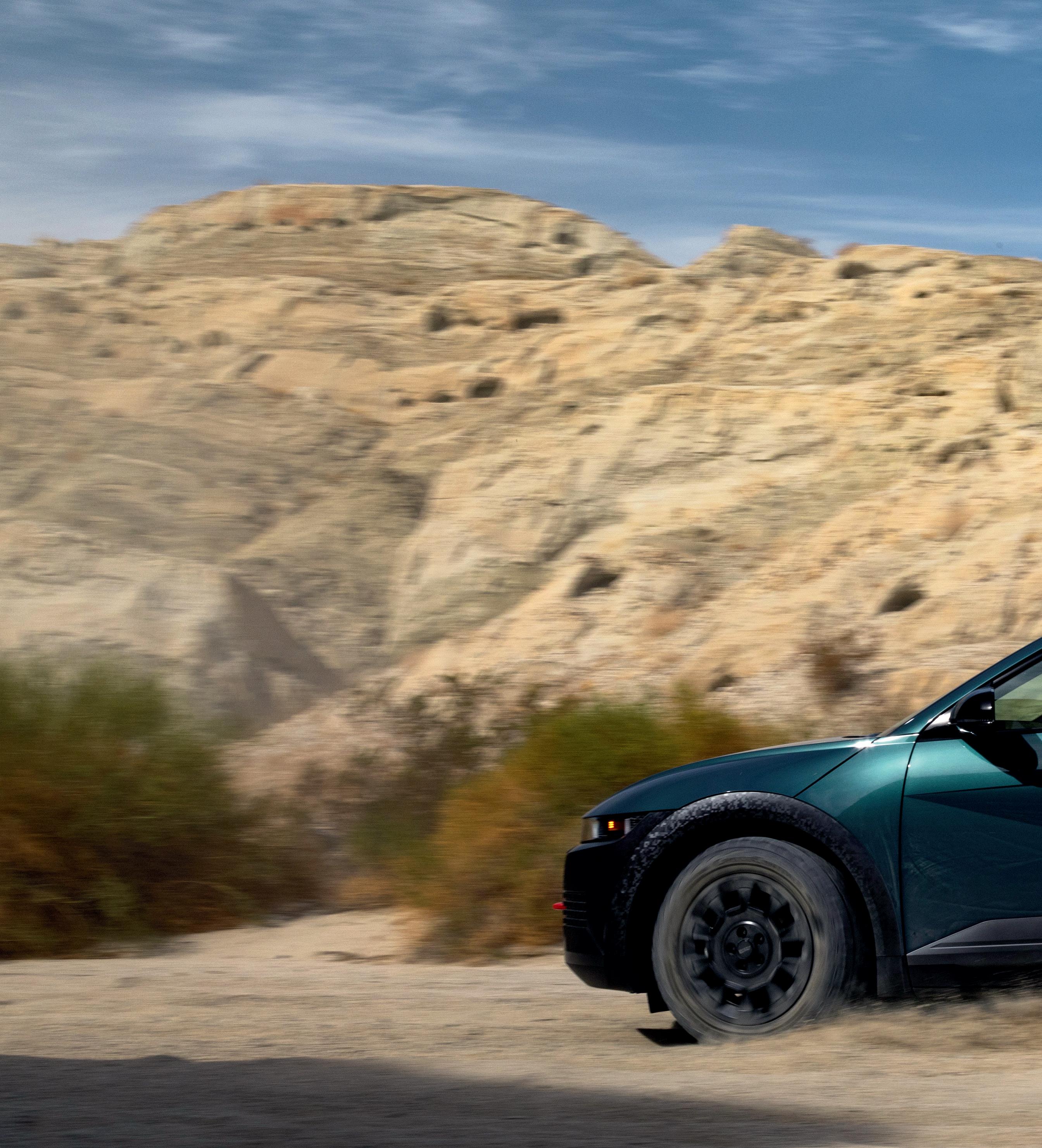


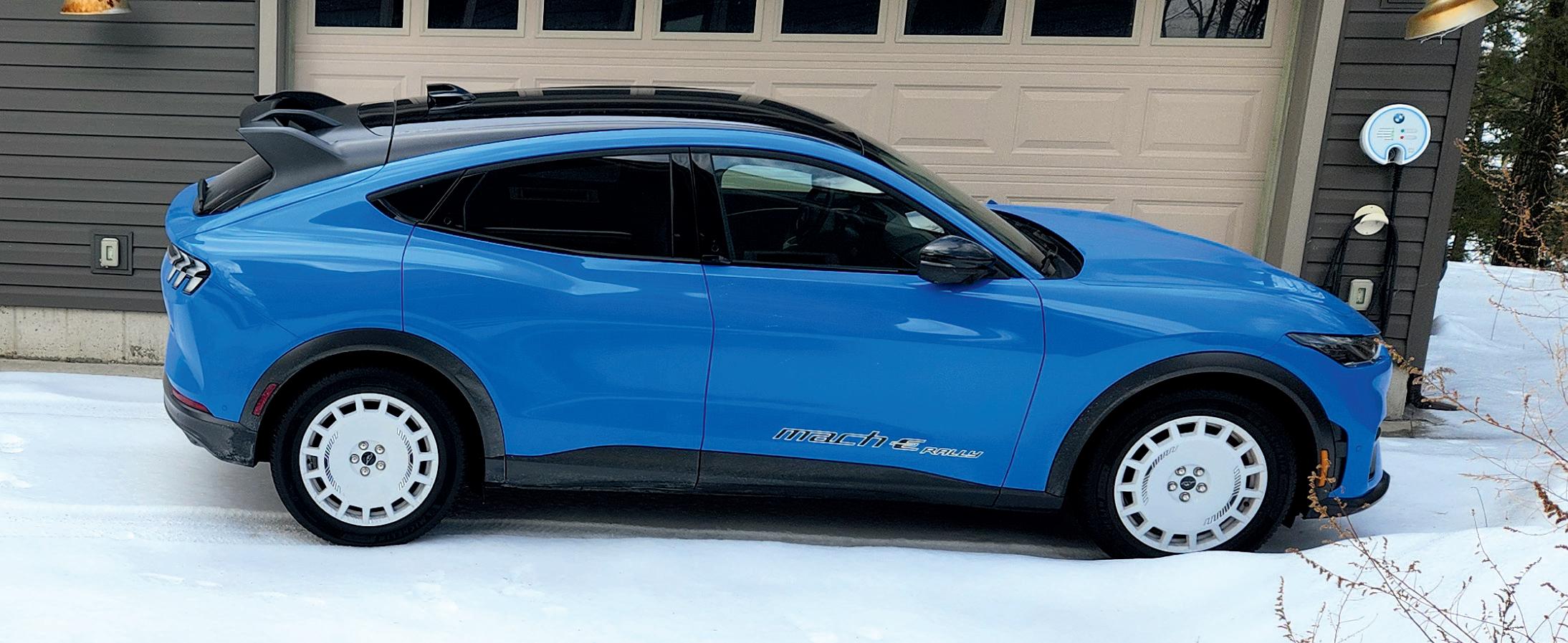

Have you noticed that every family crossover utility vehicle now seems to have one or more tough, o -road focused models shown in ads climbing rutted mountain trails, splashing through water, and otherwise pretending to be Jeeps? It’s unclear whether this sells more crossover utilities to families who use them for school runs, mall visits and general suburban family duties—but automakers clearly think it must.
Now it’s happening to electric vehicles too. We recently drove two models of this new, o -roadin ected variety of EVs: the 2025 Hyundai Ioniq 5 XRT (the name stands for ‘Extreme Rugged Terrain’) and the 2024 Ford Mustang Mach-E Rally introduced last year. We couldn’t do a back-to-back comparison, but we drove both within a 10-day period—albeit in very di erent conditions.
We took the Ioniq 5 XRT through rutted, ridged, bumpy trails in so sand, along with some rocky paths, during a media drive for the updated lineup of Ioniq 5 models for 2025. Daytime weather in Palm Springs was largely sunny, in the 60s, perfect for an EV. Our Mach-E Rally, on the other hand, spent a week doing local jaunts and longer highway journeys in the Northeast during an exceptionally frigid period. Temperatures ran from 5 to 25 degrees F, with snow and slush on roads from New York’s Hudson Valley into the furthest northern reaches of Vermont. Note the accompanying Mach-E Rally images are not the prettiest shots of a new EV you’ll have seen.
Our main conclusion is that these trim packages each provide some added utility, at the cost of lower range, likely stemming from greater ground clearance and higher aerodynamic drag from that plus bigger tires. e Mach-E Rally is EPA-rated at 265 miles of combined range, compared to 280 miles for the all-wheeldrive Mach-E GT with the same 91-kilowatt-hour battery pack. Similarly, the Ioniq 5 XRT gets an EPA rating of 259 miles, versus 269 to 290 miles for various versions with the same (enlarged) 84-kilowatt-hour pack and AWD.
ese aren’t massively jacked up, either: the XRT rides at 7 inches, a gain of only an inch over a standard Ioniq 5. e ground clearance of the Mach-E Rally is
Our main conclusion is that each of these trim packages provides some added utility, at the cost of lower range, likely stemming from greater ground clearance and higher aerodynamic drag.
6.7 inches against 5.7 inches for the standard Mach-E. Compare those increases to the 8.7 to 9.3 inches of the Subaru Crosstrek, the highly popular compact crossover hatchback known as a little mountain goat. It’s an oroad optimized version of the Subaru Impreza hatchback model, which has just 5.1 inches of ground clearance—meaning the Crosstrek gains 3.6 to 4.2 inches, rather than the inch added to each of the EVs.
Responding to a question at the media preview, Hyundai speci cally said it hadn’t needed to add further protection to the XRT’s underside to armor the battery against rocks or other o -road hazards. at’s because it had already done that for the standard car to protect the pack against random metal debris in the road, of the sort that punctured the battery pack and caused two res in early Tesla Model S EVs a decade ago. ose incidents led Tesla to retro t a titanium underbody shield and two aluminum de ector plates.
Ford, on the other hand, speci cally developed a Performance Battery Shield to protect the Rally’s battery—and o ers it as a $2,995 option for other Mach-E versions with the Extended Range battery pack. e company notes it is not intended to defend against rock crawling or even deeply rutted trails.
What owners may gain from these tougher-looking, more butch models is increased con dence in their EV’s ability to handle rougher roads, driveways and trails. In our case, that extra inch gave us the ability to launch the Mach-E Rally at a steep, curving, uphill gravel driveway half-covered in sheet ice. e li ed Mach-E with its Michelin CrossClimate 2 all-season performance tires clawed its way up with con dence.




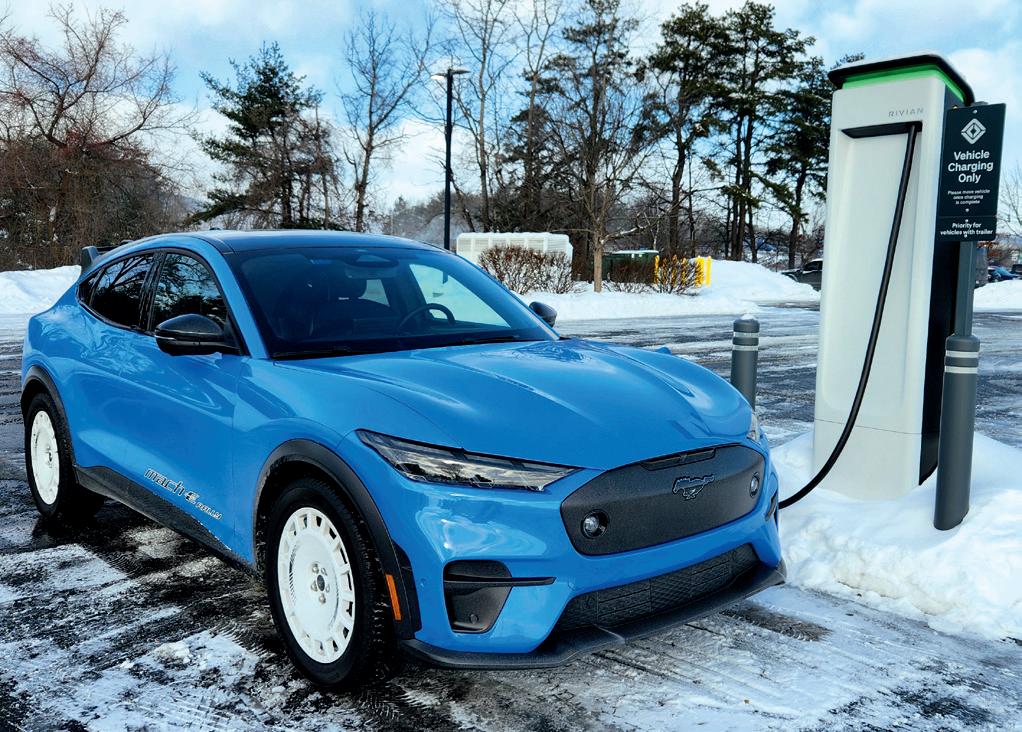
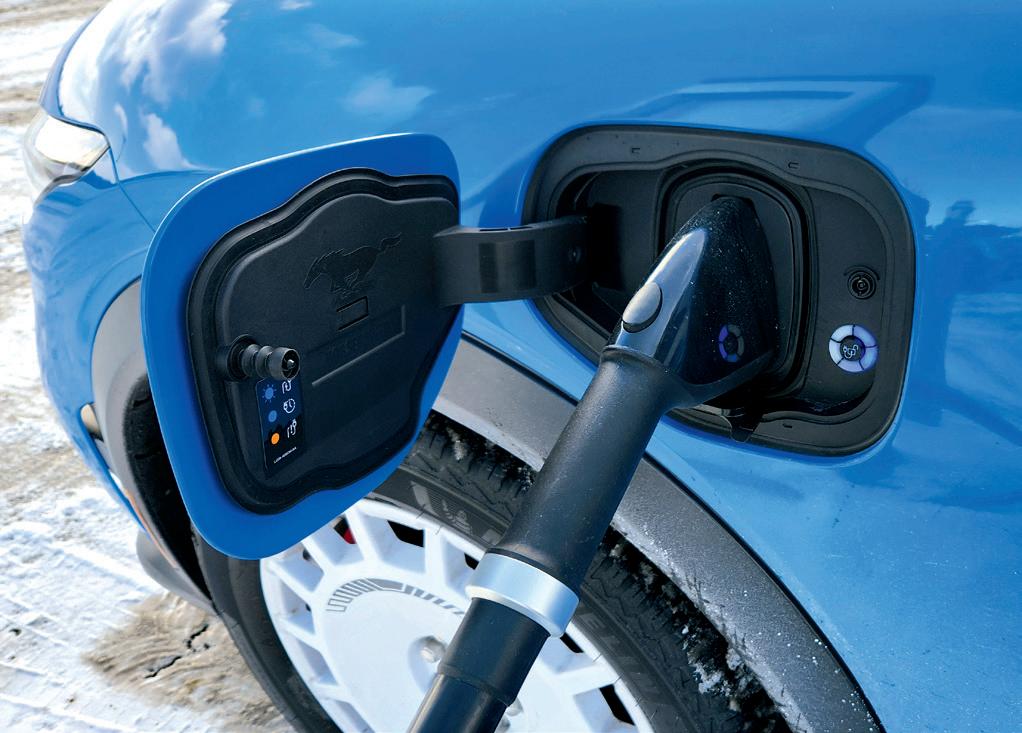
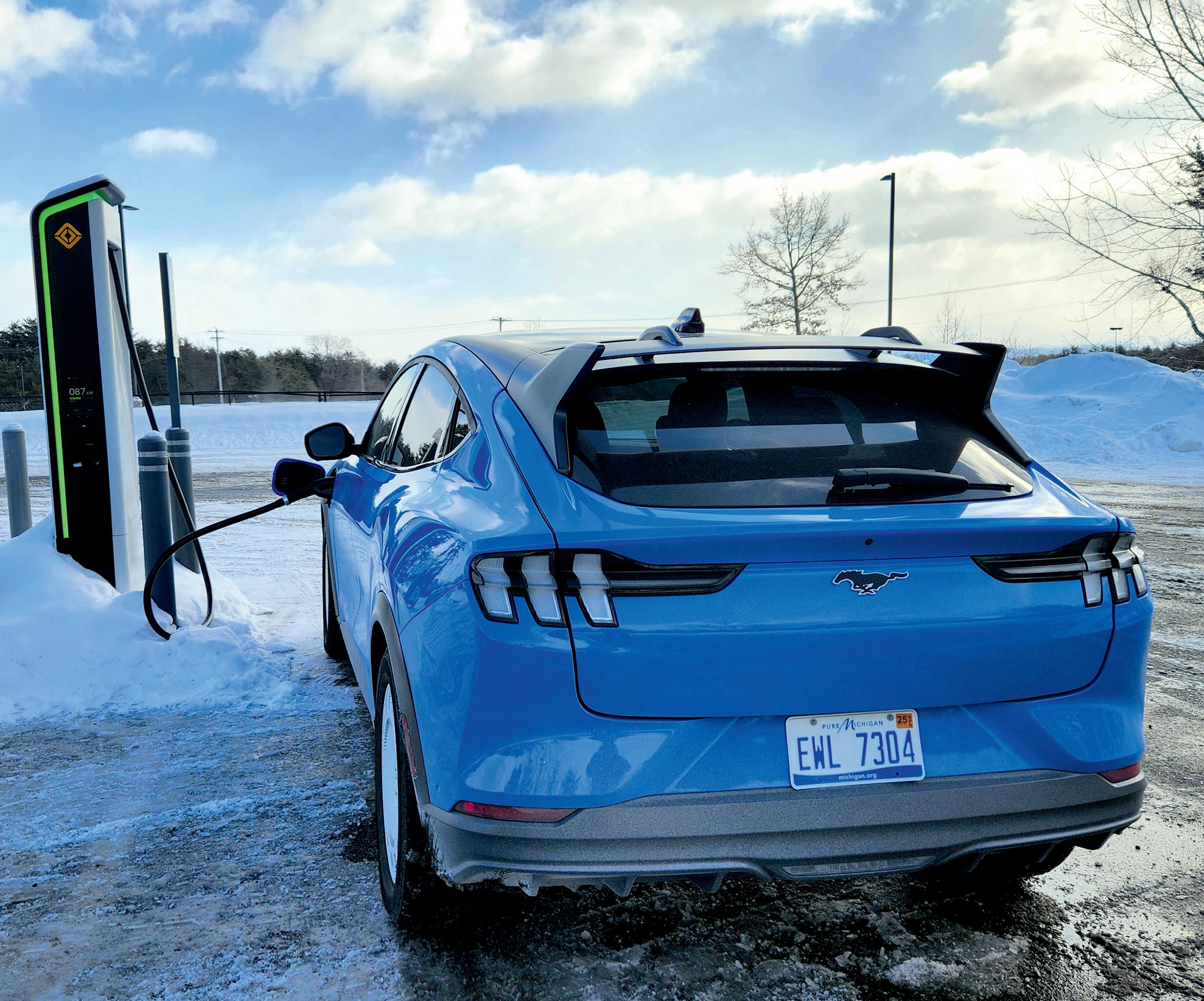

Could we have done that in the standard car? Perhaps…but we would likely have done it more slowly, which may or may not have worked.
For the XRT, its Continental CrossContact all-terrain tires never placed a foot wrong through more than an hour that encompassed several laps around an o -road course made of sand, rocky trails and a lot of ruts. Very di erent uses, of course—and not directly comparable— but each gave us a feel for the di erences between the tougher version and the standard model.
For real EV o -roading, look to the Rivian R1T pickup truck and R1S SUV, or the massive GMC Hummer EV—which o ers up to 15.9 inches of ground clearance in Extract mode, a staggering amount that somehow suits the almost-5-ton behemoth. ere’s also the upcoming Jeep Recon, an o -road-focused battery-electric model from the brand best known for o -roading—and a striking contrast to the suburban luxury of the Jeep Wagoneer S now arriving at Jeep dealerships.
Hyundai provided airfare, lodging, and meals to enable Charged to bring you this rst-person drive report of the Ioniq 5 XRT. Ford provided a Mustang Mach-E Rally press loaner for a week, along with a FordPass account that covered usage costs at certain DC fastcharging sites.

Very different uses, of course—and not directly comparable—but each gave us a feel for the differences between the tougher version and the standard model.



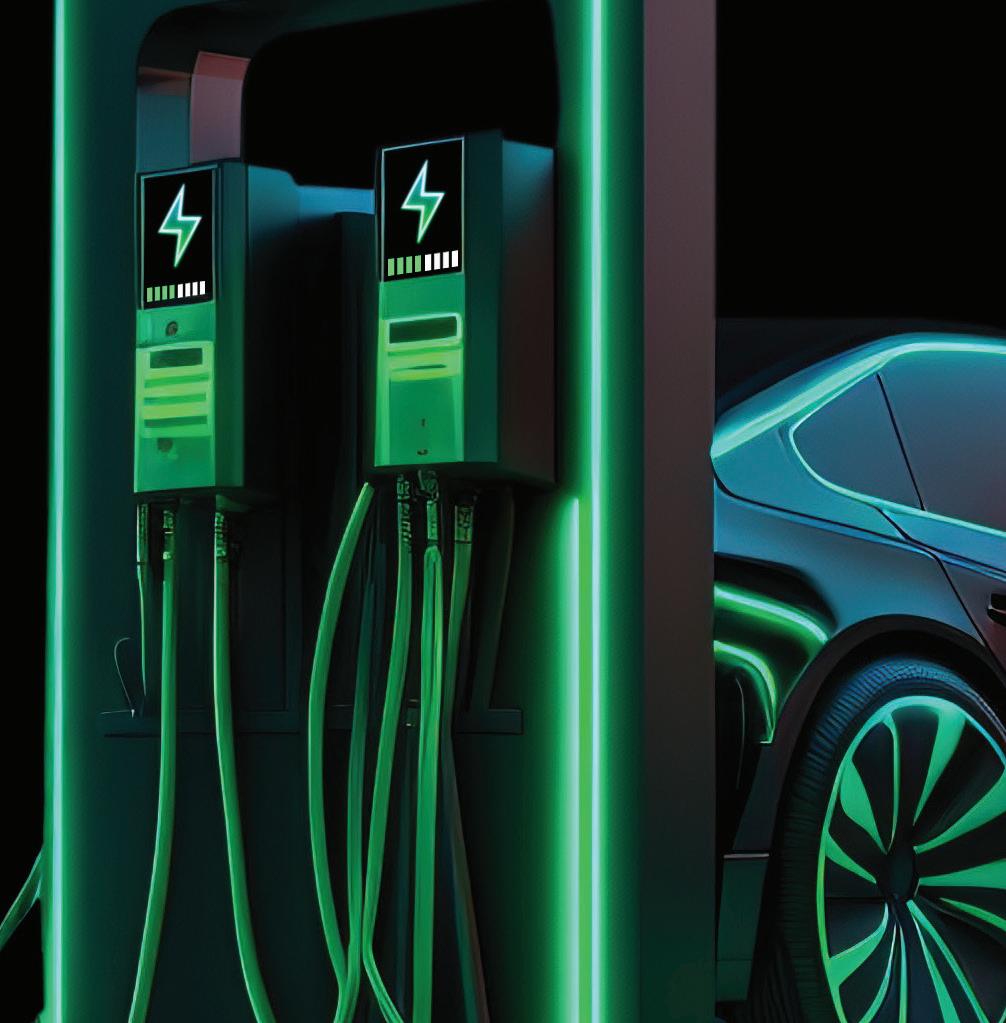












Revel operates an EV taxi service and a network of highspeed charging stations in New York. Now the company has begun the rst phase of its long-planned West Coast expansion, opening its rst EV fast charging station in the Bay Area.
Located in San Francisco’s Mission District at 199 Erie Street, Revel’s new charging station features twelve 320 kW chargers, designed and manufactured by Kempower. e station is publicly accessible 24/7, and all makes and models of EVs are welcome.
Revel also recently installed 24 new Kempower fast chargers at New York’s JFK Airport, within the airport’s for-hire vehicle (FHV) hold lot. Revel’s latest deployments bring the company’s total charging station count to 100, including its network in New York. Revel plans to deploy over 125 chargers to the urban cores of San Francisco, Oakland, San Jose and South San Francisco over the next year.
“For years, Revel has operated the largest, fastest, and most reliable fast charging network in New York City. Now we’re bringing our model to the number-one EV market in North America,” said Frank Reig, co-founder and CEO of Revel. “Today’s Mission District opening is an important milestone moment for Revel as we replant our bicoastal roots.”

School bus operator First Student has selected Ampcontrol’s EV charging platform to monitor and optimize all of its electric school bus operations. e partnership includes Ampcontrol’s cloud so ware, AmpEdge onsite controller solution, and professional services to optimize the energy usage and operation of the electric eet. First Student expects to realize a substantial reduction in monthly energy costs and improved charger uptime, as well as the ability to participate in vehicle-to-grid (V2G) programs (for which electric school buses represent an ideal use case).
“Today, First Student has one of North America’s largest electric bus eets, and our smart charging technology provides substantial cost savings and a reliable electric eet,” said Joachim Lohse, CEO at Ampcontrol. “Together, we’re not just electrifying school buses—we’re redening how we think about energy, mobility and environmental responsibility…while upholding First Student’s commitment to the highest standards of reliability and e ciency.”
“As we scale our electric eet to 30,000 buses by 2035, partnering with Ampcontrol allows us to harness smart, real-time energy management technology to improve e ciency, reduce costs, and ensure our buses are ready when and where students need them,” said Jen Harp, Vice President, EV Programs at First Student.




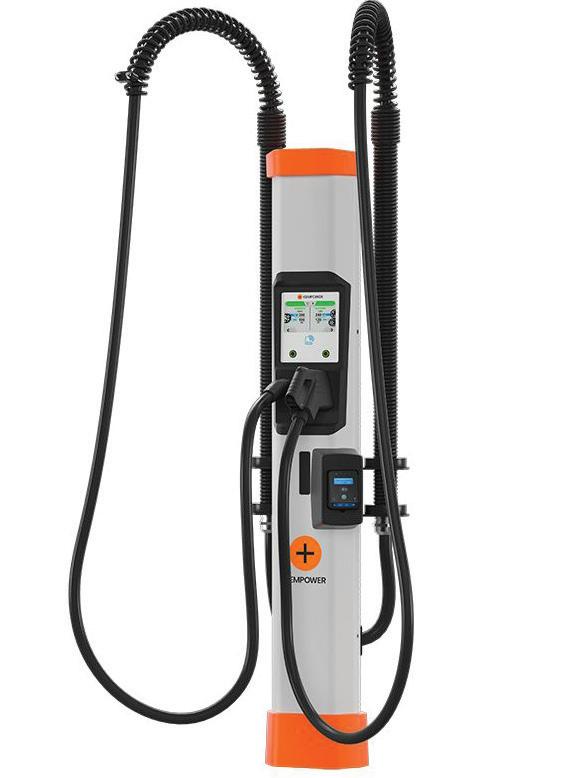
EV charging solution provider Kempower has launched a new EVSE product that it calls a “cutting-edge fastcharging experience.”
e Kempower Flex Satellite is designed for public charging applications, and o ers both CCS and NACS connectors. It works in conjunction with the Kempower Power Unit, which provides DC power to a number of satellite units. e Flex Satellite can supply up to 400 A to a CCS1 connector, or 380 A to an NACS connector.
e Flex Satellite meets all funding requirements for the National Electric Vehicle Infrastructure Formula Program, as well as the appropriate state regulations.
“With the launch of the new Flex Satellite, Kempower is raising the standard of EV charging solutions for drivers everywhere,” says Monil Malhotra, President of Kempower North America. “ e Flex Satellite will enhance public charging infrastructure, allowing us to continue serving ever-changing customer needs and enabling the most e cient user experience for EV drivers across North America.”
DG Matrix raises $20 million to commercialize its multiport solid-state transformer solutions

DG Matrix provides solid-state transformer solutions for data centers and electri cation projects such as microgrids and EV eets. Now the company has secured $20 million in an oversubscribed seed funding round. Clean Energy Ventures led the round, and industry stalwarts including ABB, Cerberus Ventures, Chevron Technology Ventures and Piedmont Capital participated. e new funding brings DG Matrix’s total funding to nearly $30 million.
DG Matrix will use the funds to accelerate the commercialization of its Power Router platform, which “delivers exible, reliable solutions to enhance energy performance while alleviating grid constraints and reducing energy costs.”
“Integrating multiple AC and DC energy sources and loads simultaneously enables the DG Matrix solution to replace 10-20 electrical systems with a more versatile, e cient, cost-e ective and reliable system,” says the company.
DG Matrix says it has tens of millions in purchase orders in the pipeline for 2025 and 2026. e company will begin paid pilot deployments in Q1 2025, and anticipates a full commercial launch in late Q2 2025.
“ e unprecedented amount of electricity demand by broader electri cation is expected to further strain the grid and jeopardize grid reliability. Commercial markets are requiring a standardized, e cient solution to manage their complex electricity con gurations in a cost-e ective manner,” said Daniel Goldman, Managing Partner at Clean Energy Ventures. “We believe DG Matrix’s industry-agnostic solid-state transformer solutions will be paramount in alleviating grid pressure.”
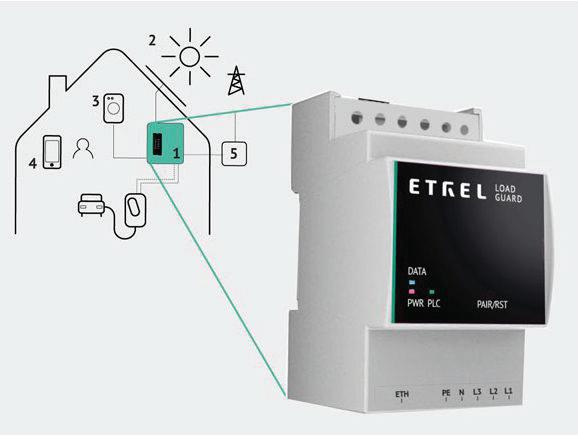
Slovenia-headquartered Etrel, a provider of EV charging stations and charging management so ware, has announced its acquisition by KD Group, a Slovenia-based nancial and investment management company.
e transaction marks the end of the liquidation process initiated for Landis+Gyr EV Solutions. According to Etrel, its service operations will remain unchanged during the transition.
Etrel has a presence in more than 40 countries worldwide and is known for its INCH interactive EV charging and its OCEAN so ware platform for EV charging network management.
Commenting on the acquisition was KD Group CEO Gregor Sluga: “ is investment re ects our con dence in the company’s role in shaping a smarter, more sustainable future. is is also an important opportunity for further support of the development of Slovenia’s entrepreneurial and innovation landscape, fostering local expertise and reinforcing the country’s position as a hub for advanced technology in the global e-mobility market.”
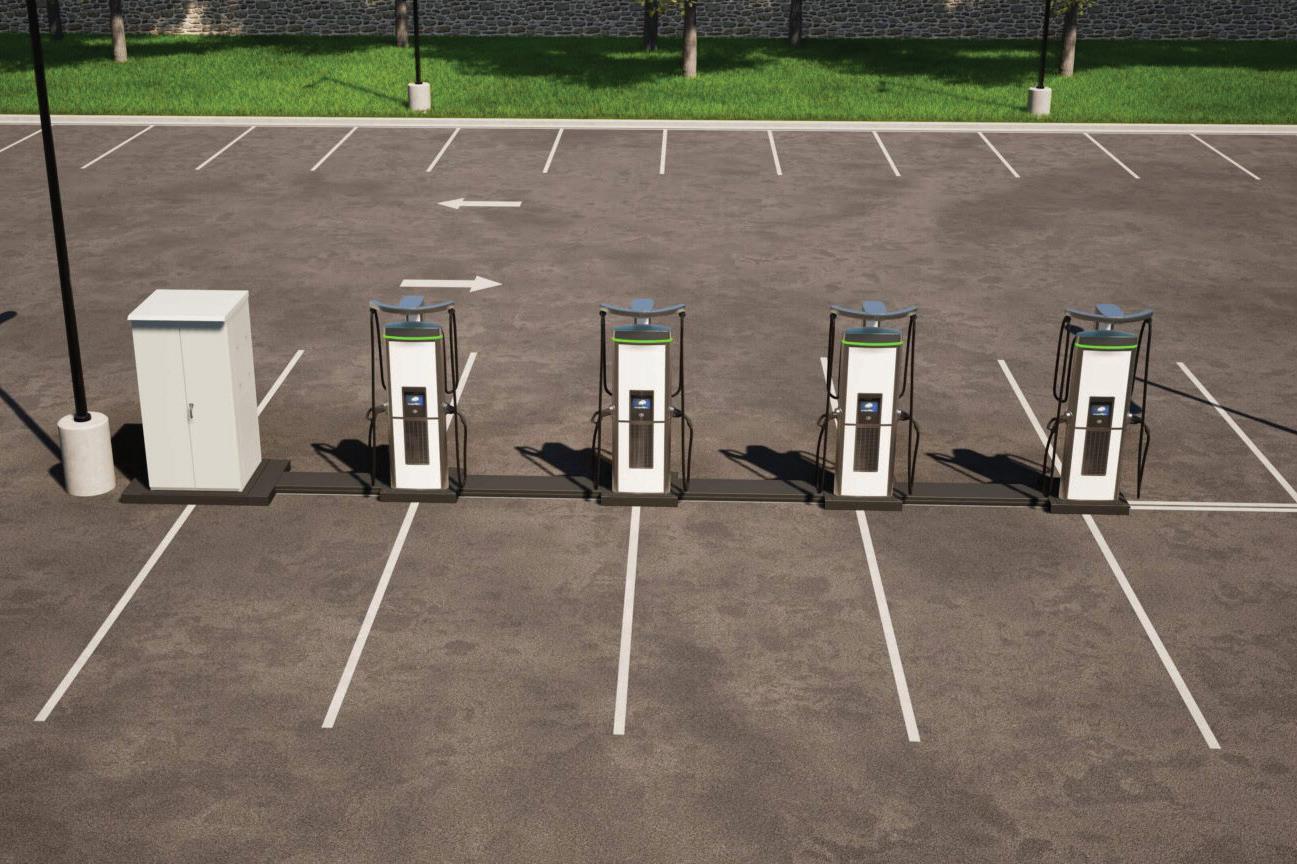
Engineering, construction, manufacturing and clean energy company Faith Technologies Incorporated (FTI), headquartered in Wisconsin, has launched its Excellerate eSkid EV charging product for above-ground cable routing.
It is designed to reduce site disruption and enable easy relocation in commercial and eet applications.
Each Excellerate eSkid unit can support up to 1 MW of EV charging and can power up to eight DC fast chargers in various orientations. Plans call for expanding the product’s capacity to 2.5 MW.
“We’ve designed the Excellerate eSkid to streamline deployment of EV charging infrastructure,” said Jon Branson, VP and General Manager of Products at FTI. “ e above-ground installation reduces trenching challenges and provides customers the exibility to choose from several product con gurations to meet their EV charging needs.”




Jolt, an Australian EV charger manufacturer that o ers drivers free, advertiser-supported charging, and the Canada Infrastructure Bank, a federal Crown Corporation of Canada that is charged with nancially supporting revenue-generating infrastructure projects, have announced a C$194-million loan agreement that will support the expansion of Jolt’s charging network.
e loan will pay for the installation of up to 1,500 new curbside EV chargers in urban areas.
e CIB said that it is providing the funding “to alleviate consumer range anxiety, accelerate EV adoption and signi cantly reduce transportation sector emissions.” It added that this project is its fourth investment under the government’s Charging and Hydrogen Refueling Infrastructure Initiative and its third in EV charging infrastructure.
Drivers can receive 7 kWh of free fast charging per day through the program, the cost of which is o set through Jolt’s integrated digital out-of-home (DOOH) advertising at each charging location. A driver can then opt to continue charging at what Jolt says will be an a ordable rate. e company has already signed multiple advertisers including Volkswagen, Audi and the Government of Ontario. Jolt has begun to roll out its DOOH network and EV chargers across the Greater Toronto Area.
“By investing in expanding EV charging infrastructure, we are supporting Canadians’ need for accessible and convenient charging points in urban centers,” said Ehren Cory, CEO of Canada Infrastructure Bank. “Our strategic partnership with Jolt highlights a commitment to supporting the deployment of innovative technology which will create jobs and remove a potential barrier to EV adoption.”
Digital out-of-home advertising uses digital displays to deliver ads to consumers in high-tra c public spaces such as shopping malls, bus stops, airports and parking lots.
Microgrids are the coming thing in EV charging—incorporating battery storage can mitigate the need for high-power grid connections, making installations quicker and cheaper.
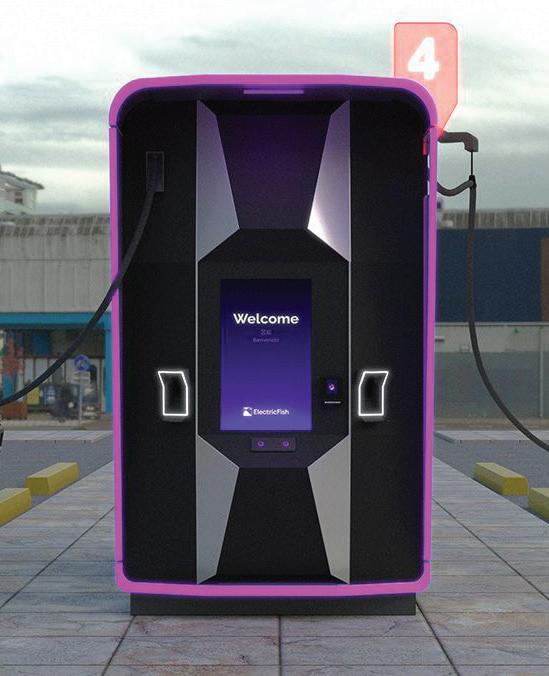
ElectricFish has launched a new, fully redesigned version of its microgrid-based EV charger. Called the 350Squared, the system features battery integration and a proprietary power electronics design that the company says delivers faster EV charging and reduces the need for costly grid upgrades. Its container form factor, designed for semi-permanence and easy moveability, accelerates permitting and eliminates the need for trenching.
e 350Squared includes 400 kWh of integrated energy storage, a bidirectional electricity meter and two DC fast charging ports.
e system’s so ware features a combination of demand response and predictive analytics designed to optimize energy use, ensure grid stability and lower operational costs. e integration of real-time energy market APIs enables site hosts to generate revenue through dynamic energy management.
“With our approach, the power bank serves as an energy reservoir, drawing power from existing infrastructure without needing costly upgrades—similar to how gas station pumps pull from fuel stored in tanks onsite, except that the 350Squared can pull from both its battery and the grid,” said Nelio Batista, Chief Technology O cer of ElectricFish. “ is drastically reduces deployment time and upfront investment, all while making it easier for vehicle eet operators to scale their electri cation e orts without constraints.”

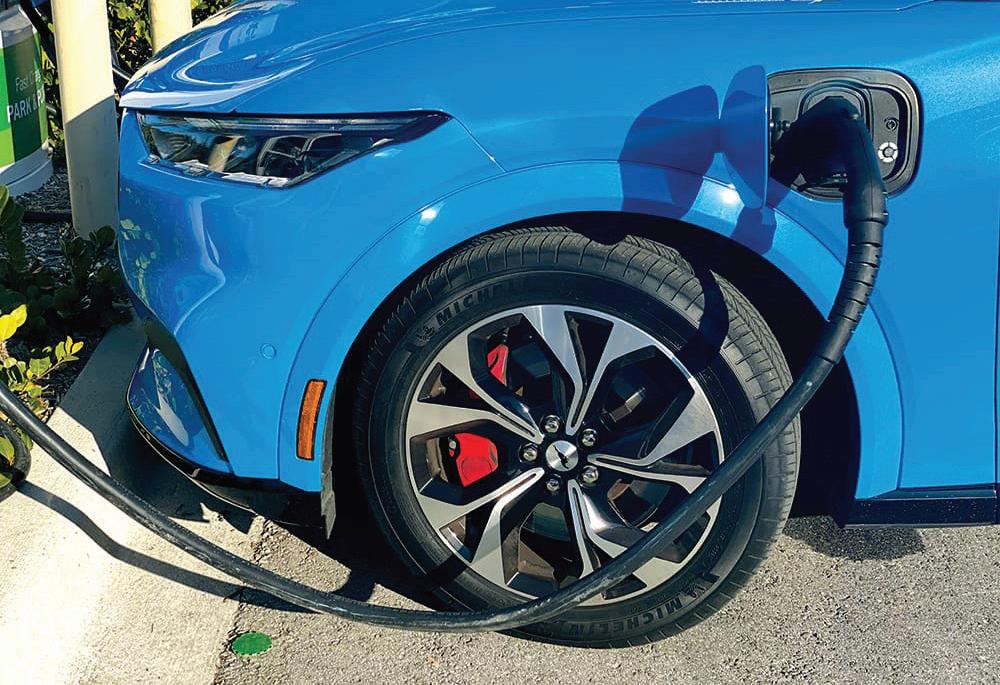
e Fast Charge California Project, part of the California Electric Vehicle Infrastructure Project (CALeVIP), will open a new $55-million funding window in July 2025 to support the installation of DC fast charging stations at businesses and publicly accessible locations across the state.
e new funds will cover up to 100% of the costs to deploy ready-to-build EV fast chargers, up to $55,000 or $100,000 per charging port, depending on the power level.
Applications for the Fast Charge California Project will be open to EV charging service providers and others representing locations such as convenience stores, gas stations, retail centers, parking lots and hotels. Priority will be given to chargers in tribal, disadvantaged and low-income communities.
Charging projects must be ready to build and have the utility design and required permits before applying for funds.
“We’re excited that the Fast Charge California Project will prioritize not only fast chargers but ready-to-build projects in communities that need them the most,” said Hannon Rasool, Director of the CEC Fuels and Transportation Division.
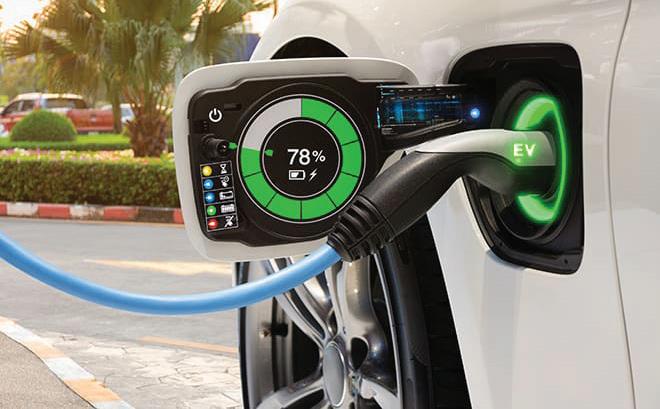
ENAPI, a connectivity platform for the EV charging industry, has closed a 7.5-million-euro ($8.1-million) seed funding round led by Voyager Ventures. e new nancing round, combined with a $2.7-million pre-seed round completed 10 months ago, brings the company’s total funding to $10.8 million. ENAPI will use the new funding to fast-track its plans to become “the clearing house for the EV charging industry.”
As any user of public EV charging knows, the user experience is generally poor, partly because the charging ecosystem is fragmented. ENAPI cites a McKinsey study that found that 70% of EV drivers are dissatis ed with the existing public charging infrastructure.
ENAPI’s so ware platform is designed to seamlessly integrate nancial, technical and operational data ows among market participants in the EV charging ecosystem. e company provides the data infrastructure to instantly settle transactions between Charge Point Operators (CPOs) and e-Mobility Service Providers (eMSPs).
ENAPI is growing at a rapid rate—the company says it has onboarded over 350,000 charge points and 8 of Europe’s 10 largest eMobility Service Providers in less than six months.
“Our mission is to make EV charging transactions seamless, e cient and accessible,” said Jakob Kleihues, CEO and co-founder of ENAPI. “With free connectivity as a foundational layer, we help our partners achieve market-wide e ciencies and unlock lasting value.”

























Conference: 8th - 10th July 2025
Exhibition: 9th - 10th July 2025
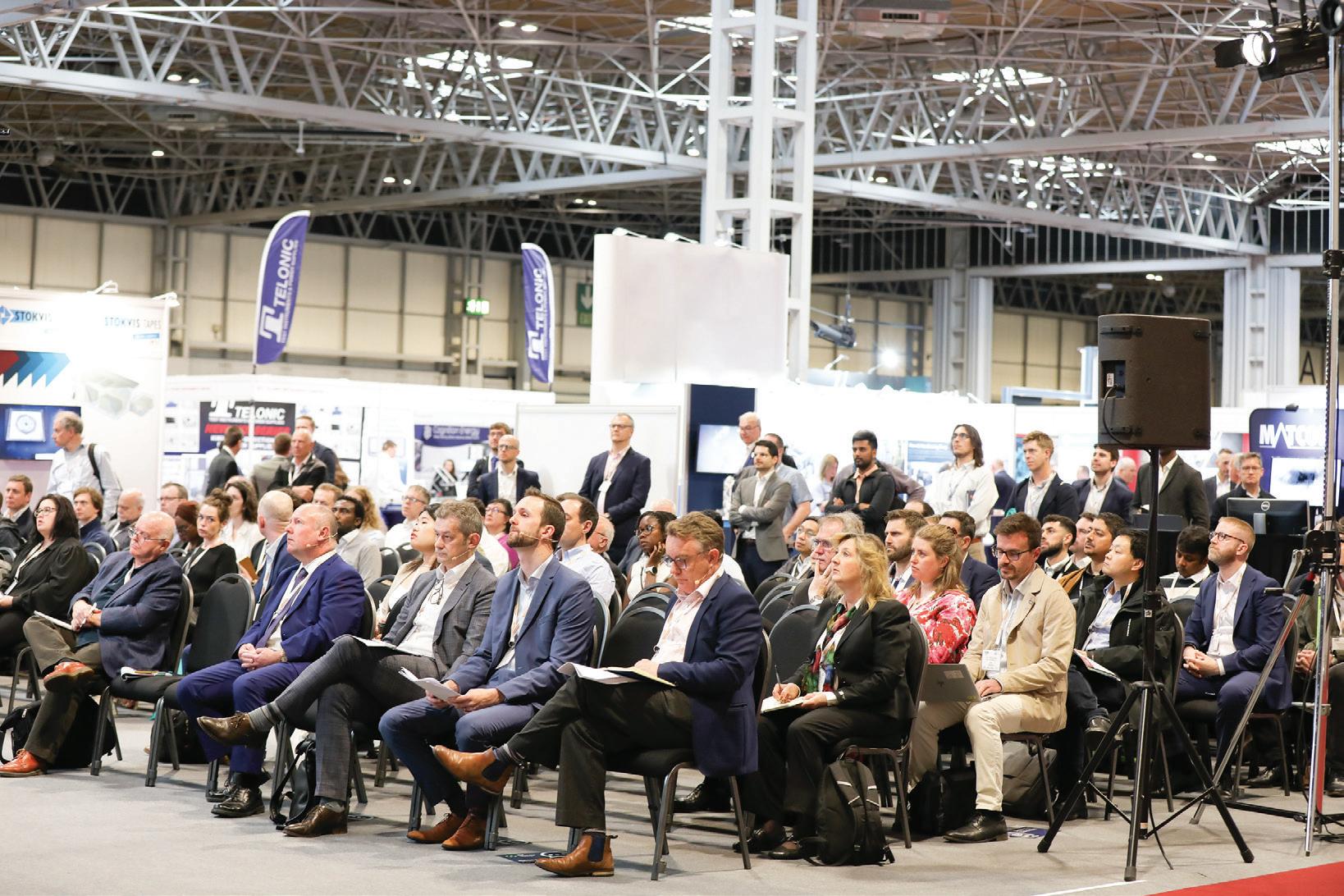






































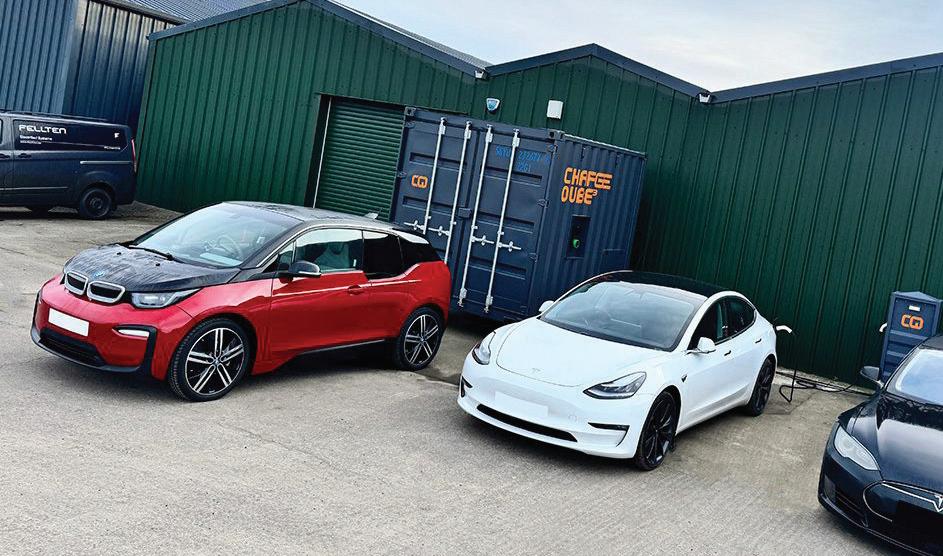
Battery pack maker Felten has announced the debut of its new mobile energy storage product, the Charge Qube.
e Charge Qube is a rapidly-deployable, modular mobile battery energy storage system (BESS) that repurposes second-life batteries and ISO containers.
“ e Charge Qube delivers immediate energy solutions for eet operators, public charging stations, construction sites and remote or temporary or semi-permanent power needs,” the company said.
e new Charge Qube provides sustainable energy thanks to its integrated solar and wind energy capabilities. e Charge Qube, which is made in the UK, is delivered in a 10-foot ISO container, and can act as a standalone power source or be integrated with other energy networks. It supports up to ve satellite stalls with twin chargers and o ers scalable energy storage varying from 150 kWh to 450 kWh per unit. An optional 20-foot container variant with a capacity of 900 kWh is expected to be available in Q2 2025.
e Charge Qube has AC and DC charging capabilities, and is available in three variants. An energy storage-only option provides exible, o -grid power. A second version o ers Type 2 AC charging—two chargers on the Qube along with pairs of 7 kW chargers on up to ve satellite stalls. It supports up to 12 EVs simultaneously at 7 kW per port. e CCS DC fast charging version features dual 240 kW chargers, and is suitable for high-speed public and commercial EV charging.
XCharge North America, a provider of DC fast charging and battery-integrated EV solutions, is partnering with the Orlando Utilities Commission to install XCharge NA’s Net Zero Series (NZS) charger at OUC’s Grid Integration Laboratory (GIL). e companies aim to explore how resilient charging solutions can enhance the electrical grid’s stability while reducing costs.
Under a one-year research agreement, OUC will use the NZS unit to assess its battery-integrated system and charging capabilities in a demanding operational environment.
Traditional behind-the-meter DC fast charging deployments frequently require infrastructure upgrades, such as new utility hookups and/or transformers. e NZS incorporates a 233 kWh battery pack, and is engineered to limit the amount of power drawn from the grid to a maximum of 194 kW. e NZS installed at GIL operates on an existing 60-amp breaker, and allows OUC to reduce demand impact on the grid to a quarter of what it would have been without the battery bu ering.
“As we build out OUC’s network of EV charging stations, we’re always looking for solutions that can be strategically installed on existing infrastructure, maximizing e ciency and minimizing costs,” said Paul Brooker, OUC Manager of Emerging Technologies.
“We’re encouraged by XCharge North America’s innovative demand response features, which could better enable us to e ciently manage electricity during peak periods to alleviate stress on the grid. NZS also opens doors for applications like microgrids, which can provide critical backup power to essential services such as hospitals or college campuses during emergencies like hurricanes.”
“Our partnership with OUC is a signi cant step in our mission to build EV solutions that not only bene t EV drivers but also strengthen grid reliability through battery-integrated technology,” said Alex Urist, XCharge NA’s VP. “We are excited to see how OUC uses the NZS’s bidirectional functionality to enhance the grid’s performance, particularly in addressing mobility demand and extreme weather conditions.”




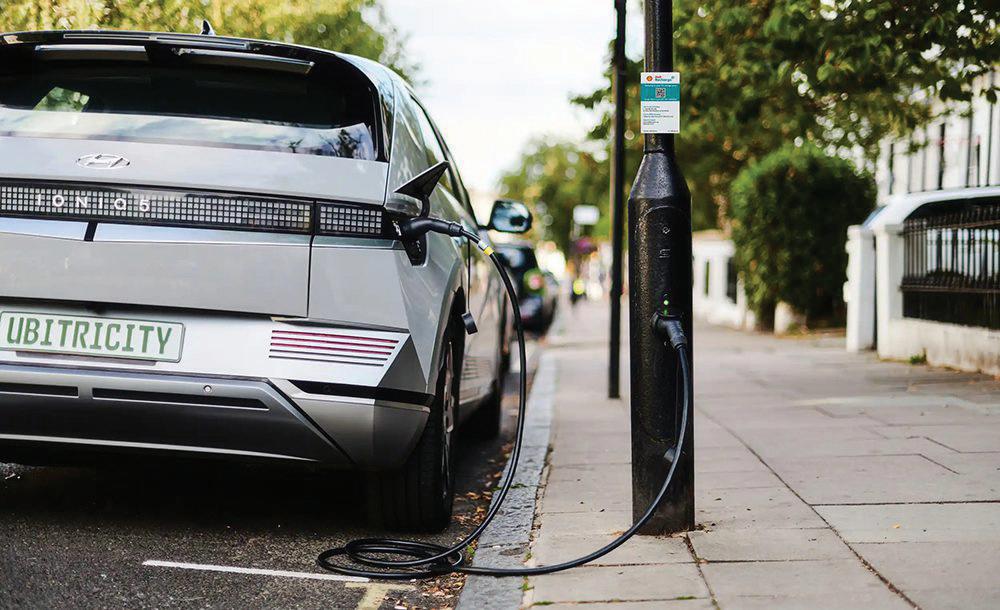
Birmingham City Council in the UK has partnered with charging point operator ubitricity to carry out a pilot deployment of 560 lamppost charge points in residential areas of the city where access to private o -street parking is limited or unavailable.
e charging points will be installed in lampposts on 82 streets around the city. Each charger takes less than an hour to install, according to the company. e rst 300 were installed between October and December 2024, one of ubitricity’s fastest mass rollouts. e remaining 260 are to be installed before the end of spring 2025.
A lack of access to overnight charging at home can act as a deterrent to EV ownership, the council stated. e initiative is part of the city’s wider EV charging strategy to improve access to charging infrastructure. e lampposts avoid street clutter while placing charging points based on resident demand and grid connection availability.
Ubitricity, which is a wholly-owned subsidiary of Shell, will supply, install, own, operate and maintain the charging points on behalf of the council.
“Ubitricity is delighted to be supporting Birmingham City Council as they begin this journey to create one of the largest public EV charging networks outside London, encouraging the transition to electric vehicles,” said Stuart Wilson, UK Managing Director of ubitricity.
Electrifying vehicles used by rideshare drivers delivers a lot of emissions-reduction bang for the buck, because drivers for services such as Uber and Ly travel many more miles than average drivers. Electri cation can also save money for the drivers, who are usually responsible for their own vehicles’ fuel and maintenance costs.
Obviously, drivers are only going to go electric if they know they’ll be able to reliably and conveniently charge their EVs. As cities, eet owners and EV service providers develop charging infrastructure strategies, they need to know when and how rideshare drivers charge in the real world. e Rocky Mountain Institute (RMI), in collaboration with partners on the WestSmartEV@Scale project, collected driving data from a sample of electric rideshare drivers in Salt Lake City, Las Vegas, Phoenix and Portland, Oregon.
RMI’s report identi es the challenges involved in building out charging infrastructure, and identi es best practices for addressing them.
RMI found that over 90 percent of rideshare drivers using EVs charged them at home. Furthermore, when drivers did use public chargers, they tended to use them for short periods of time, rarely charged their EVs to 100%, and o en made long stops without availing themselves of nearby public chargers.
e drivers spent lengthy periods of time at locations such as shopping centers and libraries, but they showed a preference for waiting to charge at home. e logical inference is that this is because it’s cheaper to charge at home. is jibes with what an Uber driver told me in London in 2023. His Hyundai Ioniq’s range of 200 miles was plenty for a day of stop-and-go city driving. When he got home at night, he plugged into a lamppost charger for a slow charge (he had no driveway). A nightly charge cost him about a third what driving on petrol would cost, and also less than what he’d pay at a DC fast charger. is is just one of the insights found in RMI’s report. Anyone involved in the rideshare industry, or in urban charging infrastructure planning, should read it in its entirety.

Commercial EV charging network developer Greenlane Infrastructure (a joint venture whose owners include Daimler Truck North America) has partnered with Volvo Trucks North America to integrate Greenlane’s charging network into the Volvo Open Charge service.
Greenlane is Volvo’s rst Charge Point Operator (CPO) partner in the North American market. Greenlane will enable real-time access to Volvo’s Open Charge network, providing Volvo customers with access to public charging, centralized billing and exclusive bene ts.
Greenlane’s agship charging location in Colton, California, scheduled to open in April, will feature over 40 publicly accessible chargers for heavy-, medium- and light-duty EVs. By using public charging stations, eet operators can go electric without investing in building charging depots or navigating the complexities of infrastructure development.
“Our partnership with Volvo will deliver public charging solutions tailored to the needs of medium- and heavy-duty eets,” said Patrick Macdonald-King, CEO of Greenlane.
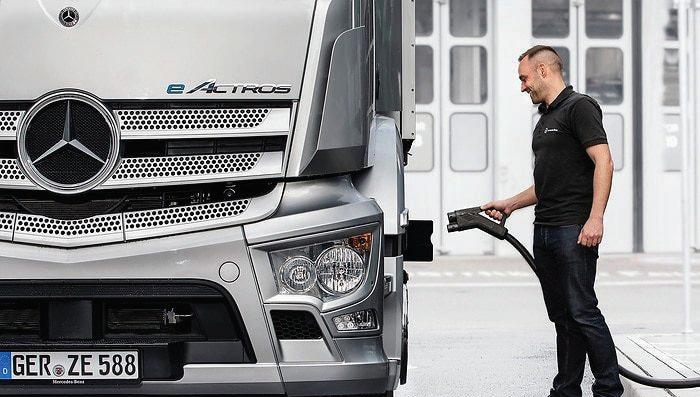
In an e ort to alleviate Europe’s current de cit in charging points and charging capacity for heavy commercial vehicles, Daimler Truck plans to enable its TruckCharge customers to open their charging infrastructure for external, paid use, starting in the third quarter of 2025.
Plans include o ering a system for planning, booking and reservation, along with additional cost bene ts and simpli ed payment.
Europe has fewer than 1,000 charging points for heavy commercial vehicles, but Daimler’s new network is projected to include more than 3,000 fast charging points by 2030, making it the continent’s largest. e semi-public network is designed to supplement existing European public charging networks such as Milence, a joint venture of Daimler Truck, TRATON and Volvo, which has the goal of establishing 1,700 high-capacity public charging points by 2027.
“With our TruckCharge concept, we are aiming to close a large gap in the charging infrastructure for trucks,” said Martin Hink, Head of eMobility Business Solutions at Mercedes-Benz Trucks. “On the one hand, the idea is to help our customers make their own charging infrastructure more pro table. On the other hand, we want to o er operators of electric trucks additional, attractive options for charging their vehicles.”





Delta Electronics, a provider of power management and Internet of ings (IoT) smart green products, has launched its next-generation DC Wallbox 50 kW EV charger.
e upgraded model for public and commercial charging applications is designed to deliver advanced functionality and an optimized user-centric experience, enabling seamless and e cient charging for operators and drivers.
e charger integrates a certi ed energy metering system and a credit card terminal for ad hoc payment, simplifying the payment process for EV drivers and ensuring accurate billing.
A new charging status light on the front panel provides clear, real-time visual indicators to help EV drivers easily identify available charging points. Delta’s cable management system minimizes clutter, protects cables from wear and tear and facilitates easy access.
e Wallbox supports simultaneous DC charging through two output guns to accommodate a wide range of EV models and optimize usage turnover. Its slim 25 cm pro le makes it suitable for space-constrained locations. Built-in Ethernet and wireless communication enable e cient remote management and maintenance.
“By integrating payment systems, enhancing usability, and prioritizing safety, we are delivering a new benchmark in quick and convenient public and commercial EV charging,” said Arto Suni, Senior Director Electric Vehicle Charging Solutions at Delta Electronics EMEA.
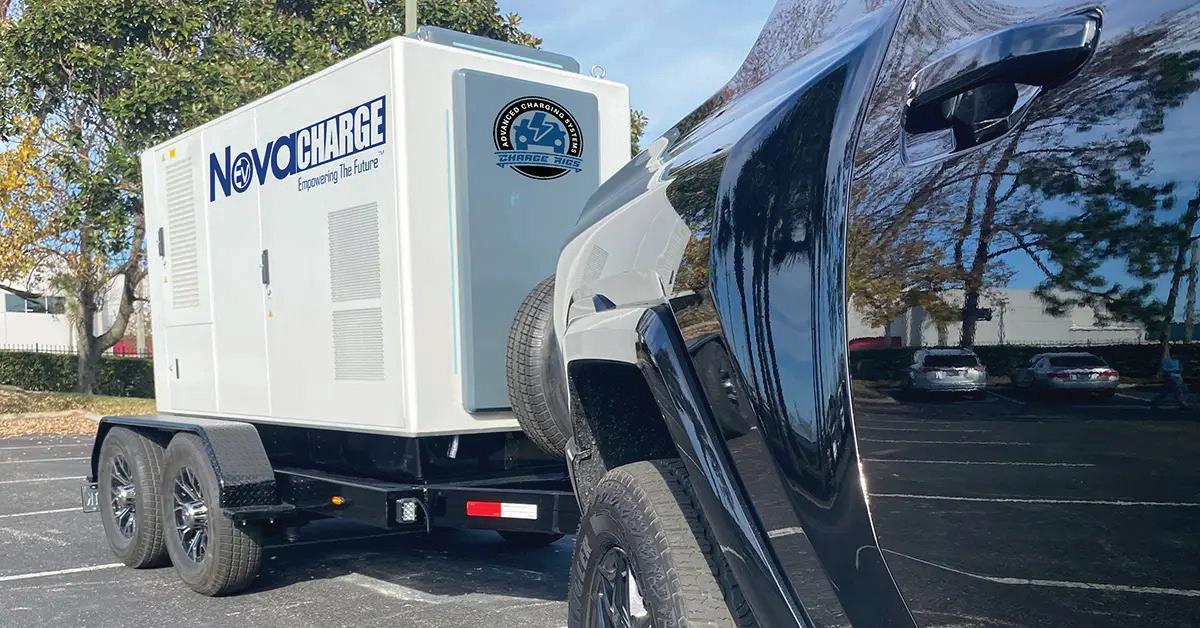
EV charging infrastructure provider NovaCHARGE debuted its new Flexx Mobile DC Fast Charger by Charge Rigs at the recent Electric Vehicle Charging Solutions (EVCS) conference in Las Vegas.
e Flexx Mobile DC Fast Charger is designed to deliver rapid, e cient charging that eet operators and emergency response teams can count on. In some cases, for example in emergency/disaster response applications, EV batteries run low and drivers are unable to get to EV chargers, so the charger must go to the driver. In times of natural disaster, Flexx mobile chargers can be deployed along evacuation routes ahead of storms, then redeployed close to locations where supplemental EV charging is needed a er the storm.
e Flexx Mobile DC Fast Charger features rugged engineering to ensure dependable performance in demanding environments. It’s designed to be easily transported while withstanding tough conditions, and it’s adaptable to a broad range of applications, from eet management and commercial installations to emergency rescue.
“At NovaCHARGE, reliability is at the core of everything we o er,” said CEO Oscar Rodriguez. “ e Flexx is an example of our commitment to providing robust, high-performance charging solutions that businesses can depend on. Whether it’s for a eet, a remote location, or an emergency response, the Flexx ensures that EVs are always ready to go—no matter the situation.”

By Charles Morris
here are three things everyone in the EV industry seems to agree on: (1) we need more charging infrastructure; (2) it needs to be more reliable; and (3) installation o en takes much too long. Project delays very o en have to do with getting a site connected to the grid, but it isn’t (always) the fault of local utilities— high demand for essential power equipment such as transformers and switchgear has created a shortage, and wait times can stretch into months or even years.
In addition to equipment shortages, many sites have problems obtaining the right kind of power. e majority of DC fast chargers on the market
today require 480-volt, 3-phase power, instead of the 208 V and 240 V supplies found at many commercial and residential properties. And there are some areas in the US where 480 V is simply not available.
Several EVSE industry pros have told us that this is a major bottleneck. CEO Alex Urist of XCharge, which makes battery-integrated chargers, raised the issue in an interview with Charged (see our Oct-Dec 2023 issue). If 480 V isn’t available at your site, you’ll need an extra piece of equipment called a buck-boost transformer to step the voltage up to what you need. Charging industry consultant Forest Williams told us that this item can cost thousands of dollars, and the lead time for obtaining the necessary switchgear can stretch to months.






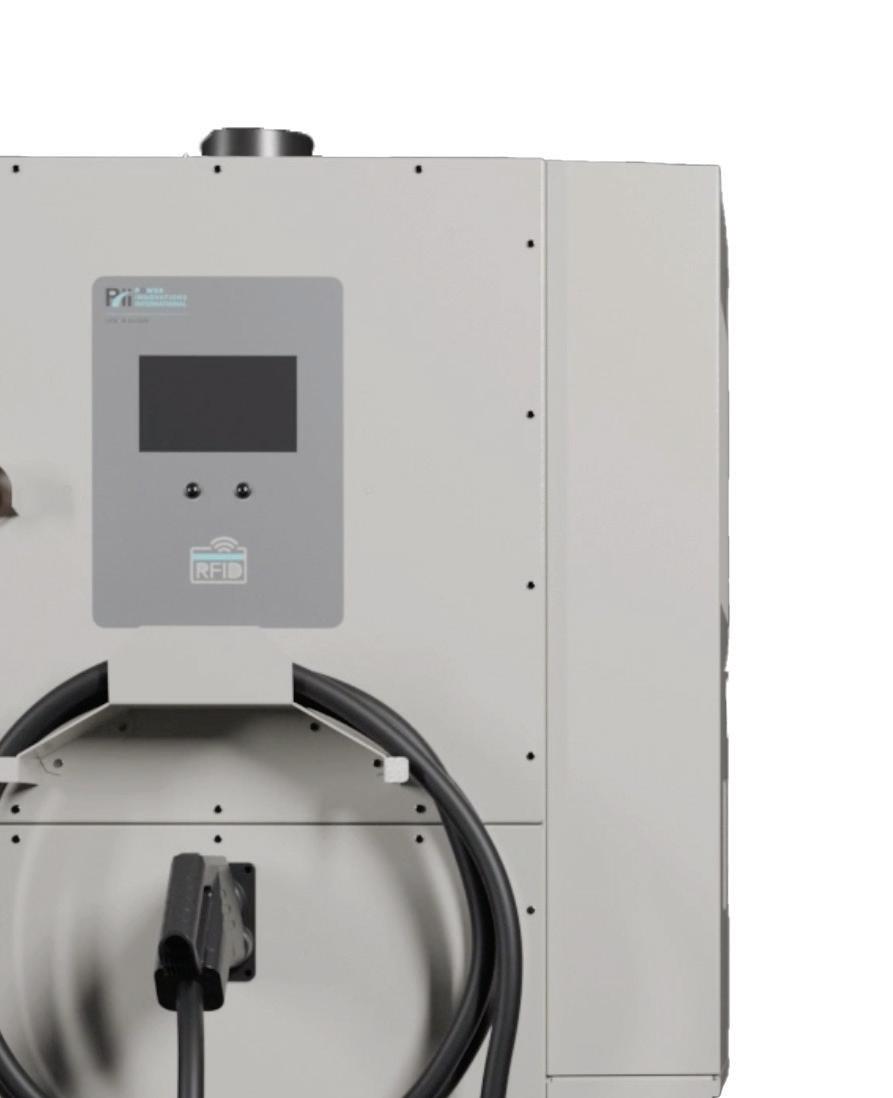
In addition to equipment shortages, many EV charging sites have problems obtaining the right kind of power.
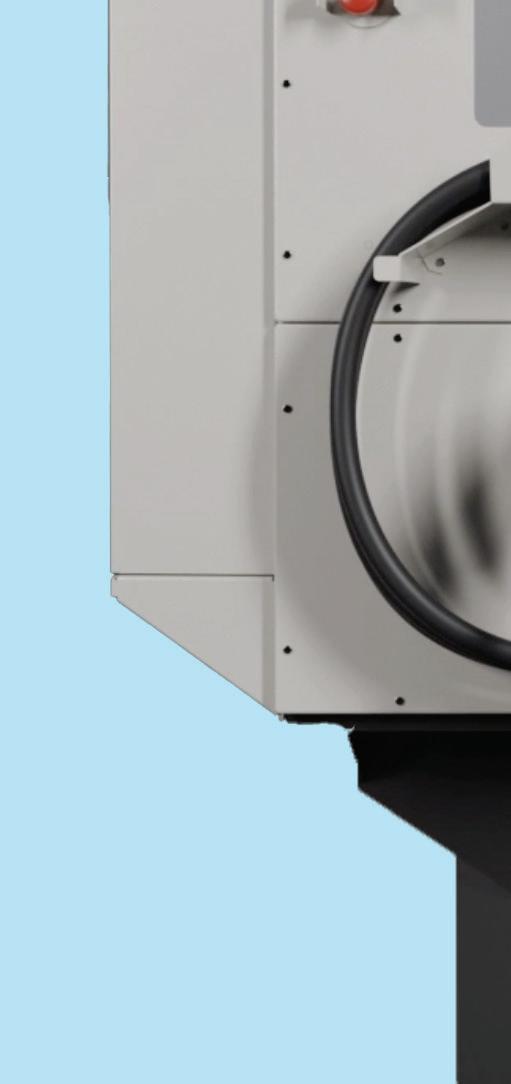
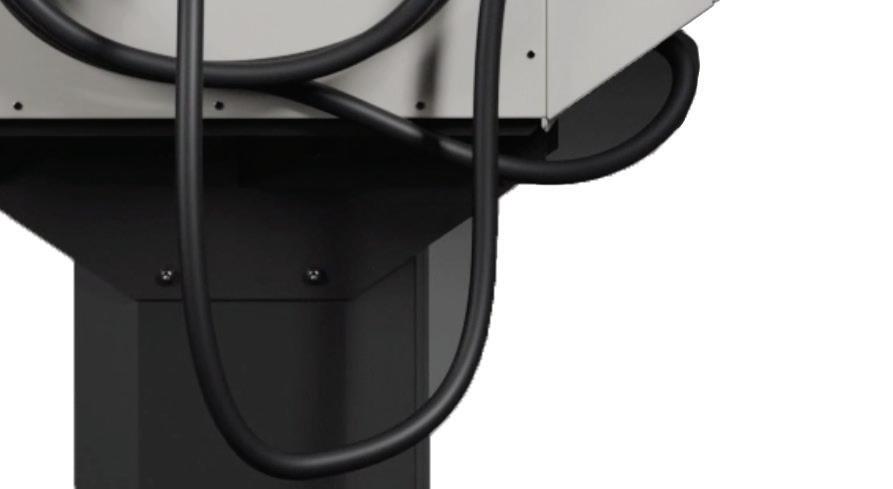
EVSE manufacturer Power Innovations International (Pii) has a solution. e company recently introduced a line of EV chargers that can handle a variety of input voltages, including 240 V single-phase and 208 V/240 V three-phase—all in the same box, without derating the charger. is eliminates the need for step-up transformers and 480 V switchgear, which can translate to big savings of time and money.
Charged spoke with Nick Stone, Pii’s Product and Market Manager.
Q Charged: What’s the origin story behind your new EVFC line of chargers?
A Nick Stone: Pii was started in 1997 as a small business in Utah, and developed a rugged, reliable type of UPS product, focusing on industrial applications. [Taiwanese electronics company] Lite-On acquired Pii in 2013. In the 2020-2021 timeframe, there was an opportunity to complement that business with what Pii can do. Lite-On has a number of Level 2 chargers, but Lite-On didn’t have a Level 3 charger. With DC fast charging, of course, we’re integrating power conversion to convert AC to DC, and that’s one of the core competencies that Pii o ers.
At that time there were a lot of customer comments from some of the incumbents in the DC fast charger space. We listened to some of that feedback and tried to understand what customers were saying about their
chargers. Of course, uptime is certainly imperative, but we wanted to add some other features.
We spent some time around 2022 developing some recti ers that we use across our product lines, and leveraging the same power supply topology that Lite-On uses in the data center space. is gives us one million hours demonstrated MTBF [Mean Time Between Failures, a measure of reliability] within the data center. We wanted to take that same type of power supply topology that’s been demonstrated in mission-critical applications and integrate that into a DC fast charger.
One of the things that our rmware team does is a lot of embedded control. One of the competitors in this space builds a UL 508 A panel where your power supply and power meter are DIN rail-mounted, and you open it up and it’s a maze of wires. We wanted to take all the control and the power conversion that’s doing the auxiliary power and integrate that into one solution that sits on top of our power conversion. We spent some time developing that to where you take AC power coming into our power conversion block, measure the AC power, do all your low-voltage conversion—12, 24 and 48 volts for all the internal power needs and the auxiliary loads—bring that down to our power supplies, bring it back up through the high-voltage line, back through that same controller, and to the CCS1 output.
Q Charged: e low-voltage auxiliary loads are things like the video screen and the user interface?
A Nick Stone: Yes. Our modem, the display, the buttons, the e-stop, the heat exchangers—all of those are coming from a central power supply that’s built in. ere’s no need for a separate DIN rail power supply or a whole bunch of other wiring. Conversion of any type of AC voltage is a core competency that Lite-On has, and we integrated that into our overall design. We don’t have external wires come and go to the power supply, then come out and feed all these loads—we’re doing it all in an integrated, clean solution.
Now, of course, we need an enclosure, we need thermal management, environmental protection, a display, some type of user interface. at’s where we spent some time listening to customers and installer partners. ey were saying, “I don’t like to do lter replacements.” Okay, we will integrate that into our design. We will have a way to do thermal management that requires no maintenance.
We came up with a way, which we have a patent pending on, to accommodate any standard US installation voltage out there. We can do 208, 240 delta, 240 single-phase, 480 delta, 480 wye, all in the same charger.
ey were saying, “I need this thing to be easy to install.” How do we do that? One key is having a very wide space to land your cables, so you can do any type of con guration when you’re doing the installation. With a lot of space, you don’t need tweezers. Even if you’re doing 60 kilowatts, 240 single-phase, for instance, your cable bending space, you could struggle with that during the installation.
at was one of the key messages that we heard. Another was, when we’re in existing infrastructure, they don’t always have 480-volt power available. ey may only have 208, 240 single-phase or delta, so they have to buy a step-up transformer. at’s another pain point that we heard: “I can buy a charger with maybe six months of lead time, but I have to wait two years to get my transformer.” We came up with a way, which we have a patent pending on, to accommodate any standard US installation voltage out there. We can do 208, 240 delta, 240 single-phase, 480 delta [a form of three-phase that doesn’t have a neutral], 480 wye, all in the same charger.
Accommodating the available power can help speed up getting the chargers into the ground. If you’re looking at a hotel or a car dealership or a gas station, they’re probably not going to be installing ten DC fast chargers, so they don’t want to get that additional transformer. In some cases, you would have to pour a pad, get a primary and secondary disconnect, and depending on who owns that station, you might have to get a meter socket to branch o power. ere’s a lot of di erent variables, and we have seen instances where doing that can double your project cost.




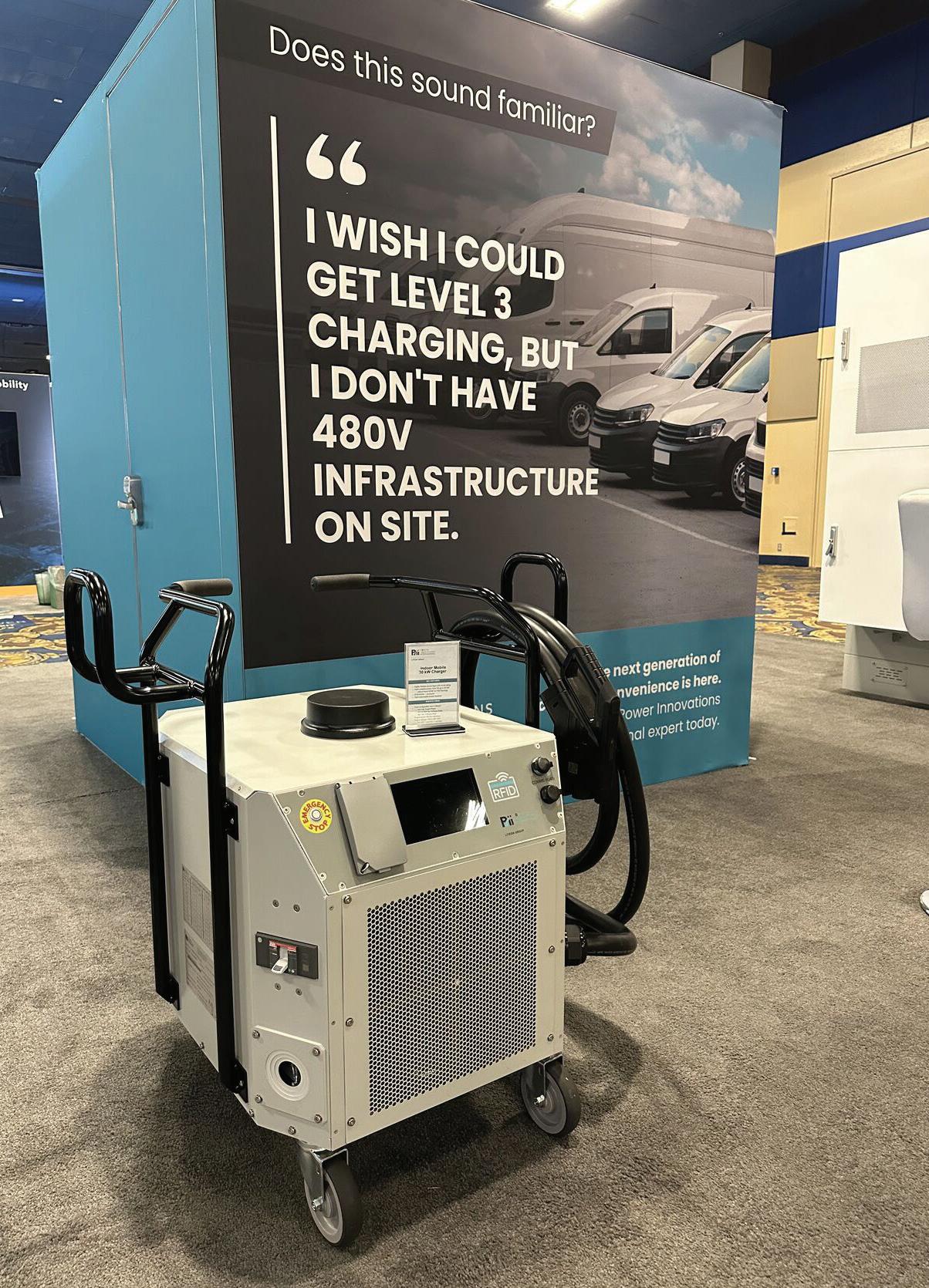
Q Charged: Our Chloe eobald spoke to your Global Sales Manager Tim Rees at the 2024 ACT Expo, and he explained that Pii’s chargers are based on a modular power architecture that can keep them delivering electrons even if individual modules fail.
A Nick Stone: It’s similar to a data center type of architecture. If a power supply goes down, it doesn’t take the rest of the system down. For example, we have nine modules in our 30 kW charger. If one does go down, the other eight are still operational. You’re running at 26.7 kilowatts instead of 30, but your whole station doesn’t go
down. And to replace a power supply, the module slides right in and out in a matter of seconds. Any other type of charger, you have to take that whole 30 or 40 or 50 kW block out, and it’s a pretty serious level of e ort. For us, we ship out another module, you take the top o , there’s a little tab that you pull out, slide another one in, and you’re back up and running at full capacity.
Q Charged: Your chargers can accept not only a wide range of voltages on the input side, but on the output side too, so they can already accommodate the new EVs that are moving to 800-volt systems.
A Nick Stone: Correct. We have the dual drivetrain in our recti er that can do that. Some of the rst Hyundai/Kia 800-volt vehicles out there, we’ve already been charging those for a couple years now. We know that’s where the industry’s heading, because you can lower your current and increase your overall power.
Q Charged: It all seems like a no-brainer. You’ve got a charger that can eliminate the need for a transformer. Why isn’t every EVSE manufacturer o ering that?
A Nick Stone: I’ll say a couple things. One, we’re one of the only ones that are vertically integrated in this space, so we are able to con gure our power supplies to the application that we have. And looking at the power supply topologies that are used in the data center space, we have to have a wide input range to accommodate that market segment. Also, the way we’ve arranged our recti ers within what we call our power shelf is a proprietary arrangement, and that’s something we do have a pending patent on.
Now, there are a few manufacturers that can take a 240 delta input, but you’re derating the amount of power. For instance, if you go to that 30-kilowatt charger, it’s 30 kilowatts if you feed it 480 three-phase. You can apply 240 to it, but you may derate to maybe 22 or 24 kilowatts of power. We’re the only ones that we’ve seen that can take any of those di erent input voltages without derating the amount of power. So, if you buy 30 kilowatts or 60 kilowatts or 120 kilowatts, you get what you bought.

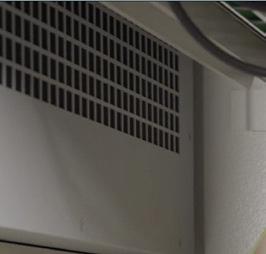

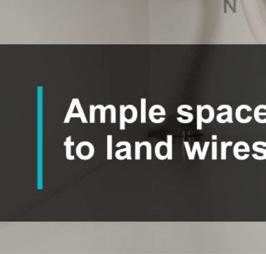


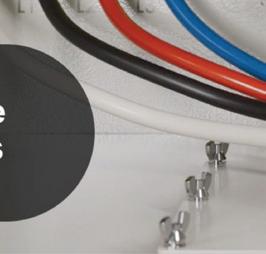

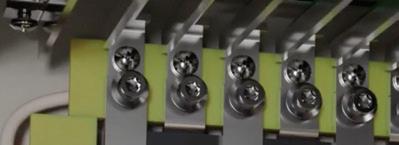
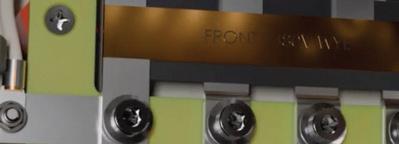
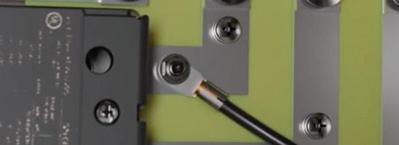
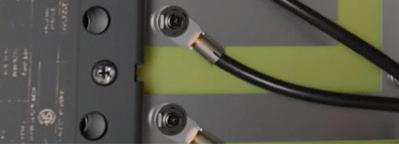
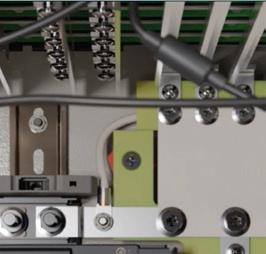
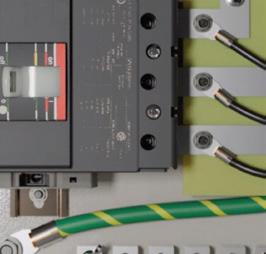
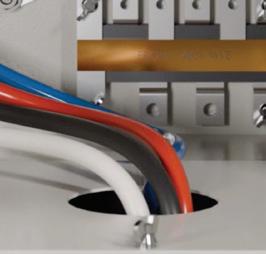
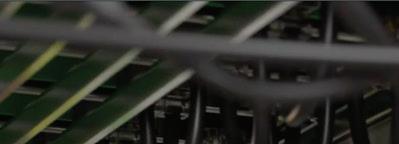




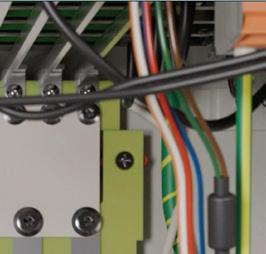

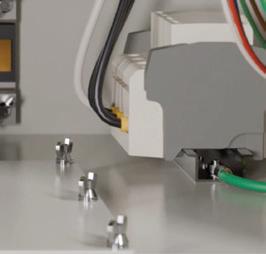

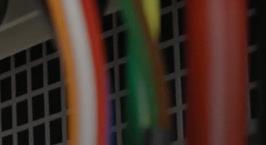



Q Charged: And whoever’s installing the chargers can easily choose the input voltage that they need.
A Nick Stone: Yes. It’s not something you have to do with rmware or anything like that, it’s actually a mechanical way that we do that. Inside of the charger there’s this big open space for ease of installation, and in this area are what we call con gurable busbars. is is something that is smaller than the palm of your hand. It’s a very easy process. All three of these are available in every charger that we sell, so when the electrician or the installer sees what input voltage they have available, they simply pick the appropriate voltage. It’s printed right on the front of the busbar.
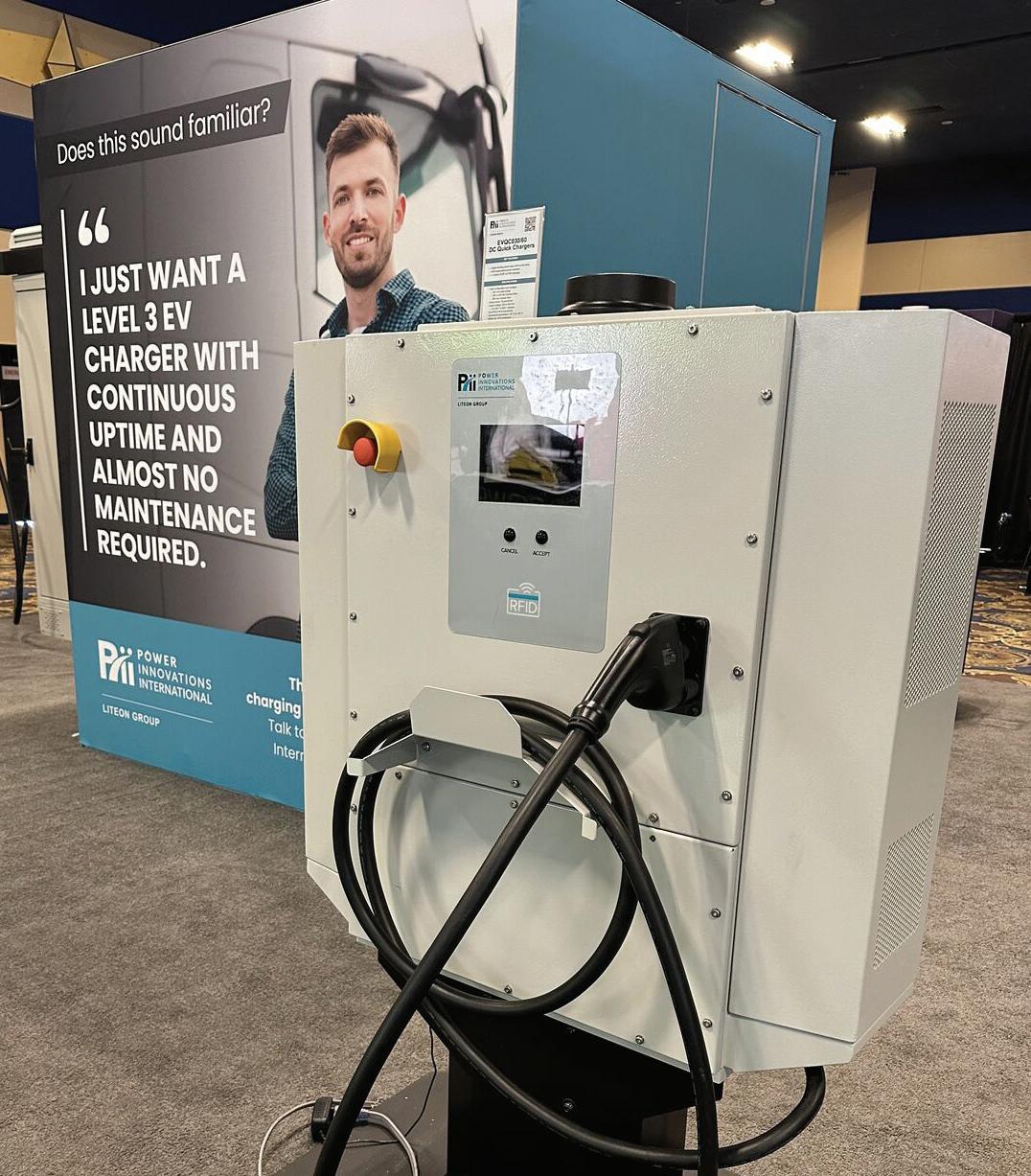
Q Charged: Considering that this can save money and time, and increase reliability, do you foresee that your competitors are going to start doing this too?
A Nick Stone: I think they’ll certainly take notice. When we were at ACT doing our initial market launch of the product, there were a number of competitors that came by to learn about what we’re doing. e way we’ve done it though, I think we have enough protection there for our IP for them not to do it the same way, and it will then take another couple years for them to do it a little bit di erently.
Q Charged: So you’ve got a rst-mover advantage that’s going to last you for a couple years, hopefully.
A Nick Stone: We believe so, yes. ere’s one additional feature that I haven’t mentioned yet. Our standard recti er today uses AC input voltages, but it is capable of taking a DC input voltage as well, so we can now take inputs from a battery source or a hydrogen fuel cell input. So, we’re looking at these other applications—if you’re in the portable power space serving applications such as events or movie studios, those are some of the additional applications that we are working with partners to expand the application set, because we can do DC input.


Advance Your Competitive Edge in EV Technology Join the Engineers Defining the Future of Electric Mobility
Anaheim, CA | June 18-20, 2025
TEC+EATS mobility
esearchers,
ITEC+EATS 2025 delivers high-impact content designed for engineers, researchers, and technical managers working on the most critical challenges in electric mobility.
With reduced federal funding, this conference serves as a targeted investment in upskilling, technical alignment, and strategic growth.
Conference Takeaways:
– Critical updates on EV power train design, battery systems, and charging infrastructure – Exposure to pre-commercial research and emerging standards – Access to DOE, Tier 1, and OEM insights that inform product and investment strategies – Workshops and technical sessions offering hands-on value, not just theory – Ideal for engineers tasked with knowledge transfer to leaner teams
Register at ITEC-Conf.com
Early registration discounts available through May 1, 2025
IEEE Members and Student Rates Available
Sponsored by:










By Charles Morris
Dear readers, I have a confession to make: for years, I poo-pooed the concerns of the EV-curious about public charging. “Bah!” said I, “You charge at home. I’ve never needed to use a public charger.” I was sensitive to the Plight of the Drivewayless (about which I’ve written extensively), but callously dismissed the Plight of the Road-Tripper.
For years, our daily driver was a 2015 LEAF with a 100mile range, which was quite su cient for trips around town. We had no DC fast charging feature, and didn’t need it—for longer road trips, my wife and I simply took the Prius.
However, a shameless homewrecker called Hurricane Helene convinced us to move to a new locale farther inland, and as road trips became a part of our lifestyle, we traded up to a 2021 Hyundai Kona Electric. I got a crash course in public fast charging, and I now feel the pain in the tuchuses of those forced to charge on the road.
I’ll spare you the horrors of my rst couple of EV road trips (and the colorful language they inspired), and sum up the bad news thus: a cross-country road trip in the 21st century is not as simple as it was in Kerouac’s gasoline-redolent day. It requires planning, and it simply takes longer. e good news: it gets easier with experience, and can even be kind of fun, like solving a challenging puzzle.
Plan your drive and drive your plan. Map out your route, and pick the best places to charge along the way. Make sure you have an app on your phone for every charging network you might use, and log into each one before you leave home. You also need the route planner apps Plugshare, ChargeHub and/or Chargeway. Check the driver comments to see if others have recently had problems at the stations you plan to visit (and leave your own comments a erwards, to help others).
Remember the Golden Rule of Public Charging: You can never count on being able to use any particular public charger—it may be occupied, out of order, ICEd out or inaccessible, so always have an alternate charging site scoped out as a fallback.
Seasoned road-trippers never ll ‘er up—they try to charge from around 20% to around 80% in order to minimize wait times (DC chargers slow down above an 80% State of Charge). However, there’s a problem with this, especially in regions where stations are scarce: if your chosen station is down, you may have to divert to another, so you’ll sometimes need to have more than a 20% cushion.
Learn to interpret your guess-o-meter. Your EV’s realworld range may be less than what it says on the display, especially in highway driving—a little experience will teach you how to translate. I learned that, at 80 mph, my Kona’s actual range is about 20% less than the stated range. is

led to another revelation: driving slower (70 instead of 80) extends e ective range, and may actually get you there faster by eliminating the need for another charging stop. Seek out the best sites. Over time, you’ll learn which stations along your usual routes are the best (uncrowded, easy to get to, with your preferred amenities nearby), and which ones stink. My favorite is one of a network run by local utility FPL. It’s precisely 100 miles from my house, it’s never crowded, charging starts with two button presses on the app, and there’s a good co ee shop with outdoor tables, at one of which I am sitting as I write this essay. Another tip: use your waiting time to catch up on work instead of cussing at the clock or playing stupid games.
Get rid of the damn apps! Every CPO has its own app, each one works di erently, and some simply don’t work very well at all. e sooner everyone implements Plug & Charge, the better. I’ve been told that some CPOs are resisting enabling roaming, because they want to “own” their customers. I assure you, making your service easier to use will bring you far more bene ts than whatever it is you plan to do with your proprietary data.
Do something about those pesky 100-percenters. Busy stations are plagued by drivers who insist on sitting there staring at their phones long a er they’ve reached 80%. Some have suggested that CPOs add additional fees for charging over 80%. I agree, but I believe most newbie EV drivers are ignorant of the 80% rule, so charging apps need to make it quite clear when the extra fees kick in.
What about reliability? Yes, it is a scandal—we hear plenty of horror stories—but I get the sense that it’s getting better. More than once I’ve had to call a CPO’s hotline to get them to remotely initiate charging, and I have diverted from planned charging stops a er reading on Plugshare that chargers were down, but I haven’t yet had an actual failure to charge.
Once you learn the ropes, you may nd that stopping to charge isn’t so bad—I enjoy chatting with other EV drivers, and seeing the vast variety of EV models that now ply the roads. My most interesting sighting so far: a Gillig electric bus plugged in at an Electrify America station on its way from the manufacturer’s California plant to begin service for PSTA in St Petersburg, Florida. e driver told me that each charging stop can take hours, and the cross-country run takes eight to nine days. What do I have to complain about?



grid:
infrastructure: $$$,$$$
wait: 12-36 months
permits: 3-6 months

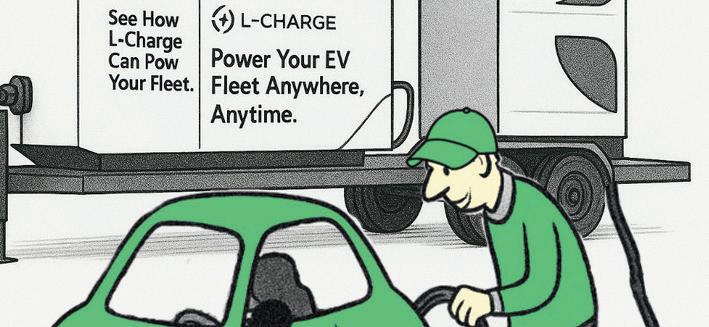




Infrastructure: 0 wait: 0
permits: 0





L-Charge provides above ground ultra-fast EV charging as a service, enabling fleet operators to electrify without adding or upgrading grid infrastructure. Our mobile chargers run on clean fuels, enabling flexibility and rapid deployment wherever power is needed. Ideal for hard-to-electrify locations, including depots, truck stops, or temporary event sites. Customers pay per kWh delivered, avoiding the capital expense, complexity, and delays of traditional charging infrastructure. deployment wherever power is needed. Ideal


www.l-charge.net
+1 408 598 1950



info@l-charge.net

